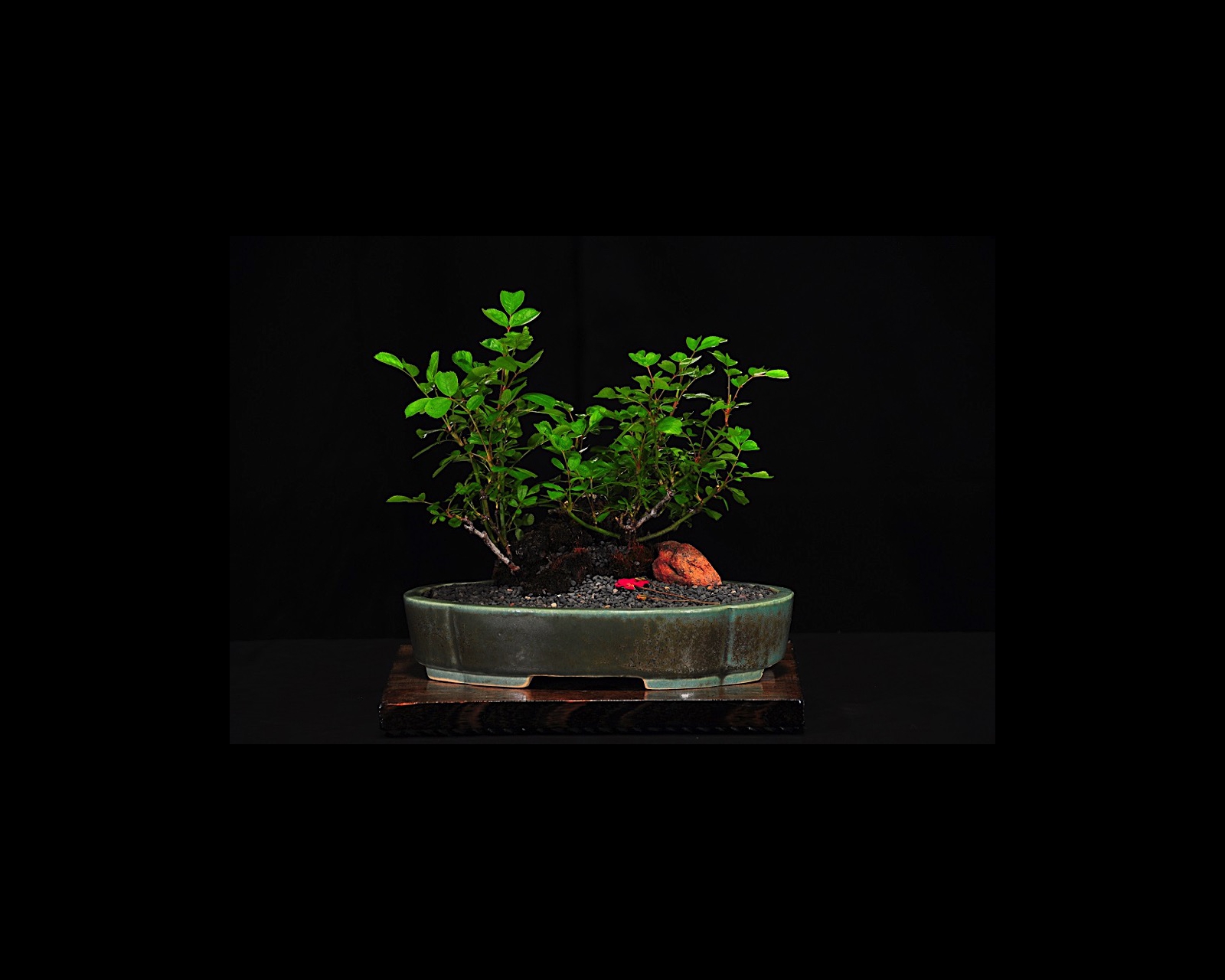 (Rosa sp) Age 71 yrs, Trained since 1974. This is possibly a floribunda rose but its provenance is unknown. This plant was collected as a gift from my Grandmother's garden in 1974 when she learned I was interested in bonsai. 'It's never done any good in my garden' she said. When I dug it out I found she had unknowingly planted it on a hidden lump of old builder's concrete. My grandmother was thrilled when it became a bonsai that flowered with tiny orange/red roses. It is pruned as a rose should be and has a significant stump which demonstrates its age.
(Rosa sp) Age 71 yrs, Trained since 1974. This is possibly a floribunda rose but its provenance is unknown. This plant was collected as a gift from my Grandmother's garden in 1974 when she learned I was interested in bonsai. 'It's never done any good in my garden' she said. When I dug it out I found she had unknowingly planted it on a hidden lump of old builder's concrete. My grandmother was thrilled when it became a bonsai that flowered with tiny orange/red roses. It is pruned as a rose should be and has a significant stump which demonstrates its age. 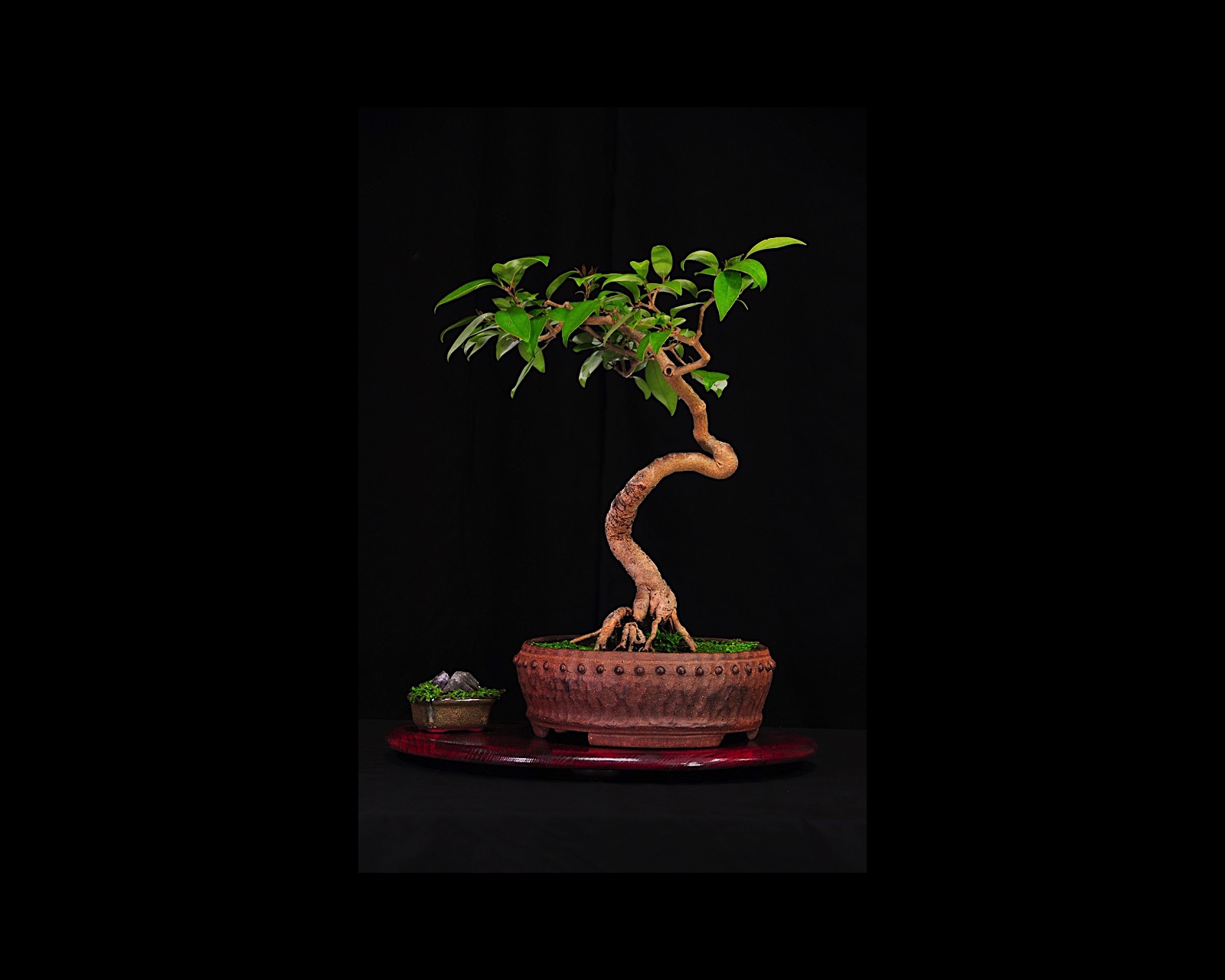 (Ligustrum lucidum) Age of tree 41 years, Trained since 1976. This plant was collected in 1976 from my garden with a naturally curved trunk that formed as the seedling emerged from the ground and made its way between large autumn leaves. Over the years the roots have been partially exposed to reveal the look of the fingers of a hand. It was tip pruned as it grew to maintain emphasis on the trunk and to live up to its name 'Hand of Fate'. It could have so easily been thrown away as a weed.
(Ligustrum lucidum) Age of tree 41 years, Trained since 1976. This plant was collected in 1976 from my garden with a naturally curved trunk that formed as the seedling emerged from the ground and made its way between large autumn leaves. Over the years the roots have been partially exposed to reveal the look of the fingers of a hand. It was tip pruned as it grew to maintain emphasis on the trunk and to live up to its name 'Hand of Fate'. It could have so easily been thrown away as a weed.
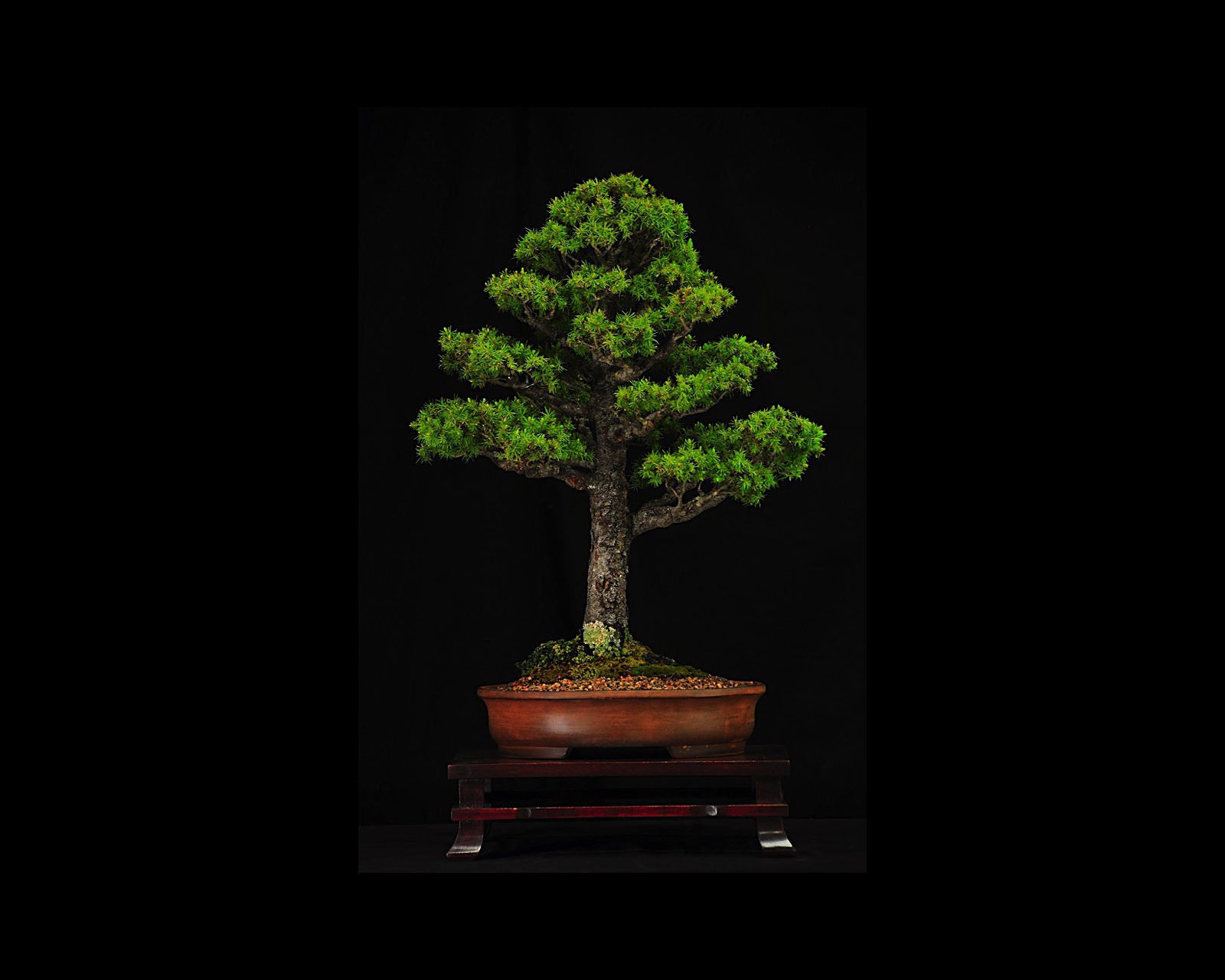 (Picea glauca var. albertiana 'Conica'). Picea glauca var. albertiana 'Conica'. Age of tree 41 years, Trained since 1980. When I started bonsai in 1980, I liked classical 'formal upright' trees. This species is perfect material for that style and although not an exciting tree, this one is 'family' after being in my care for 37 years.
(Picea glauca var. albertiana 'Conica'). Picea glauca var. albertiana 'Conica'. Age of tree 41 years, Trained since 1980. When I started bonsai in 1980, I liked classical 'formal upright' trees. This species is perfect material for that style and although not an exciting tree, this one is 'family' after being in my care for 37 years.
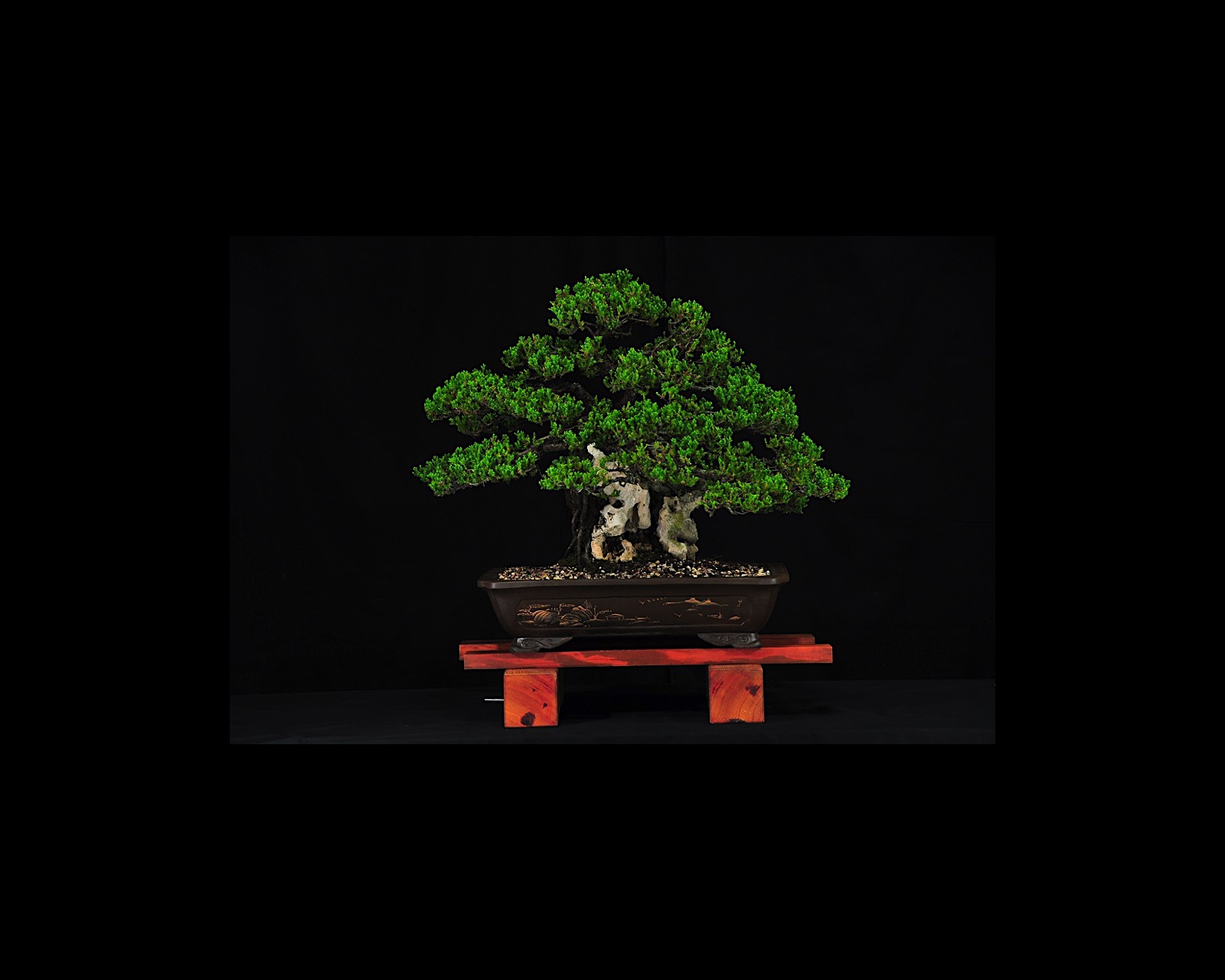 (Juniperus procumbens 'Nana'). Age of tree 37 years. Trained since 1984. This tree was grown from a cutting and was planted on the rock, which is limestone from Marmion, Western Australia.
Junipers are lime loving plants suited to limestone.
(Juniperus procumbens 'Nana'). Age of tree 37 years. Trained since 1984. This tree was grown from a cutting and was planted on the rock, which is limestone from Marmion, Western Australia.
Junipers are lime loving plants suited to limestone.
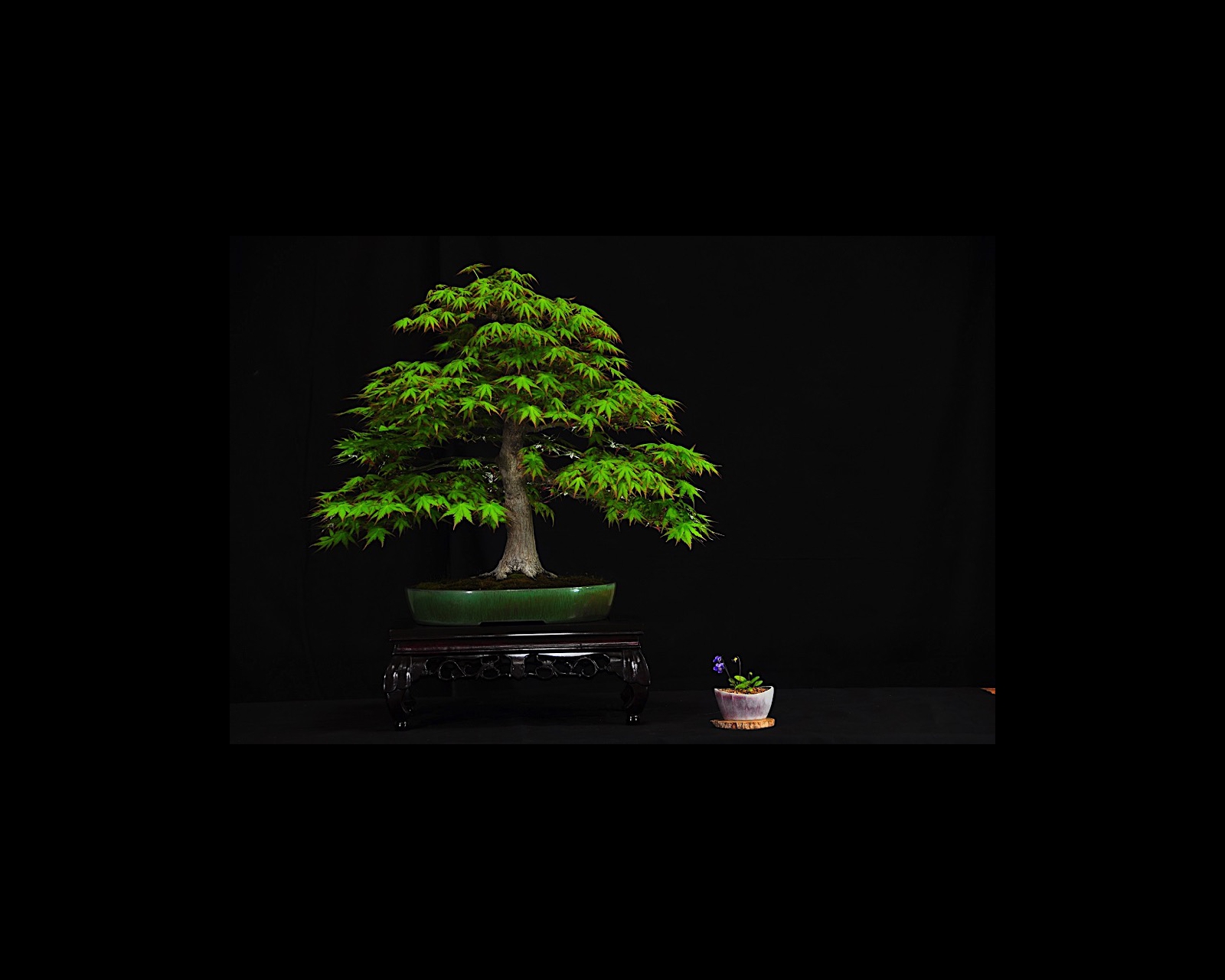 (Acer palmatum) Age of tree 32 years. Trained since 1986. This tree is one of a number of Japanese maples collected as seedlings in 1985, with styling started the following year. The tree was grown in various training pots until fairly mature as a bonsai, and was then potted into a bonsai pot in 2003.
(Acer palmatum) Age of tree 32 years. Trained since 1986. This tree is one of a number of Japanese maples collected as seedlings in 1985, with styling started the following year. The tree was grown in various training pots until fairly mature as a bonsai, and was then potted into a bonsai pot in 2003.
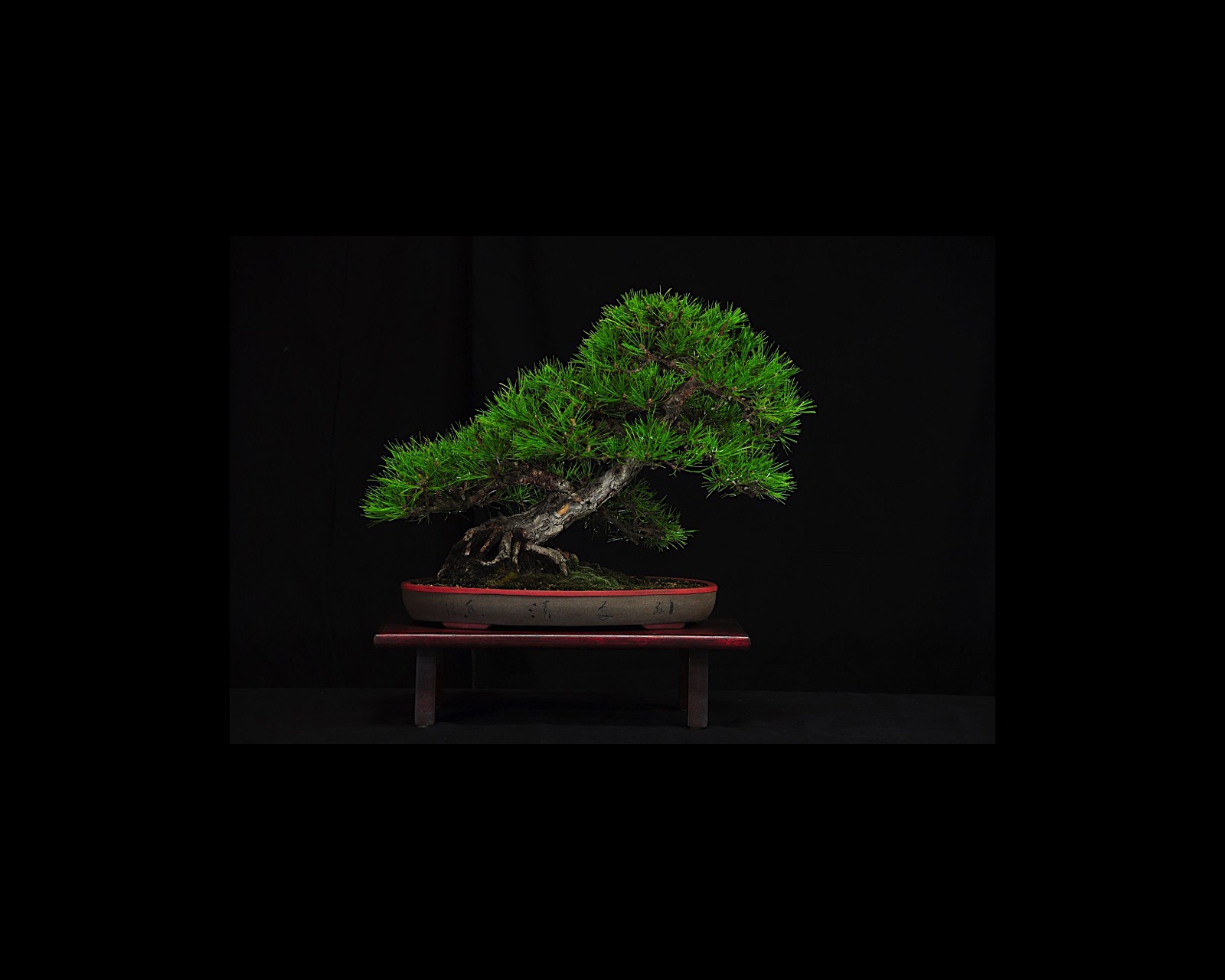 Pinus ponderosa Age of tree 37 years. Trained since 1986. This tree was collected as a wild seedling in the Pierces Creek pine plantation near the Cotter in 1985. At that time, it was estimated to be five years old. The species is unknown but it is likely a Pinus ponderosa - Western yellow pine as it was growing near a plantation of these. Other opinion says it could be a Pinus heldrechii - Bosnian pine.
Pinus ponderosa Age of tree 37 years. Trained since 1986. This tree was collected as a wild seedling in the Pierces Creek pine plantation near the Cotter in 1985. At that time, it was estimated to be five years old. The species is unknown but it is likely a Pinus ponderosa - Western yellow pine as it was growing near a plantation of these. Other opinion says it could be a Pinus heldrechii - Bosnian pine.
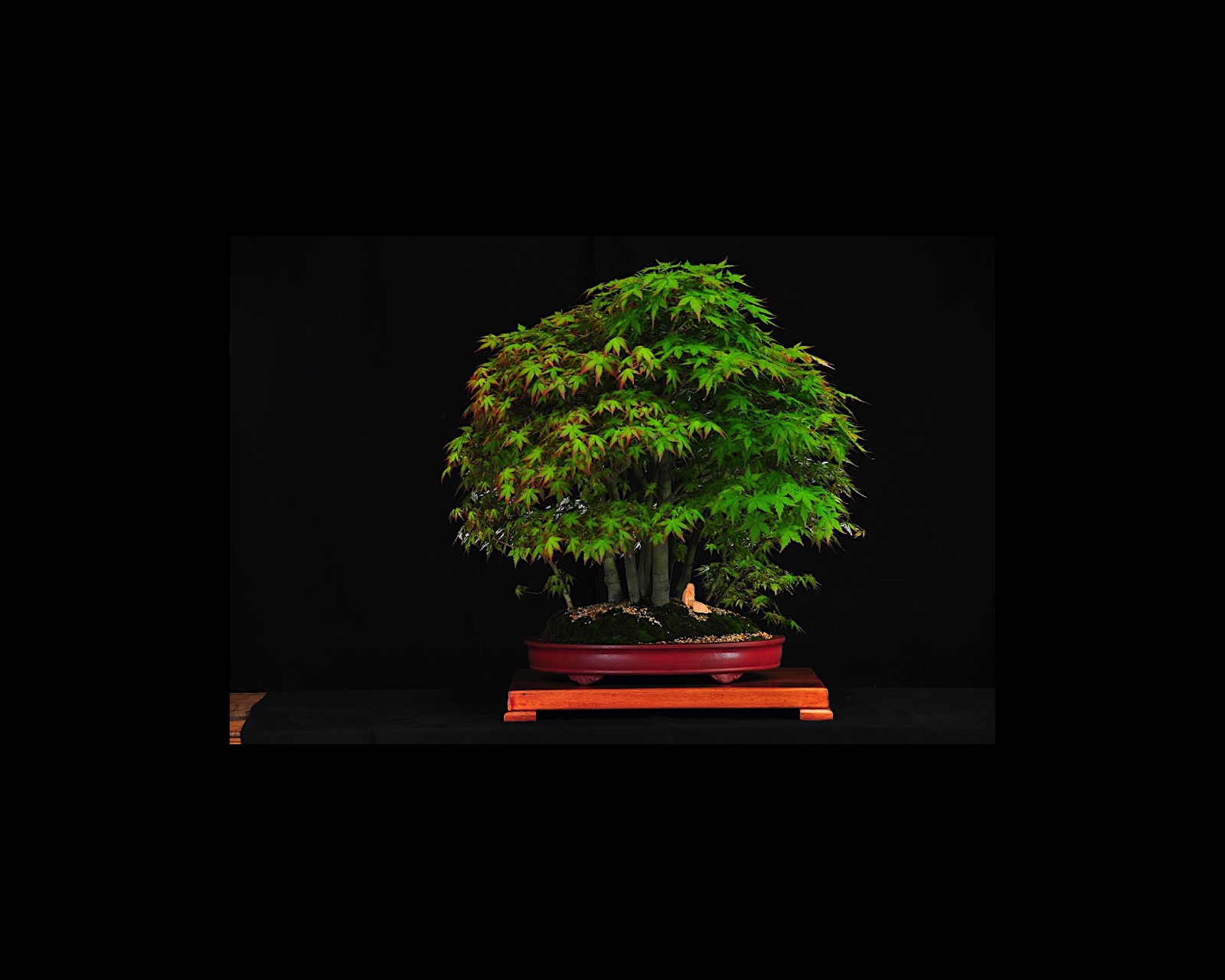 Acer palmatum. Age of tree Unknown. Trained since 1987. This forest was developed from a series of seedlings given to me by a neighbour as he was weeding. They were left to grow in separate pots for some years before being put into a group where they have developed together. A small tree was added in 2017 to improve the visual balance.
Acer palmatum. Age of tree Unknown. Trained since 1987. This forest was developed from a series of seedlings given to me by a neighbour as he was weeding. They were left to grow in separate pots for some years before being put into a group where they have developed together. A small tree was added in 2017 to improve the visual balance.
 Juniperus chinensis 'Shimpaku'. Age of tree 19 years. Trained since 1988. The curving base and the lines of the cascading branch are very pleasing. I grew this tree in a black plastic pot for 4-5 years before it was ready for a bonsai pot.
Juniperus chinensis 'Shimpaku'. Age of tree 19 years. Trained since 1988. The curving base and the lines of the cascading branch are very pleasing. I grew this tree in a black plastic pot for 4-5 years before it was ready for a bonsai pot.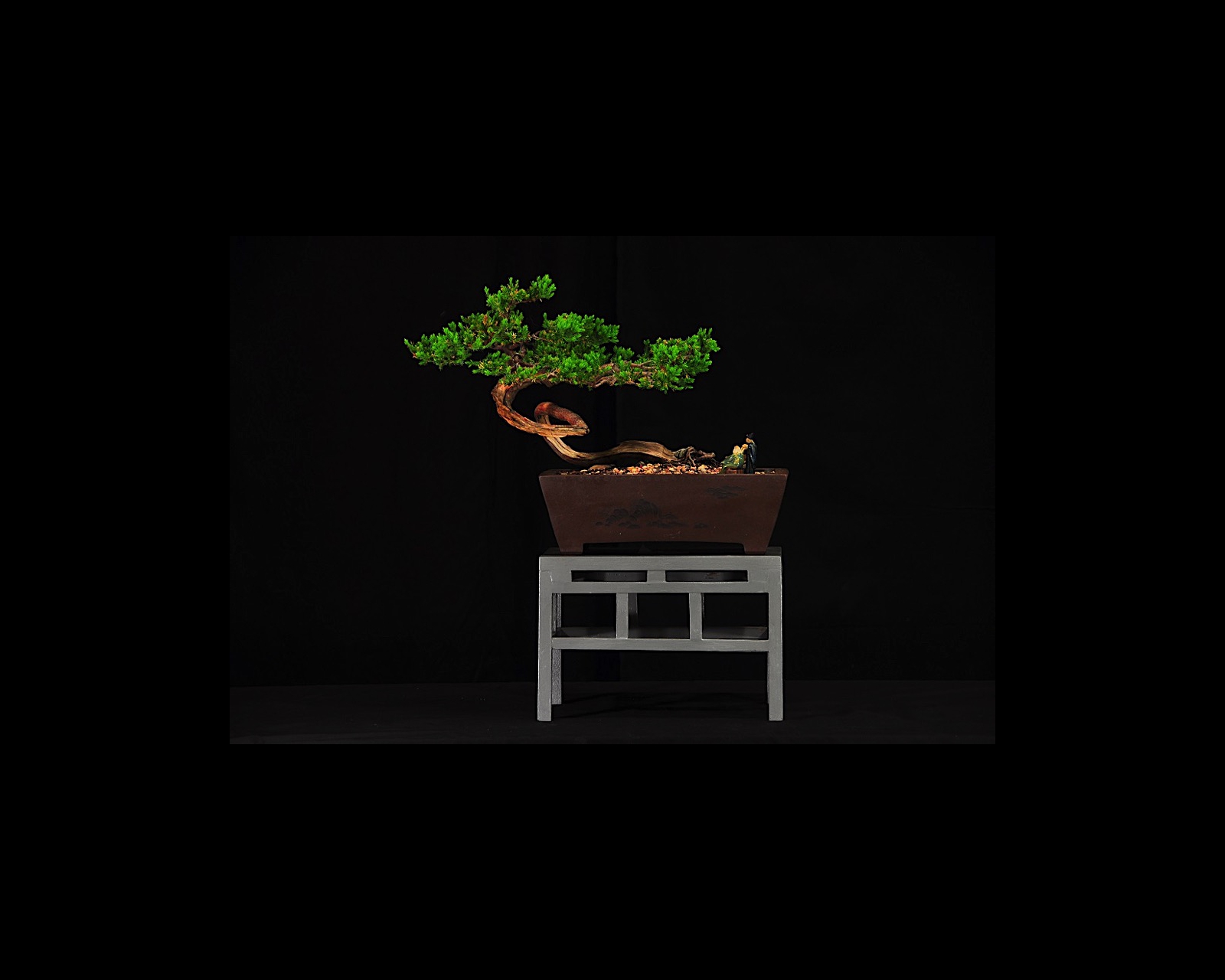 Japanese garden juniper. Juniperus procumbens. Age of tree-More than 40 years. Trained since 1989. This Chinese penjing setting was created from large trained juniper which developed root rot that entered the tree, finally rotting the whole structure away. The live vein was saved and new growth developed. The tree trunk was slowly bent over many months, one bend at a time using foam padding and heavy gauge wire fastened with plastic ties. The process is slow so as to not place too much stress on the tree. It is now developing nicely and it is hoped that by January next year it will be selected for photographic entry in China. The three Chinese figurines represent are placed so as to represent scale and the deep old container shows the tree high on a mountain
Japanese garden juniper. Juniperus procumbens. Age of tree-More than 40 years. Trained since 1989. This Chinese penjing setting was created from large trained juniper which developed root rot that entered the tree, finally rotting the whole structure away. The live vein was saved and new growth developed. The tree trunk was slowly bent over many months, one bend at a time using foam padding and heavy gauge wire fastened with plastic ties. The process is slow so as to not place too much stress on the tree. It is now developing nicely and it is hoped that by January next year it will be selected for photographic entry in China. The three Chinese figurines represent are placed so as to represent scale and the deep old container shows the tree high on a mountain
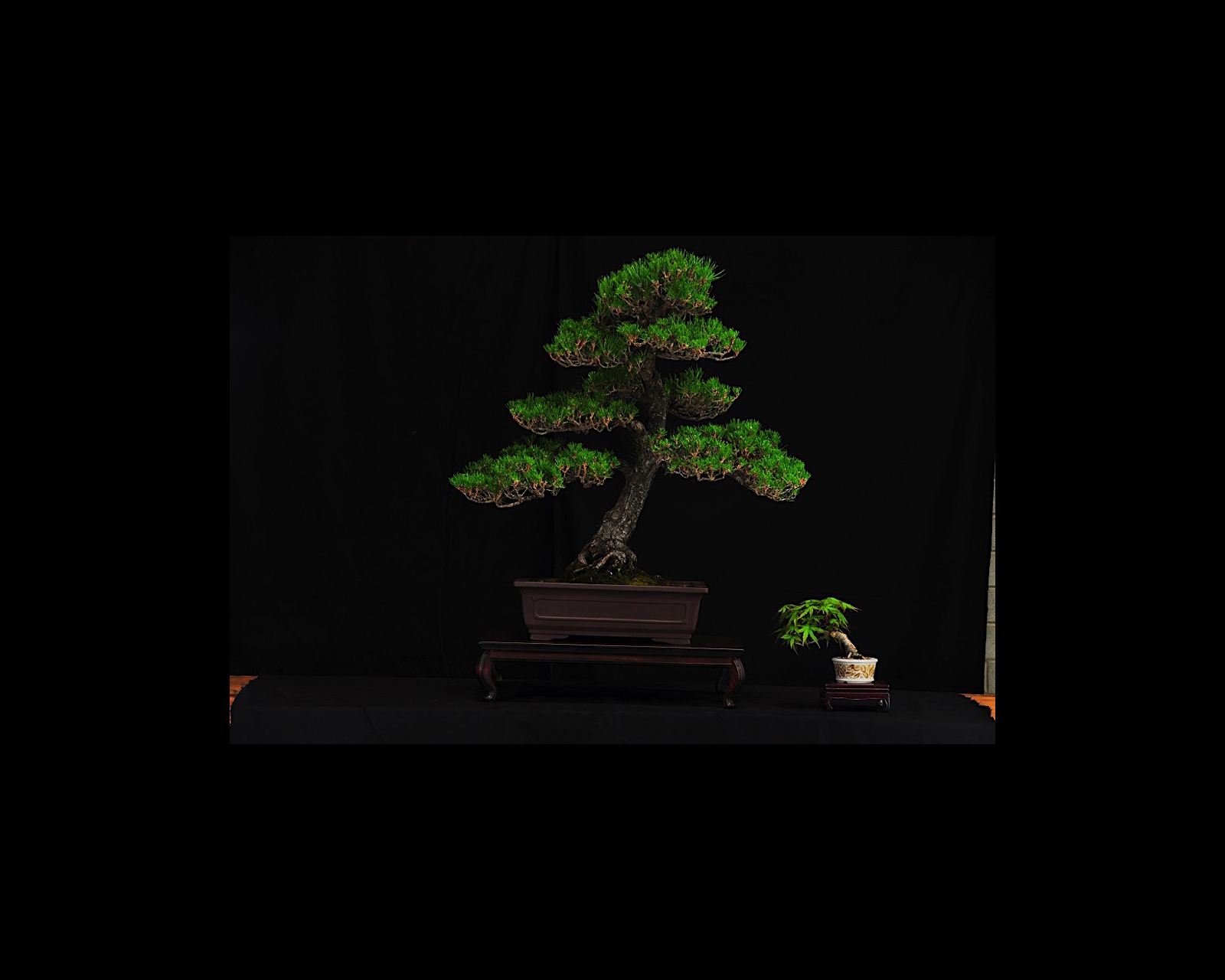 Japanese black pine. Pinus thunbergii. Age of tree 37 years. Trained since 1991. The Japanese black pine is regarded as iconic bonsai material. This tree was purchased as mature nursery stock from the Weston Creek Bonsai Group show in 1990, and was much taller. In 1991 it was styled at a workshop with American bonsai artist, Jim Barrett, when it was reduced to its current height. The tree has been intensively restyled in recent years and now looks very different to that original styling.
Japanese black pine. Pinus thunbergii. Age of tree 37 years. Trained since 1991. The Japanese black pine is regarded as iconic bonsai material. This tree was purchased as mature nursery stock from the Weston Creek Bonsai Group show in 1990, and was much taller. In 1991 it was styled at a workshop with American bonsai artist, Jim Barrett, when it was reduced to its current height. The tree has been intensively restyled in recent years and now looks very different to that original styling.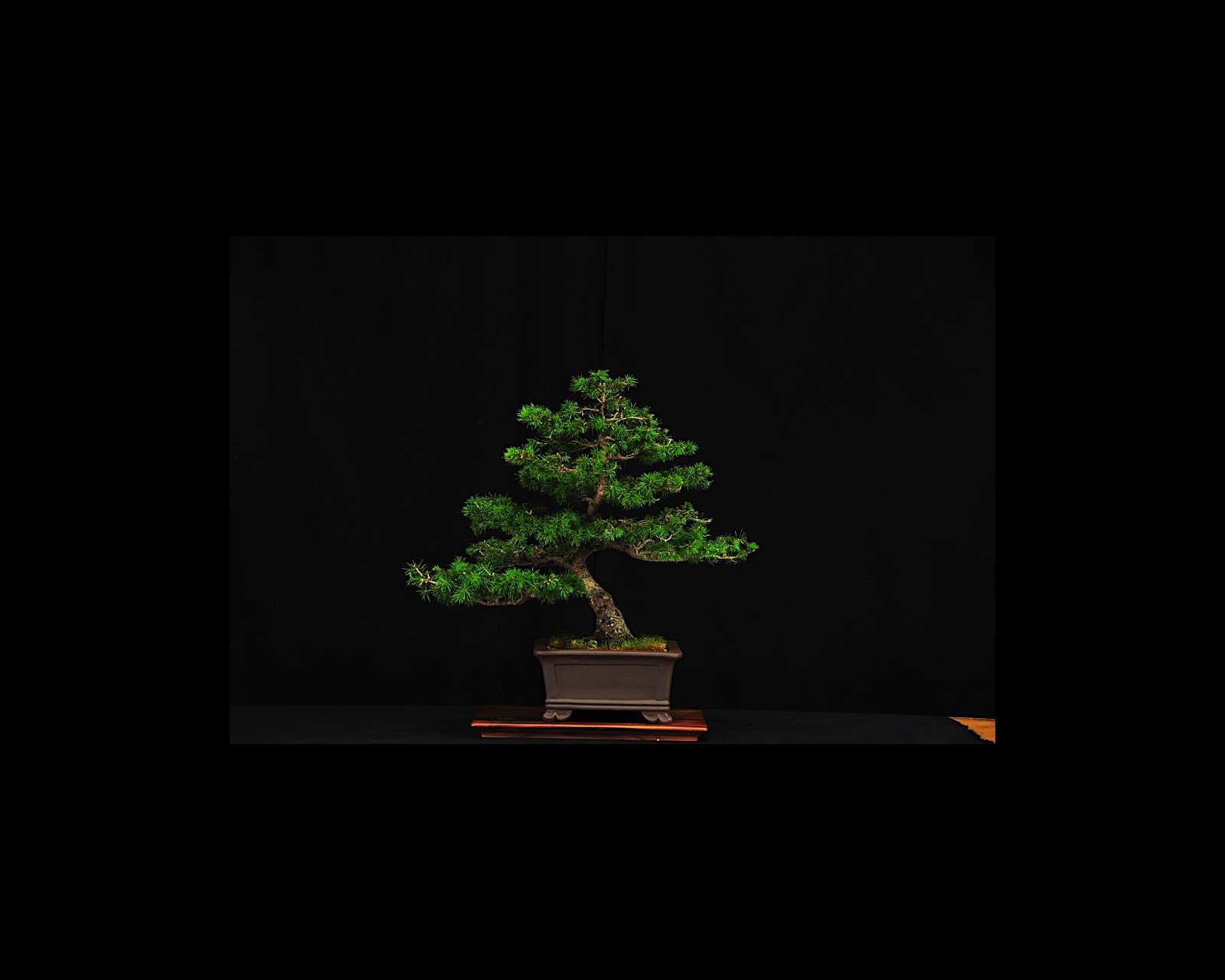 Picea sp.. Age of tree 25 years. Trained since 1992. The plant was bought in 1992 and the training was started the same year. However, in 1997, I decided to restyle it. Since then its style has been maintained, with some yearly modifications.
Picea sp.. Age of tree 25 years. Trained since 1992. The plant was bought in 1992 and the training was started the same year. However, in 1997, I decided to restyle it. Since then its style has been maintained, with some yearly modifications.
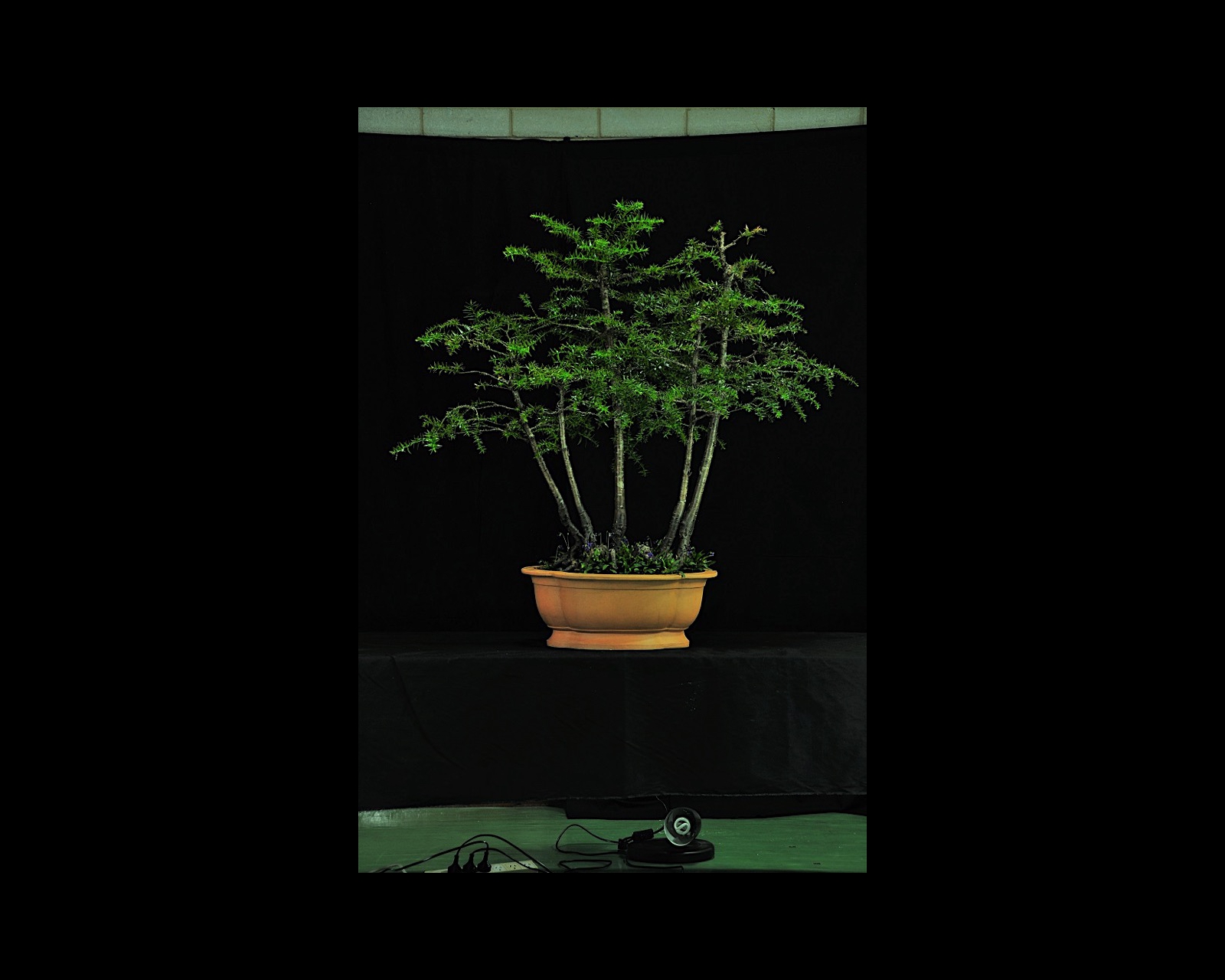 Araucaria bidwillii. Age of tree - Approx 25 yearsTrained since 1992. This is the first year this tree has been exhibited. It was acquired as a stock plant from Bonsai World, Jilliby and is designed as a faux raft style group planting. Unlike a true raft setting, where there is only one three, in this case all are separate trees. My inspiration was "Gondwana", and particularly the ancient Huon pine tree in Tasmania, and also the enduring Hoop-pine groves of Magnetic Island in Queensland.
The leaves of this species can brown in scorching sun and heavy frosts. Although hardy, the tree appreciates regular water in summer, but is quite tolerant of occasional missed watering.
My design challenge is to work out refinement of branches, how to design species' apex, and learn how to prevent spindly branches and encourage back-budding.
Araucaria bidwillii. Age of tree - Approx 25 yearsTrained since 1992. This is the first year this tree has been exhibited. It was acquired as a stock plant from Bonsai World, Jilliby and is designed as a faux raft style group planting. Unlike a true raft setting, where there is only one three, in this case all are separate trees. My inspiration was "Gondwana", and particularly the ancient Huon pine tree in Tasmania, and also the enduring Hoop-pine groves of Magnetic Island in Queensland.
The leaves of this species can brown in scorching sun and heavy frosts. Although hardy, the tree appreciates regular water in summer, but is quite tolerant of occasional missed watering.
My design challenge is to work out refinement of branches, how to design species' apex, and learn how to prevent spindly branches and encourage back-budding.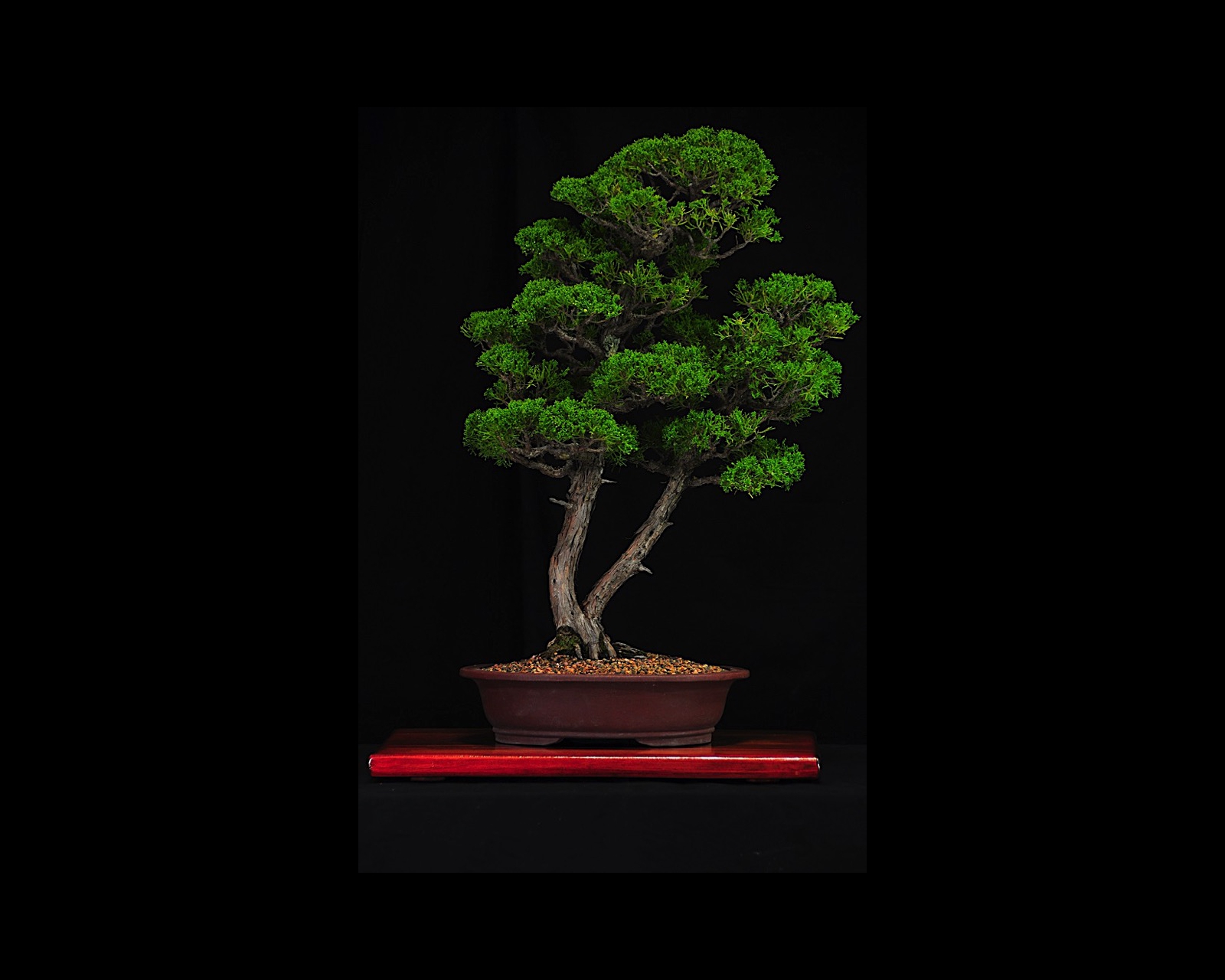 Juniperus chinensis 'Shimpaku'. Age of tree 37 years. Trained since 1993.
I was given this as tube stock in 1982, about the time Shimpaku first became available in Australia. Sometimes I am tempted to wire and position all the branches into a more immaculate, stylised shape but I rather like its informal character. More than I like wiring!
Juniperus chinensis 'Shimpaku'. Age of tree 37 years. Trained since 1993.
I was given this as tube stock in 1982, about the time Shimpaku first became available in Australia. Sometimes I am tempted to wire and position all the branches into a more immaculate, stylised shape but I rather like its informal character. More than I like wiring!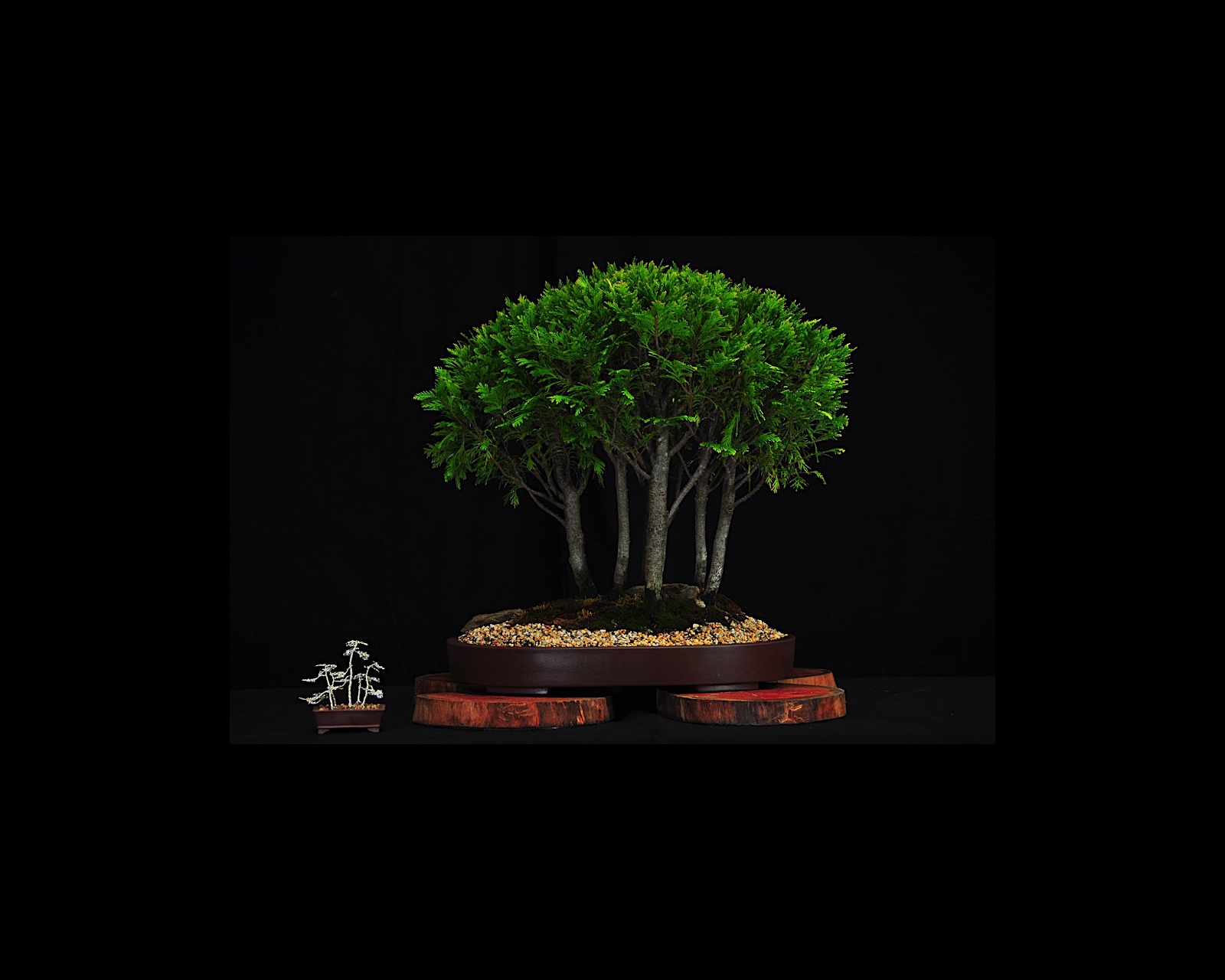 Platycladus orientalis . Age of tree Unknown. Trained since 1994. This forest was constructed from cuttings of a garden specimen, taken out of curiosity rather than specially for a bonsai forest. A surprising number grew and were neglected for years until their possibility as a forest jumped out at me. Thuja forests are not common and presented an interesting change from other forests I had attempted and seen. The form is basically a series of broom style trees giving the impression of a thick forest forcing the trees to grow tall and straight.
Platycladus orientalis . Age of tree Unknown. Trained since 1994. This forest was constructed from cuttings of a garden specimen, taken out of curiosity rather than specially for a bonsai forest. A surprising number grew and were neglected for years until their possibility as a forest jumped out at me. Thuja forests are not common and presented an interesting change from other forests I had attempted and seen. The form is basically a series of broom style trees giving the impression of a thick forest forcing the trees to grow tall and straight.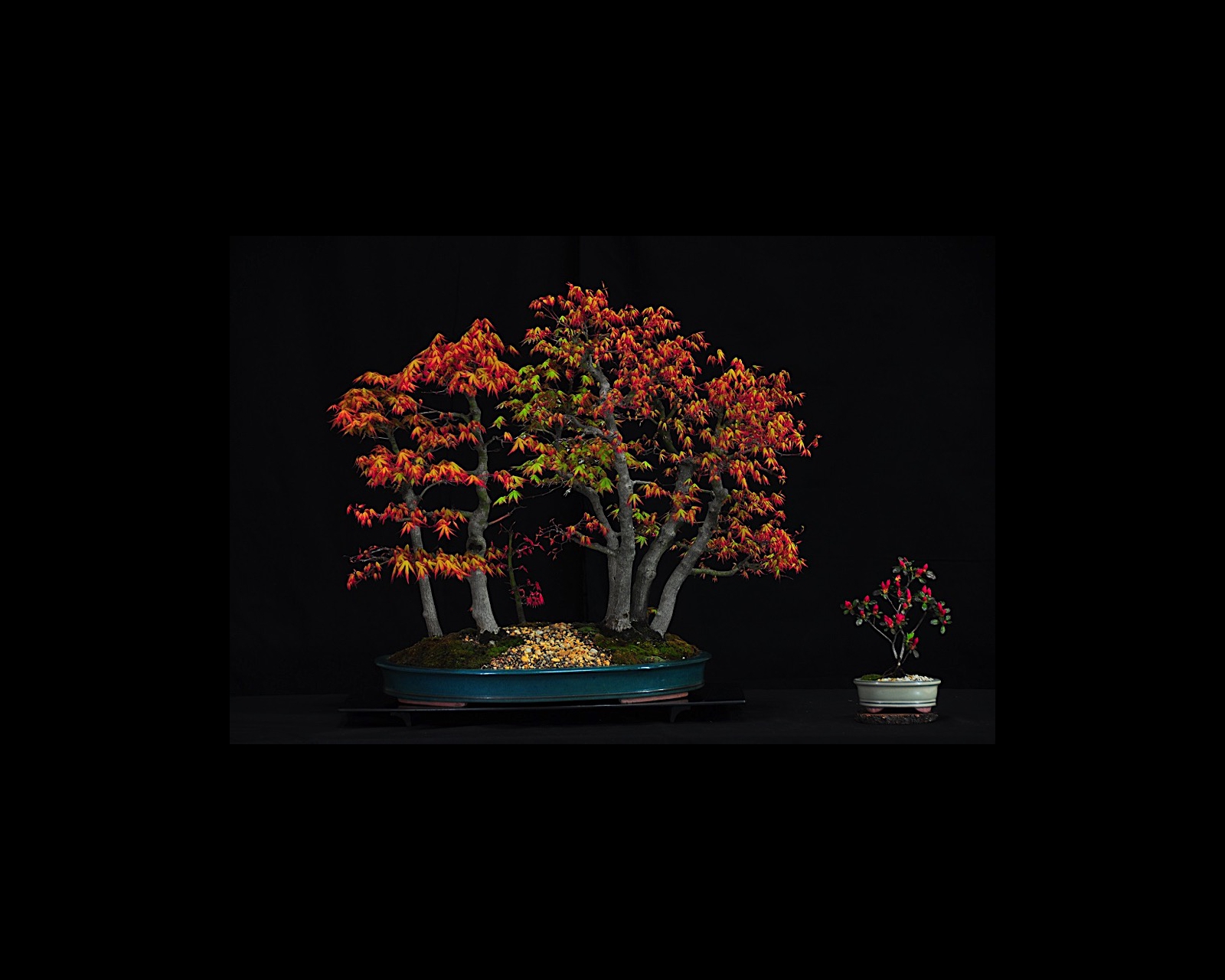 Acer palmatum. Age of tree Unknown. Trained since 1994. The setting was bought in 1994 as a group with five trees. I transferred the group into a larger pot, adding three more trees and the back one was replaced with a smaller tree. In 2014 two seedlings self-seeded at the back of the forest and I left them in place.
Acer palmatum. Age of tree Unknown. Trained since 1994. The setting was bought in 1994 as a group with five trees. I transferred the group into a larger pot, adding three more trees and the back one was replaced with a smaller tree. In 2014 two seedlings self-seeded at the back of the forest and I left them in place.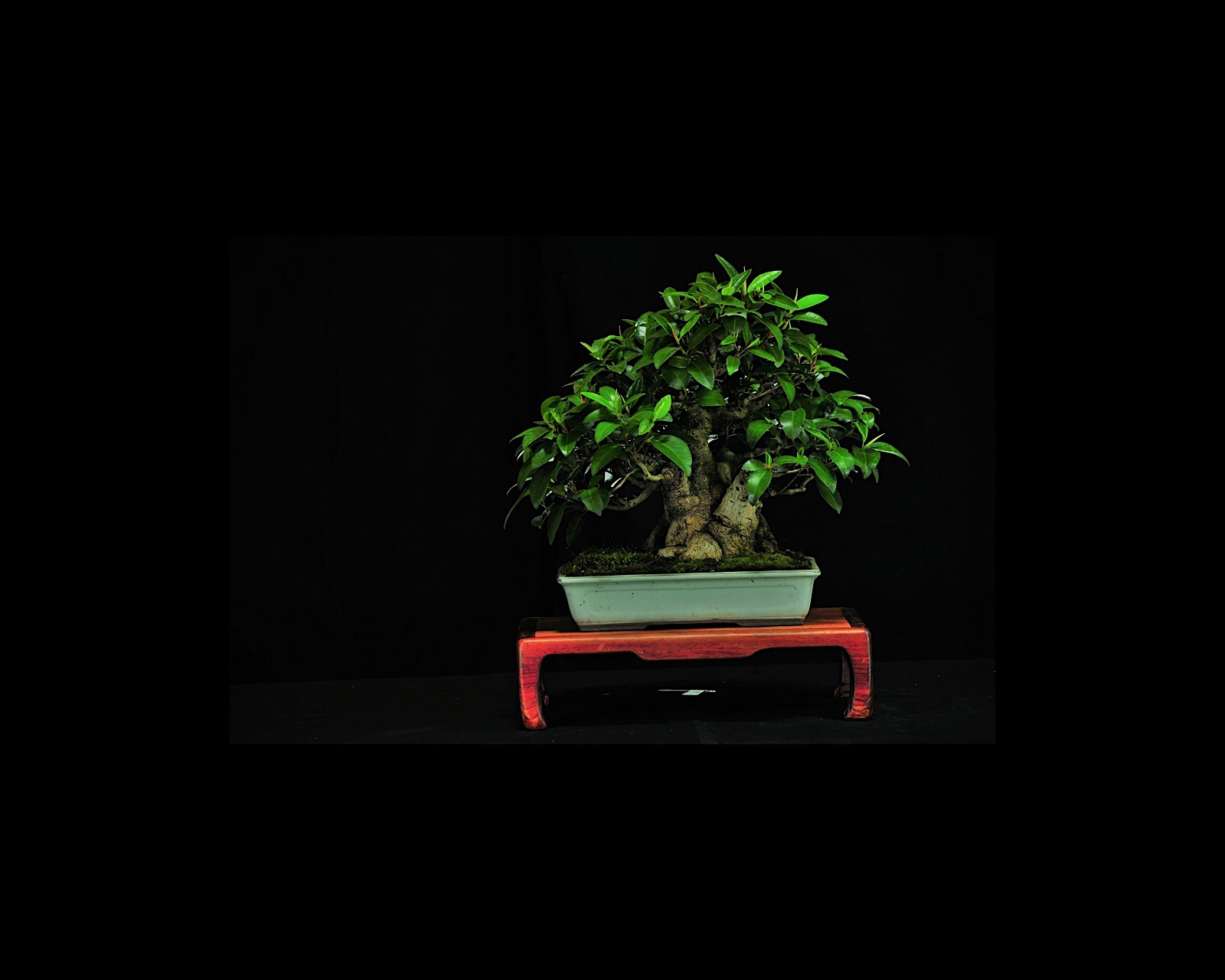 Ficus rubiginosa. Age of tree 30 years.Trained since 1995. Two seedlings were planted close together to form a twin trunk tree. As they grew the two trunks have merged into a single tree. This bonsai was grown in a small pot right throughout development to keep scarring to a minimum.
Ficus rubiginosa. Age of tree 30 years.Trained since 1995. Two seedlings were planted close together to form a twin trunk tree. As they grew the two trunks have merged into a single tree. This bonsai was grown in a small pot right throughout development to keep scarring to a minimum. Maidenhair tree. Gingko bilobaAge of tree - 35 years. Trained since 1996
Its lovely lime green new leaves in spring and golden autumn colours make gingko a very desirable bonsai but they are very slow to grow and don't ramify very much. This tree is the result of many years of slow and patient development.
Maidenhair tree. Gingko bilobaAge of tree - 35 years. Trained since 1996
Its lovely lime green new leaves in spring and golden autumn colours make gingko a very desirable bonsai but they are very slow to grow and don't ramify very much. This tree is the result of many years of slow and patient development.
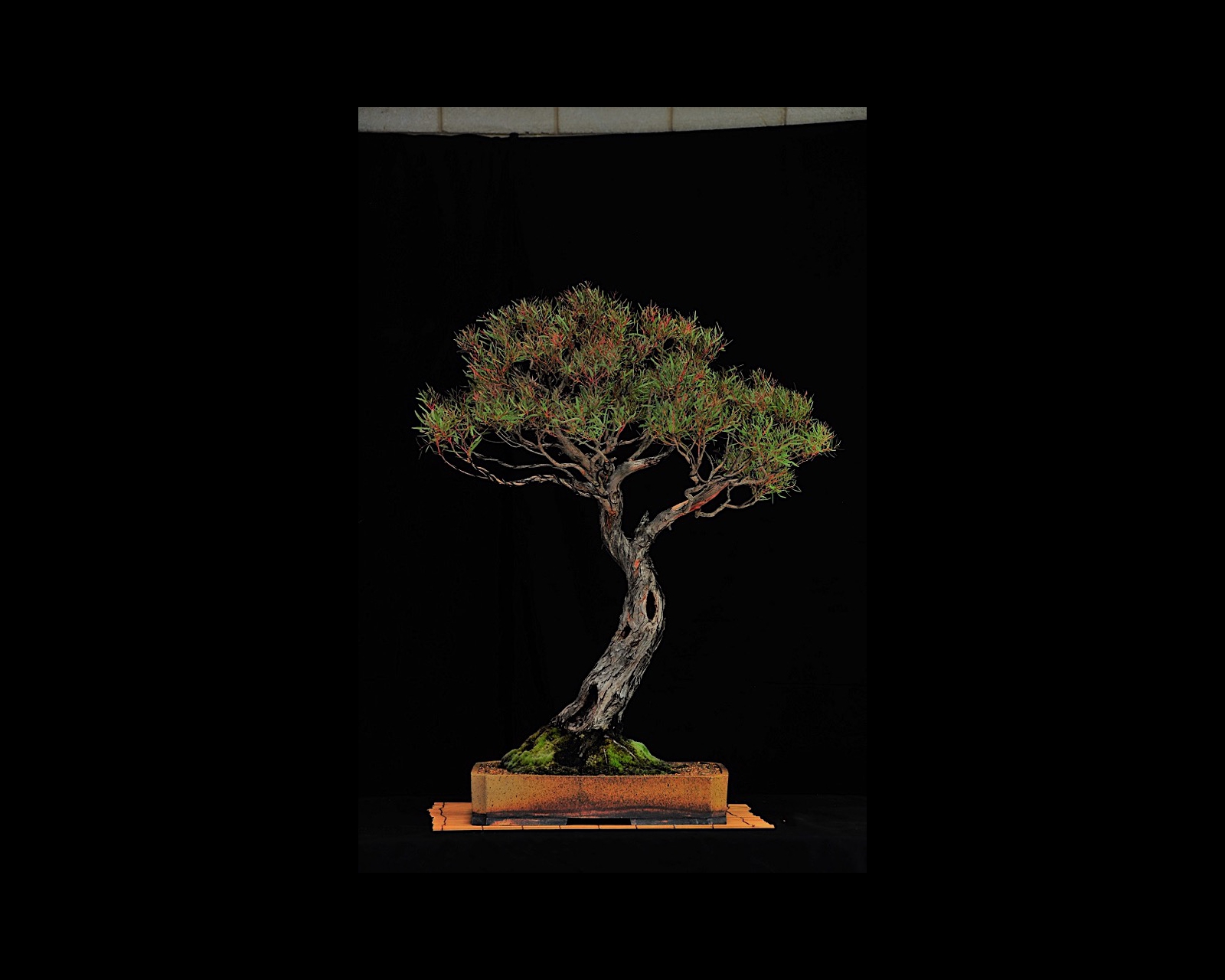 Narrow-leaved black peppermint gum. Eucalyptus nicholii. Age of tree Unknown.
Trained since 1996. Found at south Canberra Dump in the Revolve section in the summer of 1995. It was in very little soil and full of disease. (mealy bug and sooty mildew). Over the following months I removed the pests, re-potted, cut back and trained a new leader. It was kept as an experimentand I was unsure how a Eucalypt would react to bonsai techniques. In 1999 I potted it into a bonsai pot and continued shaping into a gum tree style. After the 2001 show, I carved the lower and mid sections of the tree and then re-potted. Since that repot, I have re-potted it four times into an Australian made Pots by “Pat Kennedy”.
Over the years I have had a battle with die back and have lost some of the original branches. Generally when this happens the tree goes through a redesign utilizing old branches and new shoots.
Narrow-leaved black peppermint gum. Eucalyptus nicholii. Age of tree Unknown.
Trained since 1996. Found at south Canberra Dump in the Revolve section in the summer of 1995. It was in very little soil and full of disease. (mealy bug and sooty mildew). Over the following months I removed the pests, re-potted, cut back and trained a new leader. It was kept as an experimentand I was unsure how a Eucalypt would react to bonsai techniques. In 1999 I potted it into a bonsai pot and continued shaping into a gum tree style. After the 2001 show, I carved the lower and mid sections of the tree and then re-potted. Since that repot, I have re-potted it four times into an Australian made Pots by “Pat Kennedy”.
Over the years I have had a battle with die back and have lost some of the original branches. Generally when this happens the tree goes through a redesign utilizing old branches and new shoots.
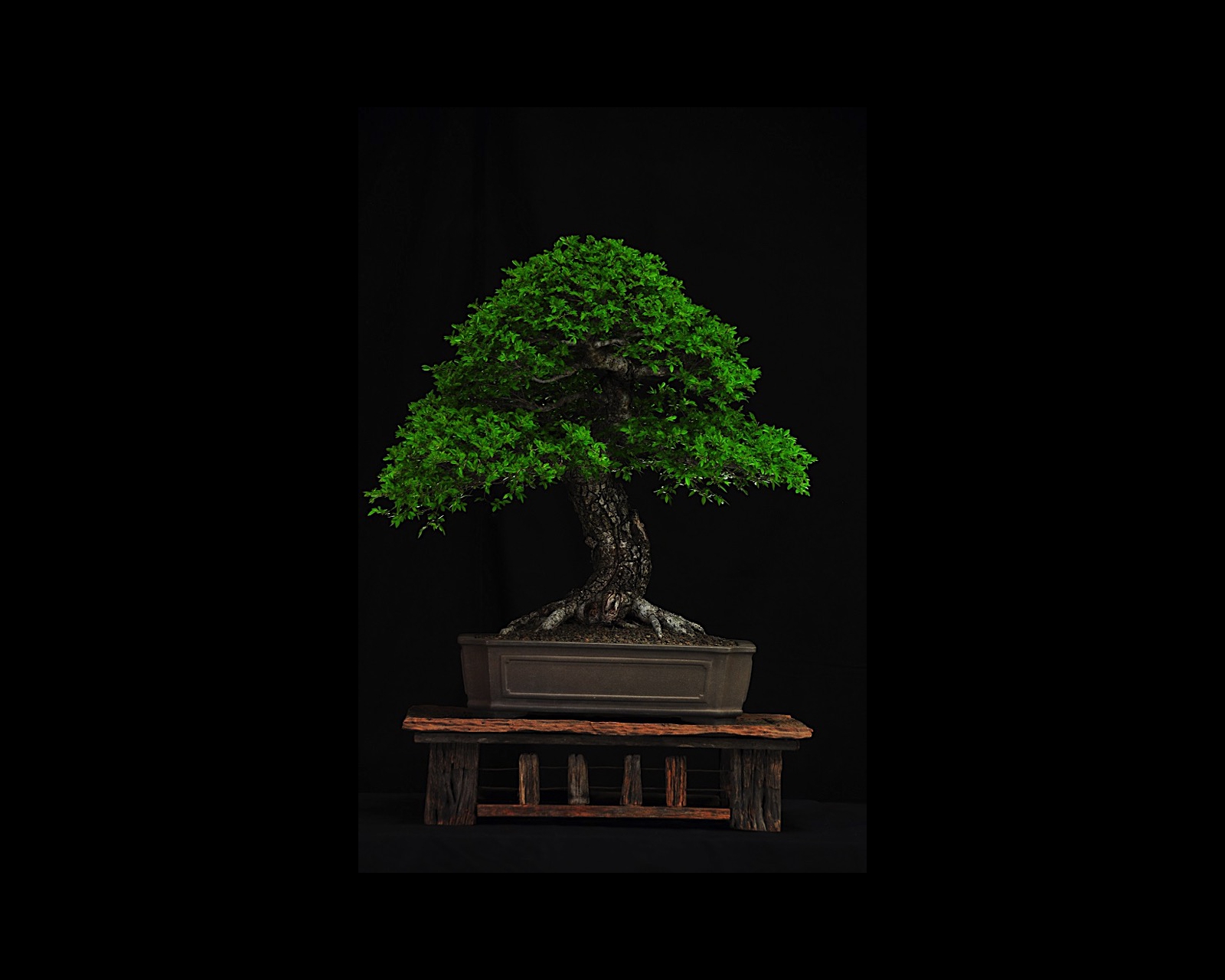 Corky bark Chinese elm. Ulmus parvifolia 'Cork Bark' .Age of tree 35 years
Trained since 1996. This plant was ground grown stock from the Brisbane area, and was first styled in 1996. It received two local Bonsai Show awards on the Sunshine Coast.
Corky bark Chinese elm. Ulmus parvifolia 'Cork Bark' .Age of tree 35 years
Trained since 1996. This plant was ground grown stock from the Brisbane area, and was first styled in 1996. It received two local Bonsai Show awards on the Sunshine Coast.
 Zelkova serrata. Age of tree 47 years. Trained since 1996. This group was assembled in 1996 from old stock trees for Ray Nesci on a man-made slab from Bonsai South.
Zelkova serrata. Age of tree 47 years. Trained since 1996. This group was assembled in 1996 from old stock trees for Ray Nesci on a man-made slab from Bonsai South.
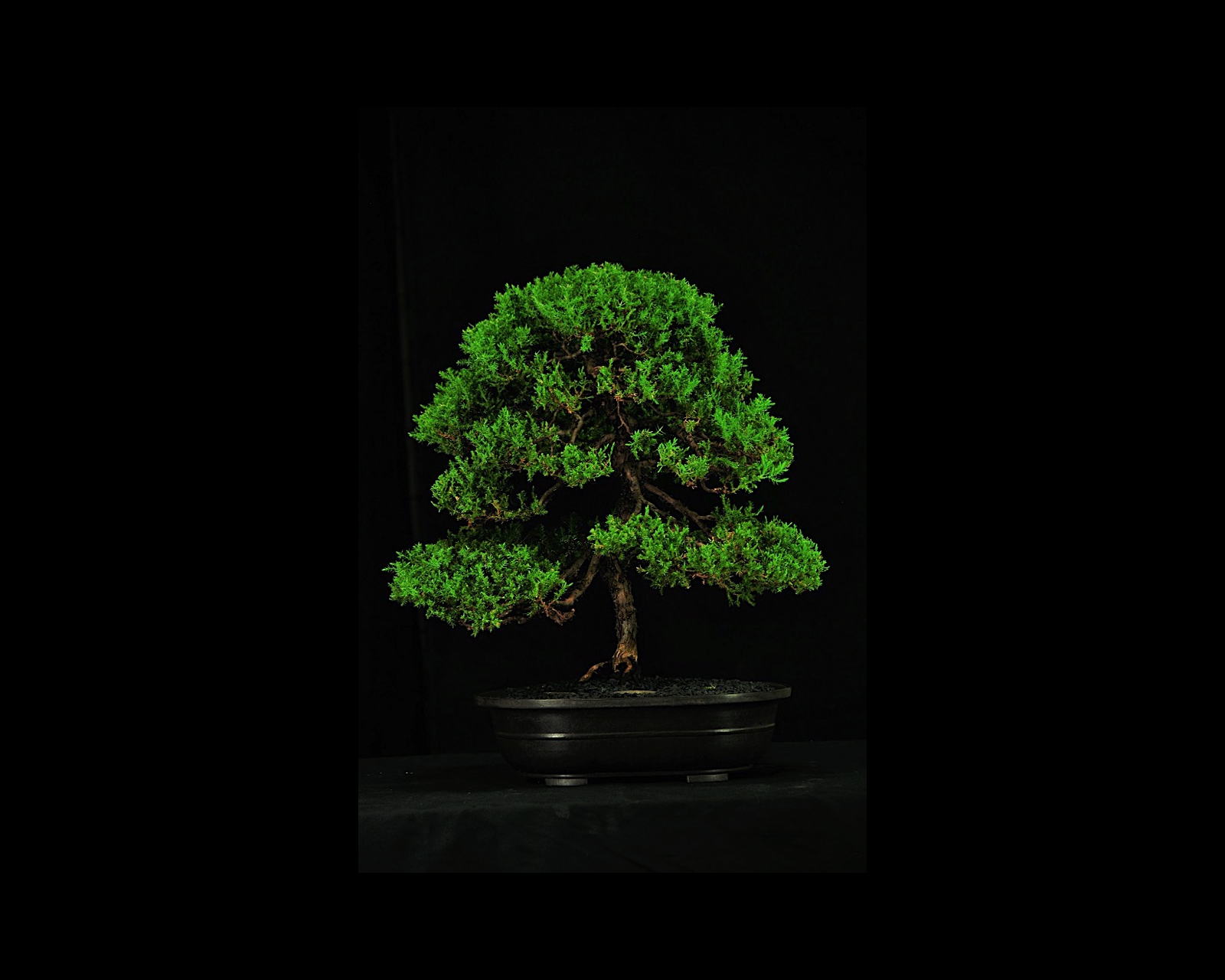 Juniperus procumbens. Age of tree 17 years. Trained since 2000. This tree was gifted to me by Case Snel from the Illawarra Bonsai Society in 2016. Case grew the tree from a small nursery plant in 2000, repotting and pruning it annually until 2015.
Juniperus procumbens. Age of tree 17 years. Trained since 2000. This tree was gifted to me by Case Snel from the Illawarra Bonsai Society in 2016. Case grew the tree from a small nursery plant in 2000, repotting and pruning it annually until 2015.
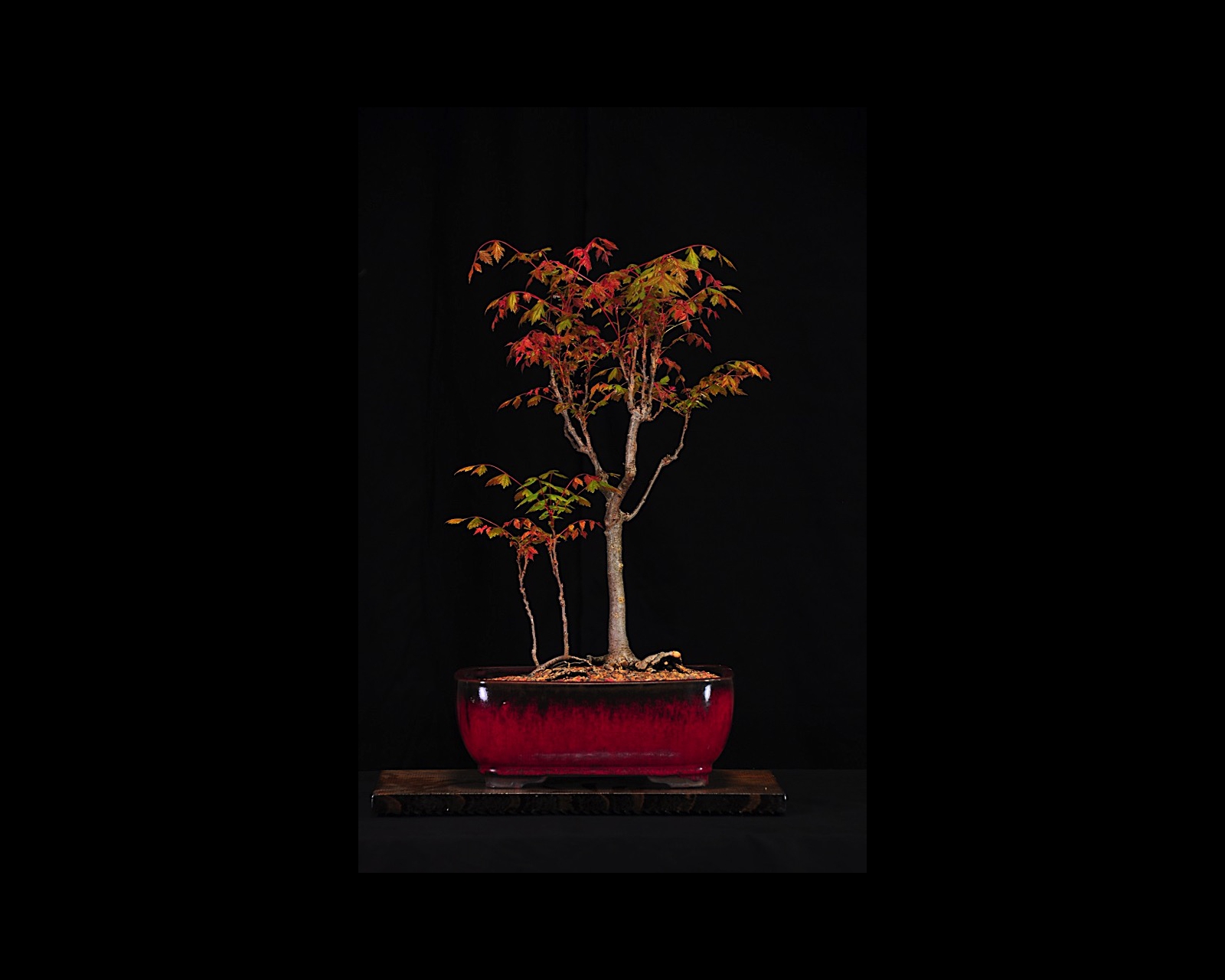 Koelreuteria paniculata. Age of tree 16 years. Trained since 2001. This bonsai was a seedling collected from my garden and initially trained in upright style. When roots were exposed and smaller suckers developed, it continued to be trained in the upright raft style. The new foliage each year is dramatic yet soft red, turning green through summer. Flowers are golden yellow.
Koelreuteria paniculata. Age of tree 16 years. Trained since 2001. This bonsai was a seedling collected from my garden and initially trained in upright style. When roots were exposed and smaller suckers developed, it continued to be trained in the upright raft style. The new foliage each year is dramatic yet soft red, turning green through summer. Flowers are golden yellow. 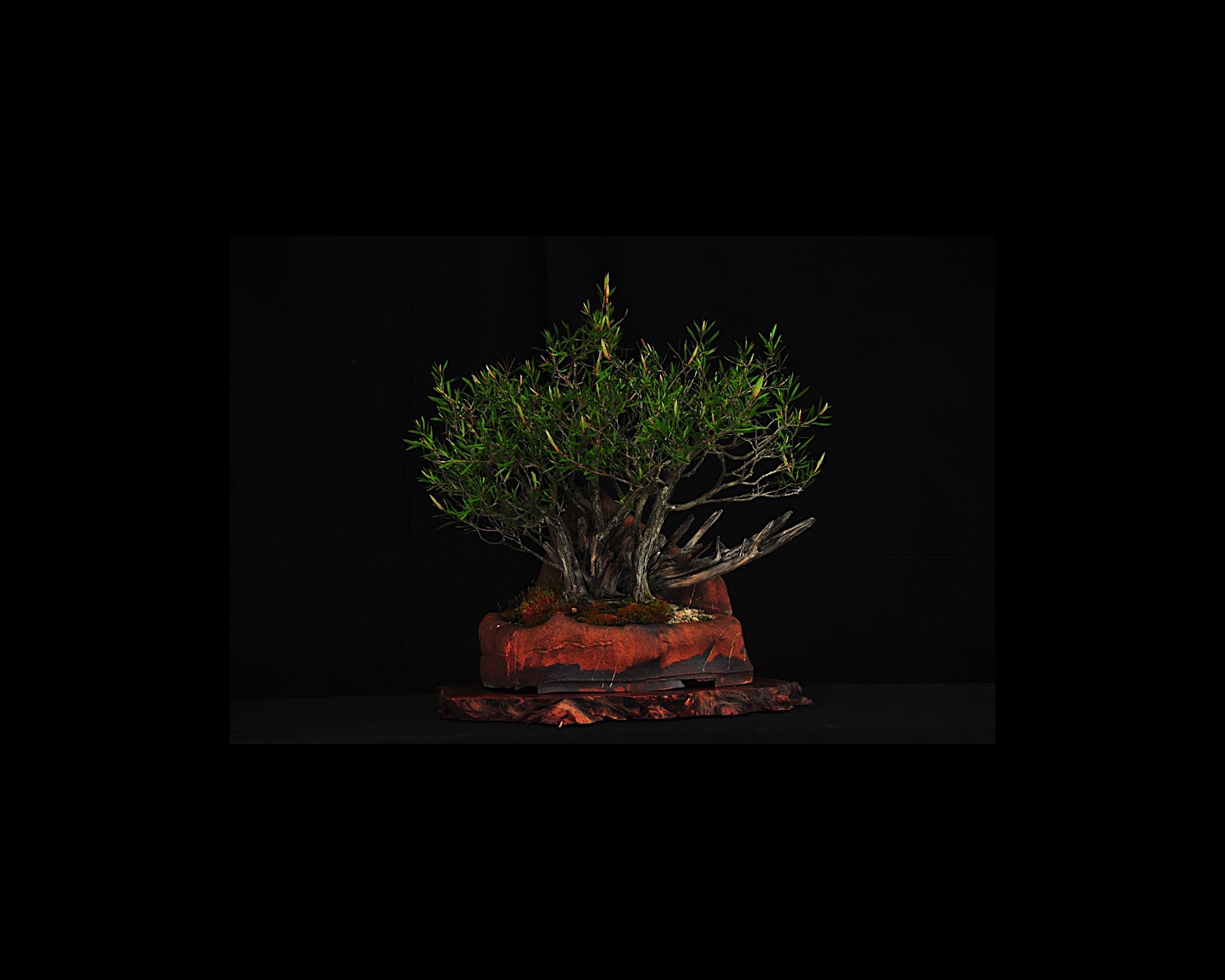 Callistemon sp. Age of tree 30 years. Trained since 2002. This tree has complex associations for me. With a friend, I rescued it from immanent death as its home in a planter box was being destroyed. It is a kind of refugee - separated from its past. Its family and 'homeland' are but memories. Its life now shows vigour and completeness built out of its strength to grow and flourish where it is. It carries marks of its difficult past, but these underpin determination to thrive. This tree brings hope as it demonstrates what can be done with life as long as it can continue with help from friends.
Callistemon sp. Age of tree 30 years. Trained since 2002. This tree has complex associations for me. With a friend, I rescued it from immanent death as its home in a planter box was being destroyed. It is a kind of refugee - separated from its past. Its family and 'homeland' are but memories. Its life now shows vigour and completeness built out of its strength to grow and flourish where it is. It carries marks of its difficult past, but these underpin determination to thrive. This tree brings hope as it demonstrates what can be done with life as long as it can continue with help from friends.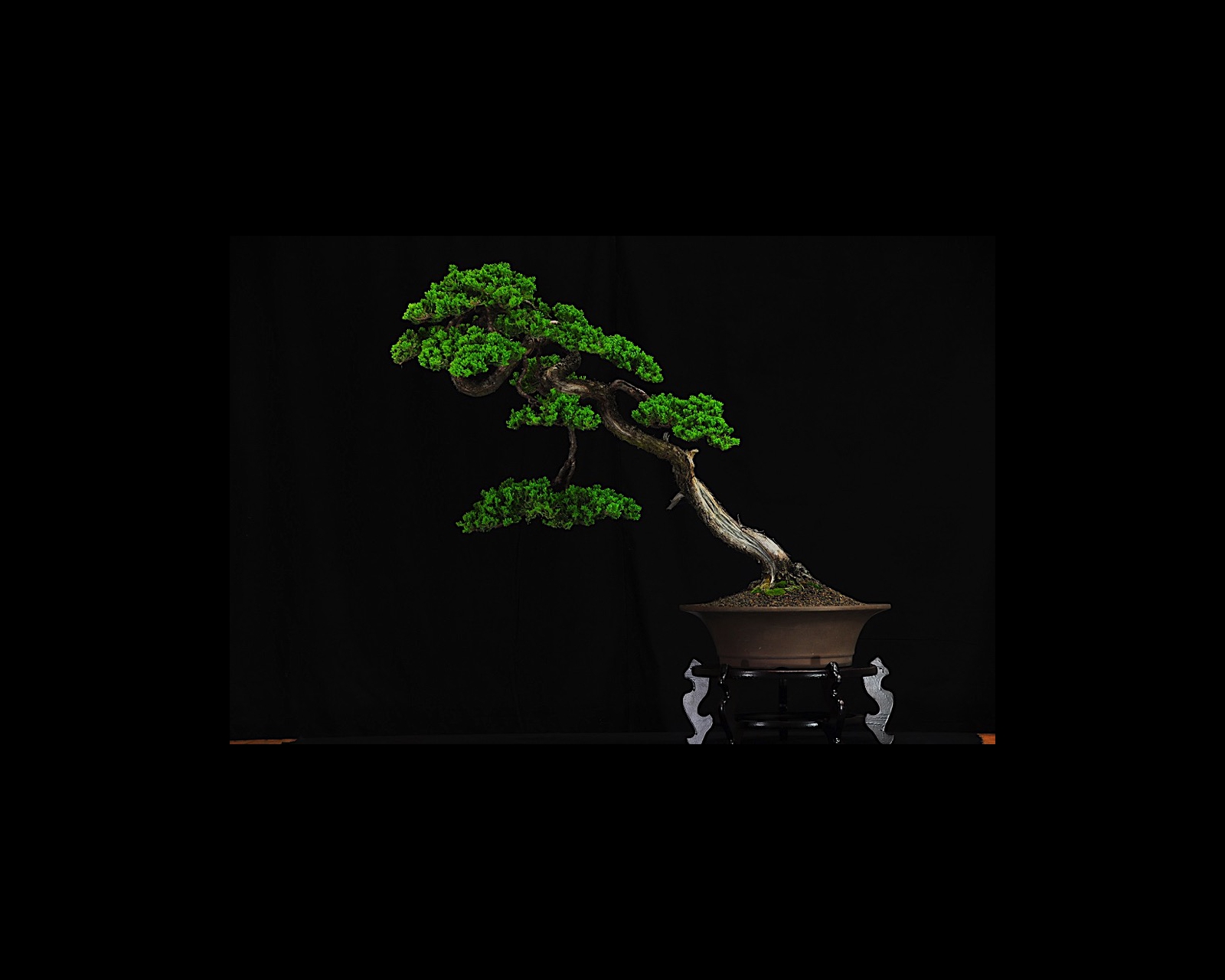 Juniperus squamata 'Prostrata'. Age of tree 40 years. Trained since 2002. This tree was ground grown in Sydney, styled on the Sunshine Coast and now lives in Canberra.
Juniperus squamata 'Prostrata'. Age of tree 40 years. Trained since 2002. This tree was ground grown in Sydney, styled on the Sunshine Coast and now lives in Canberra.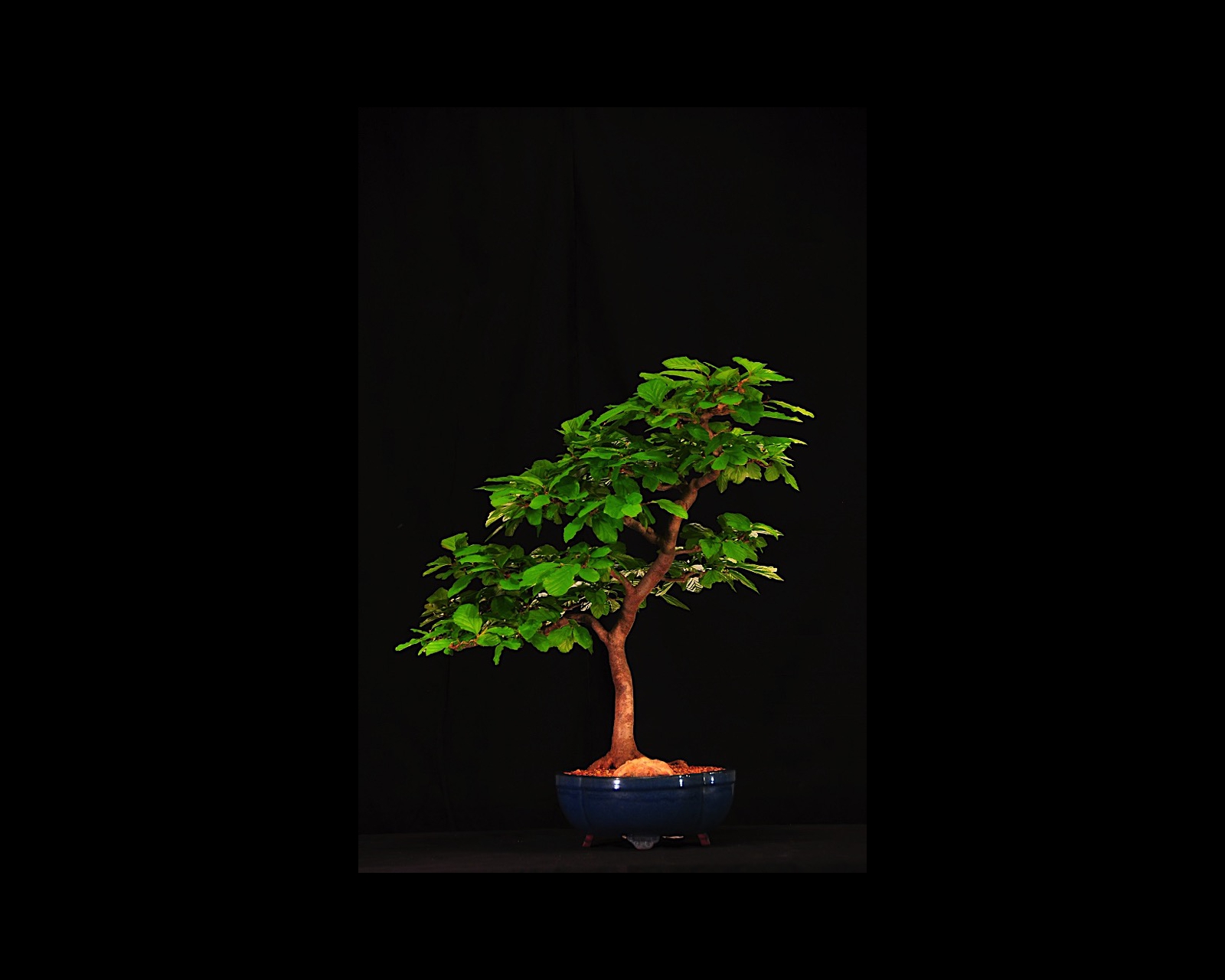 Parrotia persica Age of tree Approx. 15 years. Trained since around 2002. This tree was gifted to me by Case Snel from the Illawarra Bonsai Society in 2015. I have no information about the tree only that I have cared for it over the 2 years.
Parrotia persica Age of tree Approx. 15 years. Trained since around 2002. This tree was gifted to me by Case Snel from the Illawarra Bonsai Society in 2015. I have no information about the tree only that I have cared for it over the 2 years. 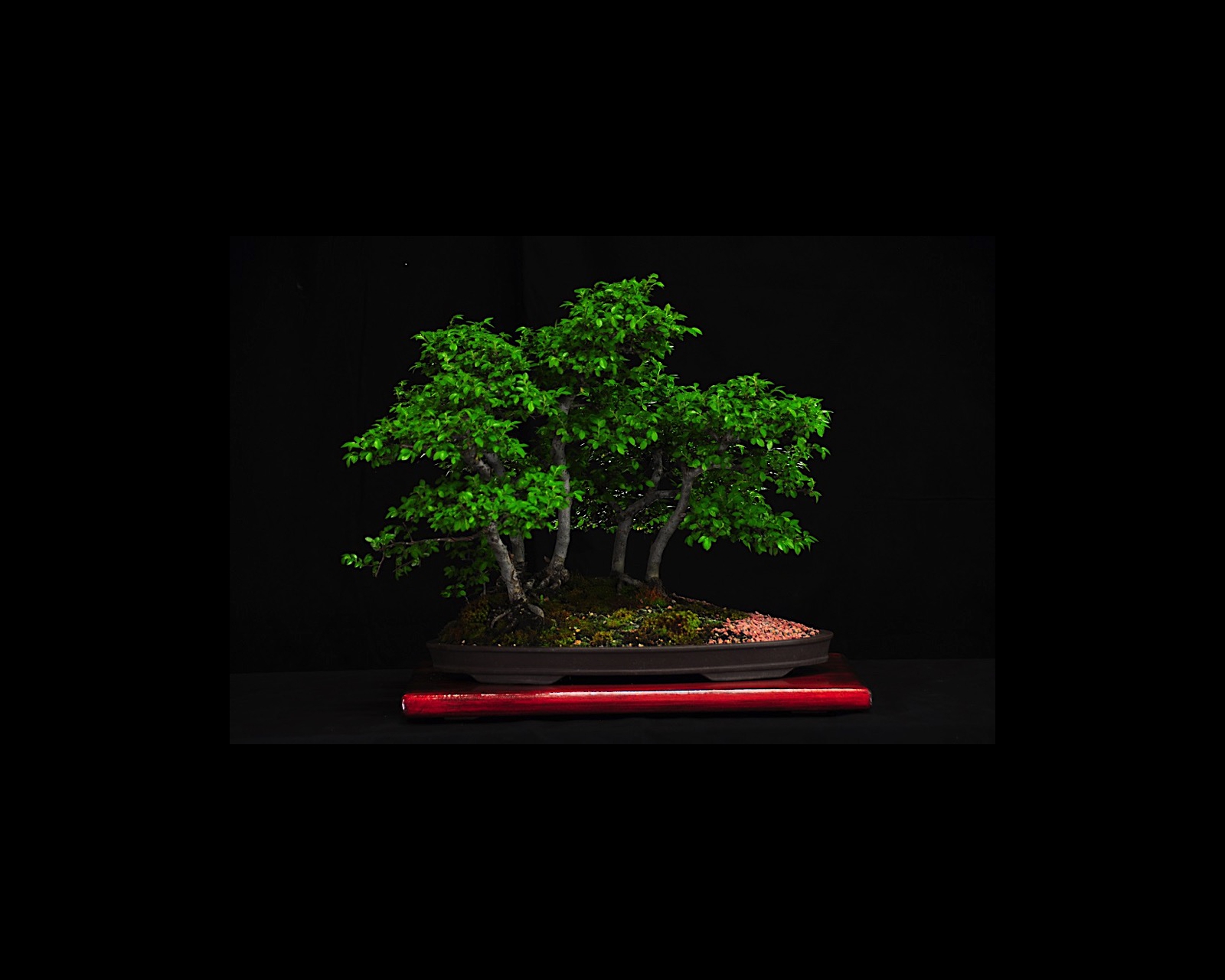 Ulmus parvifolia. Age of tree 14 years. Trained since 2003. This Chinese elm forest belonged to my grandmother. She planted this forest when she lived in Queensland and brought it to Canberra. For me, this is a remembrance forest for my grandmother as it was one of her only penjing and is therefore quite special to me. It also represents her dedication to the care to her bonsai and her family. The forest had a restyle a year ago changing the trees from being all over the pot to being only being on one side.
Ulmus parvifolia. Age of tree 14 years. Trained since 2003. This Chinese elm forest belonged to my grandmother. She planted this forest when she lived in Queensland and brought it to Canberra. For me, this is a remembrance forest for my grandmother as it was one of her only penjing and is therefore quite special to me. It also represents her dedication to the care to her bonsai and her family. The forest had a restyle a year ago changing the trees from being all over the pot to being only being on one side.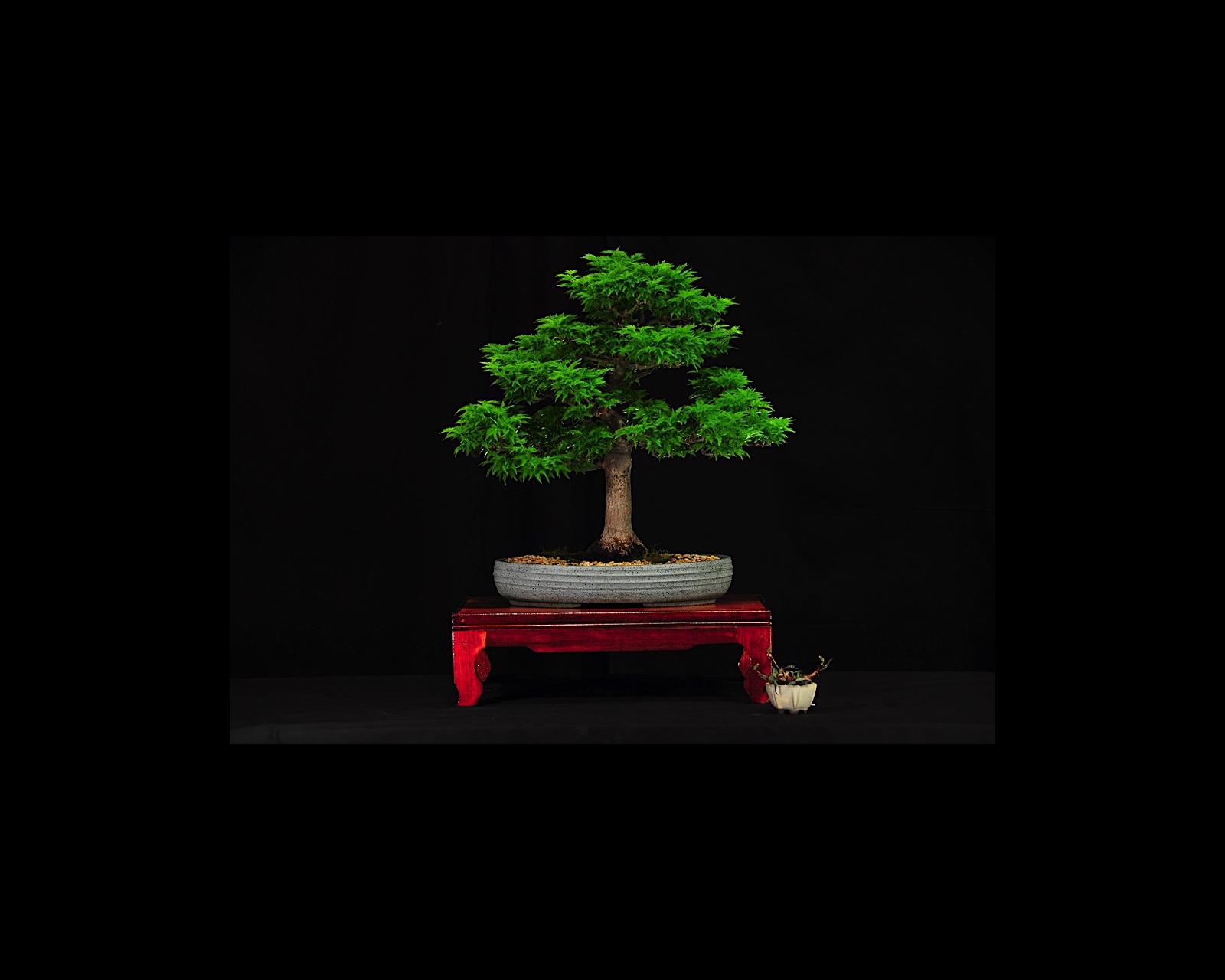 Acer palmatum 'Kotohime' . Age of tree 14 years. Trained since 2004. This maple has naturally small leaves and brilliant Autumn colour. I admired it a few years ago when the artist and owner showed it at a CBS meeting in full colour. When the artist was reducing the number of her trees, she offered it to me and it is now a prized part of my collection.
Acer palmatum 'Kotohime' . Age of tree 14 years. Trained since 2004. This maple has naturally small leaves and brilliant Autumn colour. I admired it a few years ago when the artist and owner showed it at a CBS meeting in full colour. When the artist was reducing the number of her trees, she offered it to me and it is now a prized part of my collection.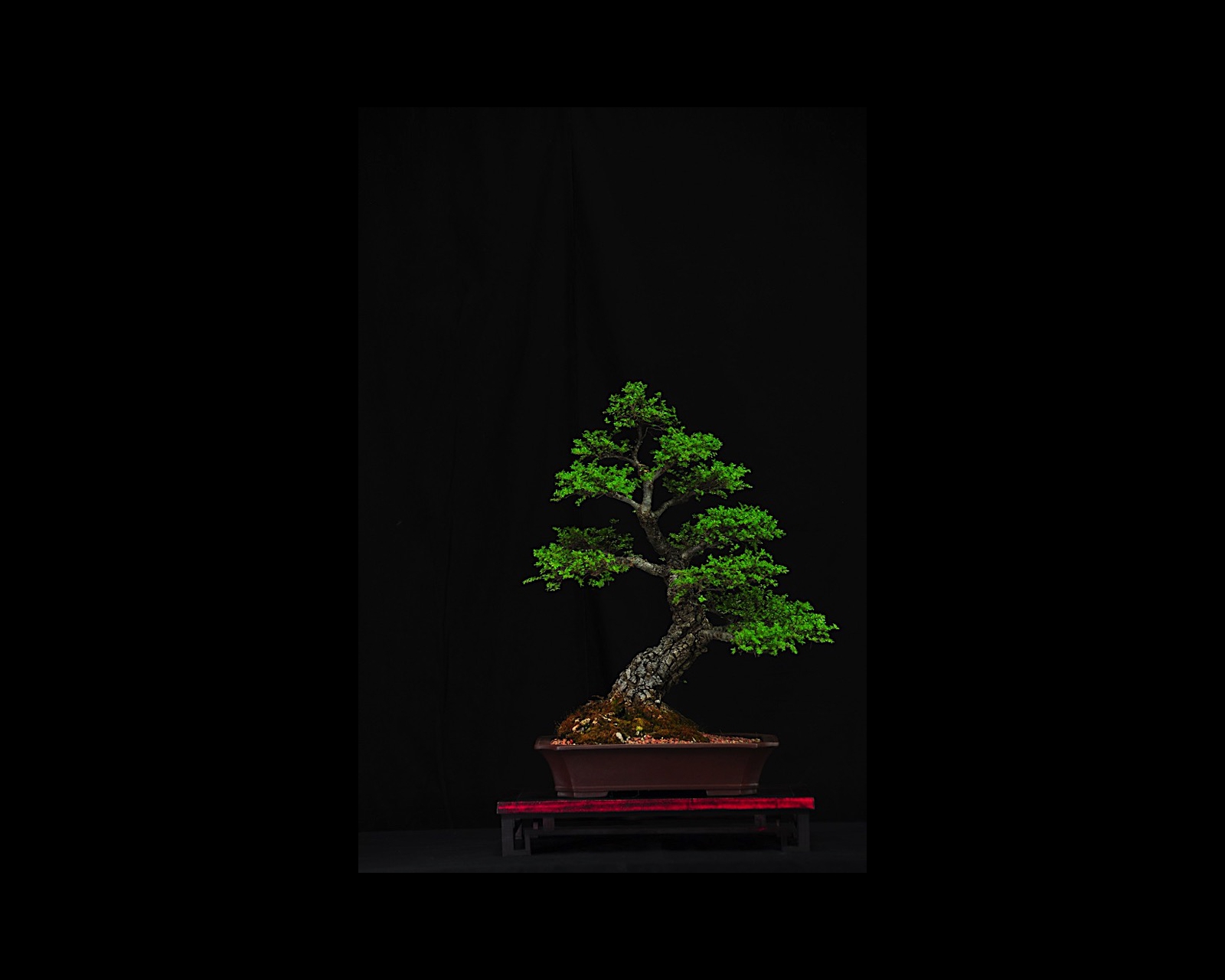 Ulmus parvifolia 'Seiju'. Age of tree 17 years. Trained since 2004. The curving base and trunk of this tree are very pleasing. I have developed this tree since buying it as nursery stock in 2004.
Ulmus parvifolia 'Seiju'. Age of tree 17 years. Trained since 2004. The curving base and trunk of this tree are very pleasing. I have developed this tree since buying it as nursery stock in 2004.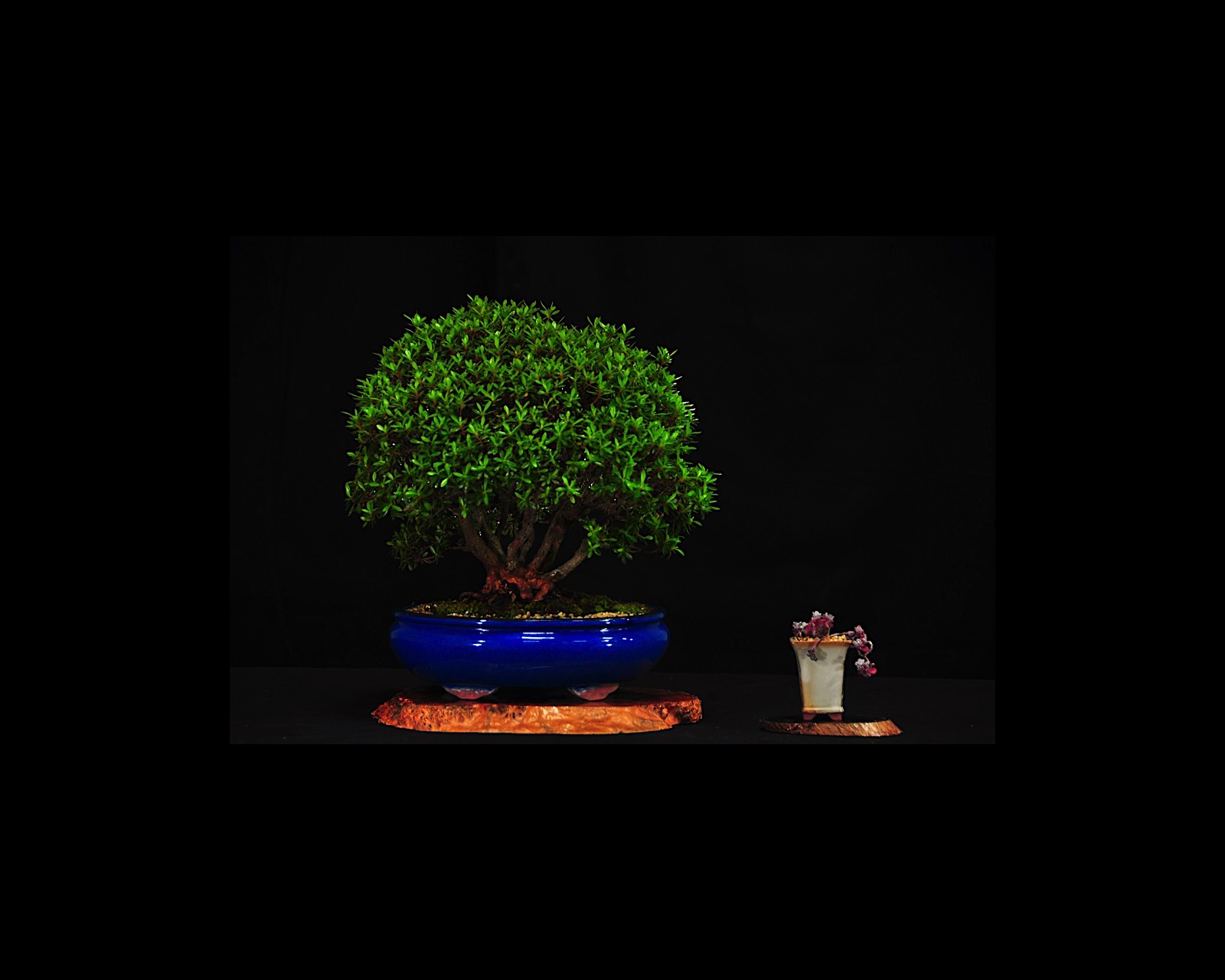 Rhododendron sp.. Age of tree 15 years. Trained since 2005. This plant is a non flowering species, with small leaves which change colour in cold weather. One of the aspects of this tree that gives me pleasure is the very old-looking surface root system and the multiple trunks. Along with the spreading canopy they evoke old age.
Rhododendron sp.. Age of tree 15 years. Trained since 2005. This plant is a non flowering species, with small leaves which change colour in cold weather. One of the aspects of this tree that gives me pleasure is the very old-looking surface root system and the multiple trunks. Along with the spreading canopy they evoke old age.
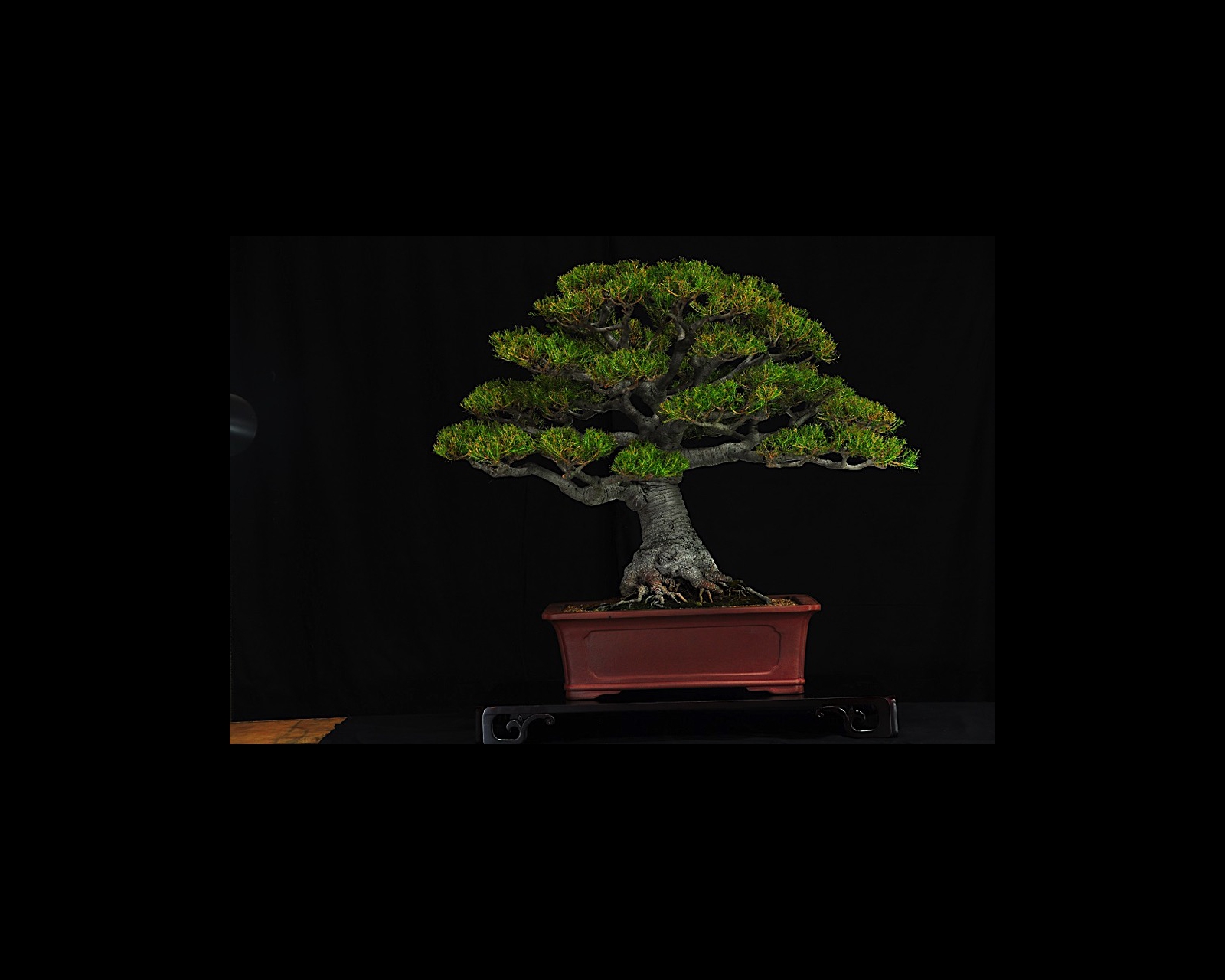 Banksia ericifolia. Age of tree Unknown. Trained since 2005. I bought this tree in 2005 as a standardized pot plant (1.7m). The nursery was located in Young NSW and the owner/nurseryman had been experimenting with this plant for some years and wasn't happy with its progress.
I reduced its size to a lower shoot at 30cm which I suspect had developed due to neglect. (Bonus for me). It threw out many new shoots from which I selected the ones I was keeping and removed the unwanted ones. It has only flowered twice in the early days of its development.
Banksia ericifolia. Age of tree Unknown. Trained since 2005. I bought this tree in 2005 as a standardized pot plant (1.7m). The nursery was located in Young NSW and the owner/nurseryman had been experimenting with this plant for some years and wasn't happy with its progress.
I reduced its size to a lower shoot at 30cm which I suspect had developed due to neglect. (Bonus for me). It threw out many new shoots from which I selected the ones I was keeping and removed the unwanted ones. It has only flowered twice in the early days of its development.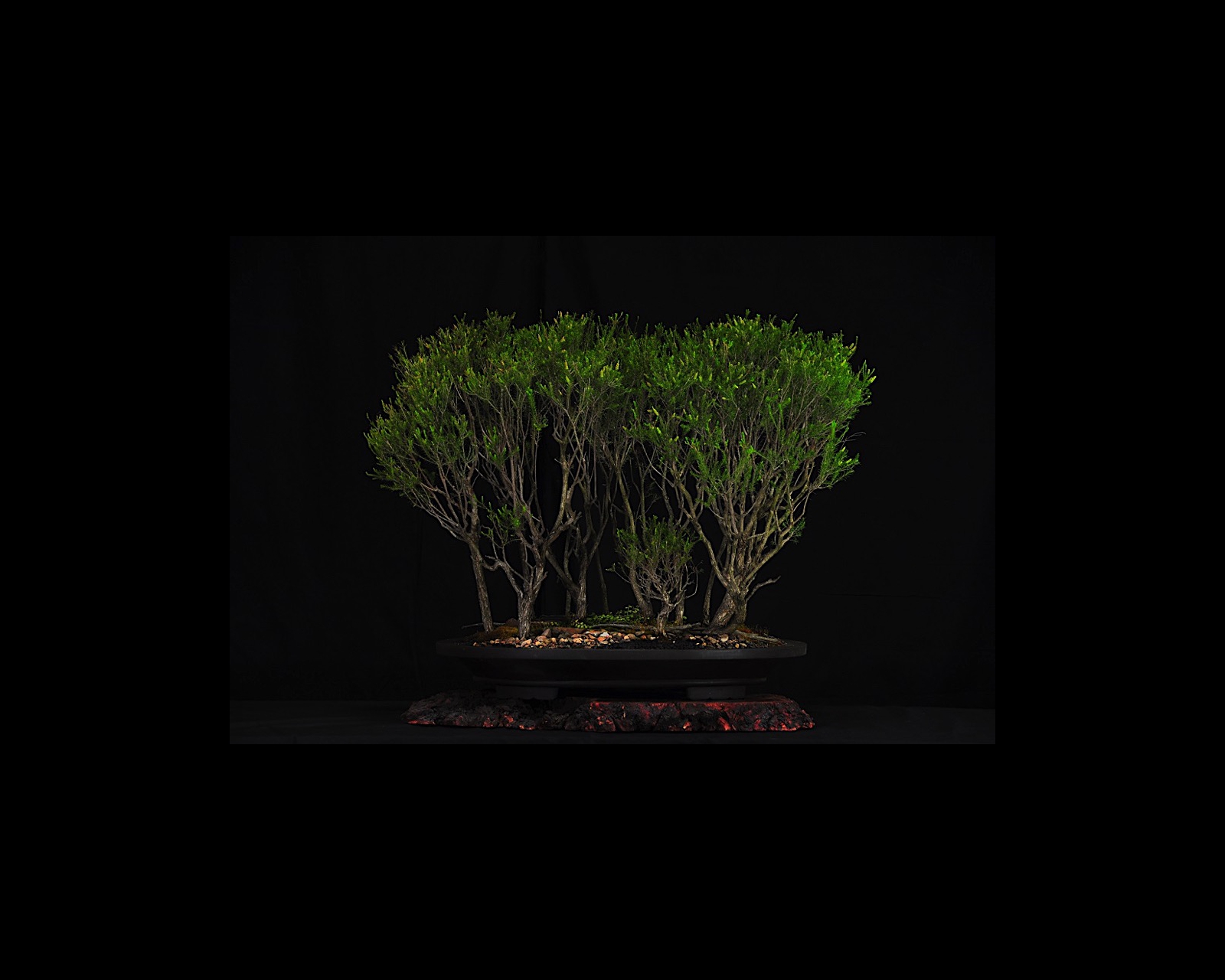 Melaleuca ericifolia, Age of tree 12 years. Trained since 2005. Swamp paperbarks fringe swamps and shallow rivers behind dunes near the coast from northern NSW down to Tasmania. Their starkly pale trunks and dark green shallow canopies often frame still black waters. The tall trees are on land just above water level, but some short, gnarled individuals stand permanently in the water. Stillness in the twilight of dawn and sunset with soft yellow-orange light above dark water complete my memories of these beautiful forests.
Melaleuca ericifolia, Age of tree 12 years. Trained since 2005. Swamp paperbarks fringe swamps and shallow rivers behind dunes near the coast from northern NSW down to Tasmania. Their starkly pale trunks and dark green shallow canopies often frame still black waters. The tall trees are on land just above water level, but some short, gnarled individuals stand permanently in the water. Stillness in the twilight of dawn and sunset with soft yellow-orange light above dark water complete my memories of these beautiful forests.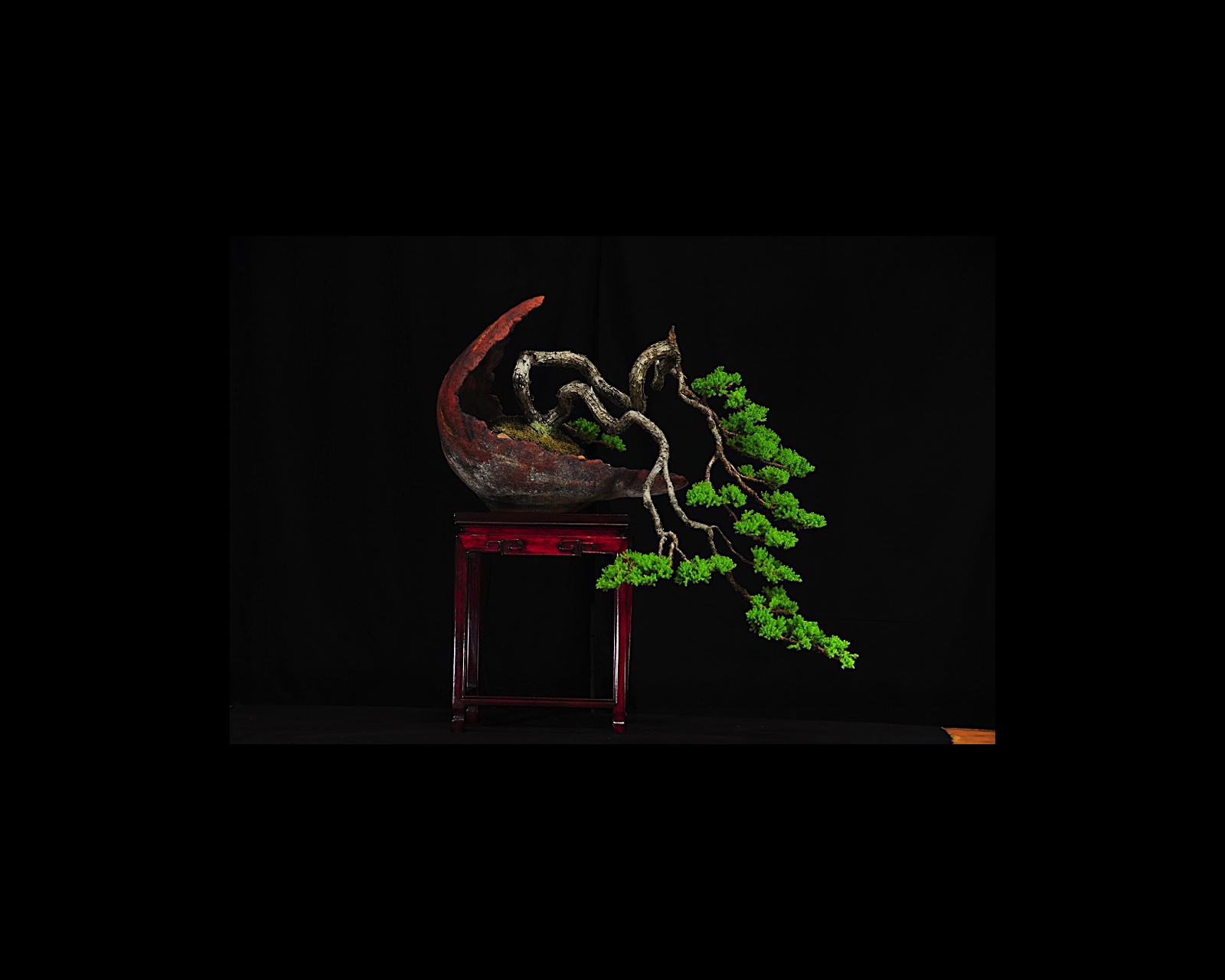 Juniper squamata 'Prostrata'. Age of tree 22 years. Trained since 2006. This bonsai has been styled to represent a tree clinging to the side of a cliff in very difficult conditions. The foliage pads are sparse and tight, reflecting the limited nutrition available and the bright sun beating down on it year-round. The pot is a hand-made Australian pot.
Juniper squamata 'Prostrata'. Age of tree 22 years. Trained since 2006. This bonsai has been styled to represent a tree clinging to the side of a cliff in very difficult conditions. The foliage pads are sparse and tight, reflecting the limited nutrition available and the bright sun beating down on it year-round. The pot is a hand-made Australian pot.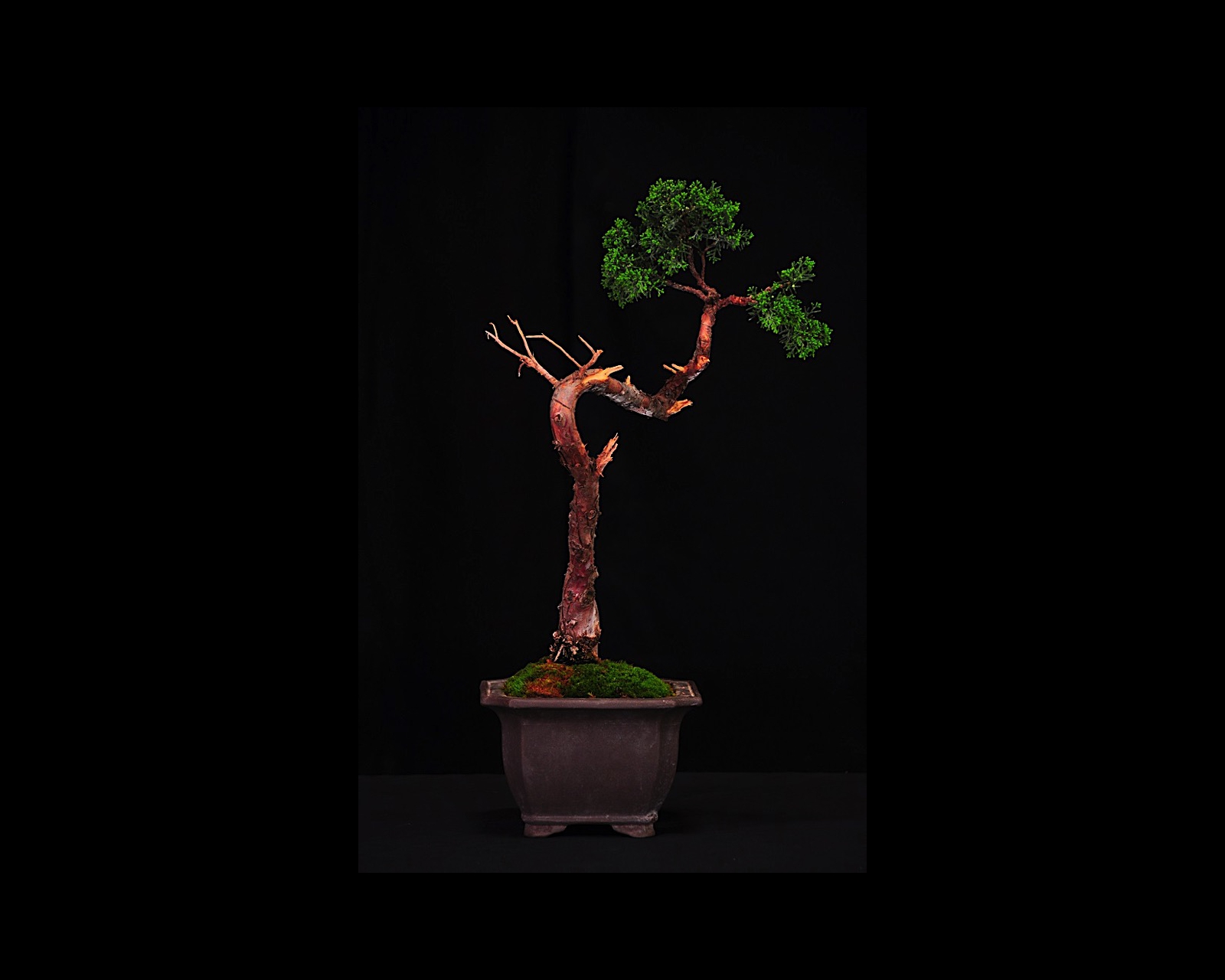 Juniperus chinensis Shimpaku. Age of tree More than 10 years. Trained since 2006. I acquired the tree from a CBS club member in 2016 and have undertaken some significant modifications through a series of workshops over the last two years.
Juniperus chinensis Shimpaku. Age of tree More than 10 years. Trained since 2006. I acquired the tree from a CBS club member in 2016 and have undertaken some significant modifications through a series of workshops over the last two years. 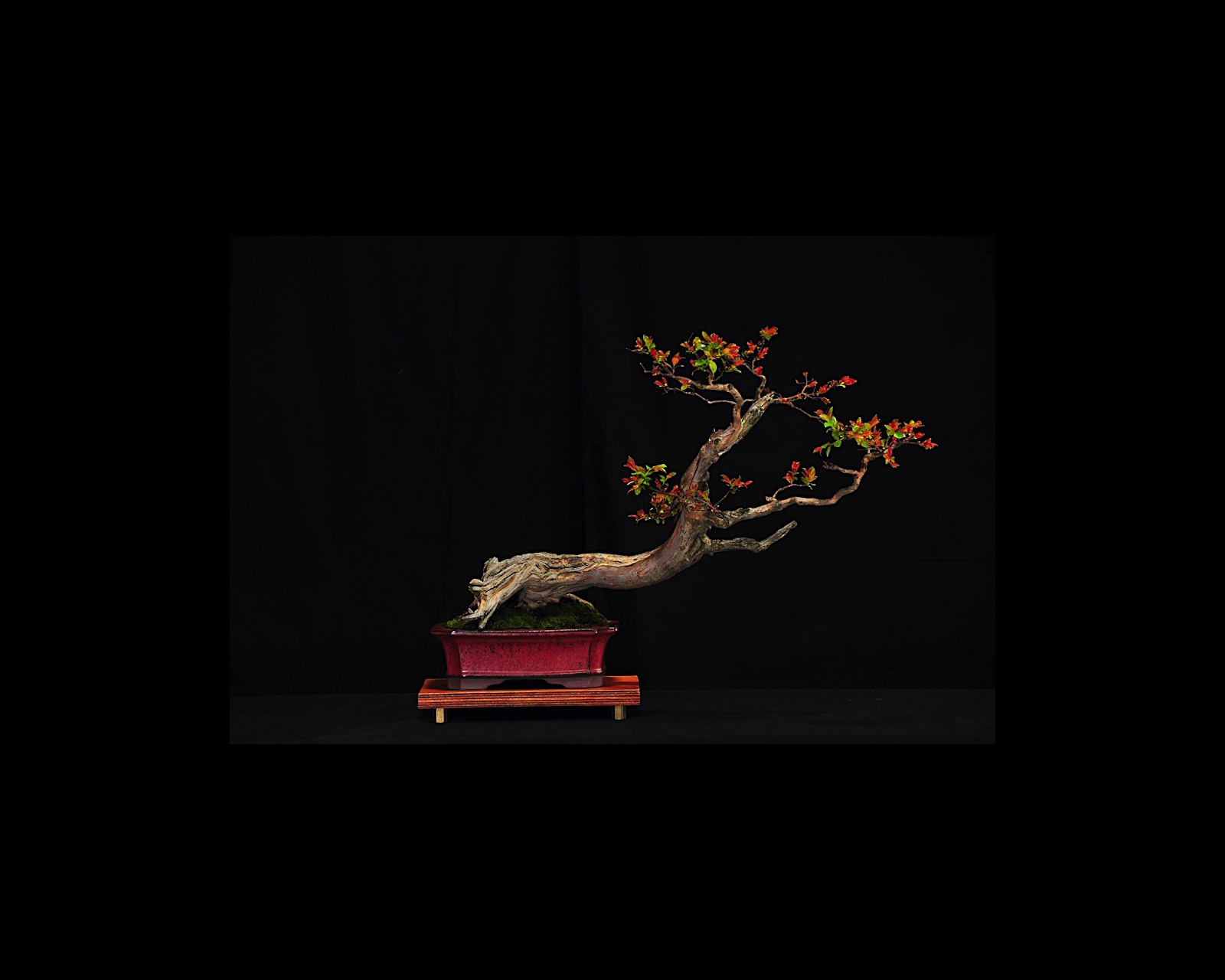 Lagerstroemia indica. Age of tree 25 years. Trained since 2007. This bonsai came from a cutting which was ground-grown for a number of years. There was a remarkably ugly main trunk that was removed and later carved out. It flowers well.
Lagerstroemia indica. Age of tree 25 years. Trained since 2007. This bonsai came from a cutting which was ground-grown for a number of years. There was a remarkably ugly main trunk that was removed and later carved out. It flowers well.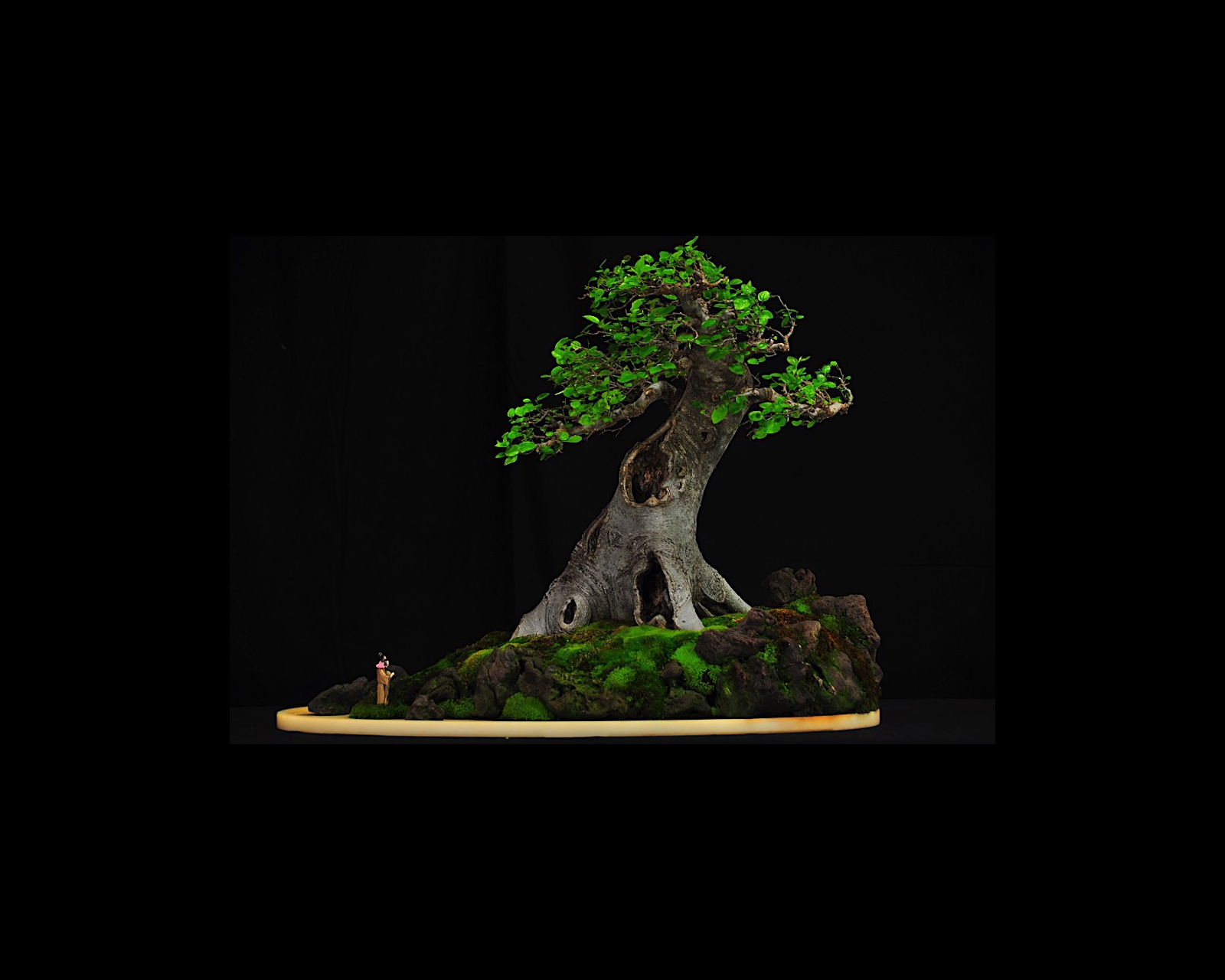 Celtis sinensis. Age of tree 35 years. Trained since 2007. This tree was collected in Gympie Queensland and was originally designed in a very traditional style. It was restyled as a penjing setting in March 2017.
Celtis sinensis. Age of tree 35 years. Trained since 2007. This tree was collected in Gympie Queensland and was originally designed in a very traditional style. It was restyled as a penjing setting in March 2017.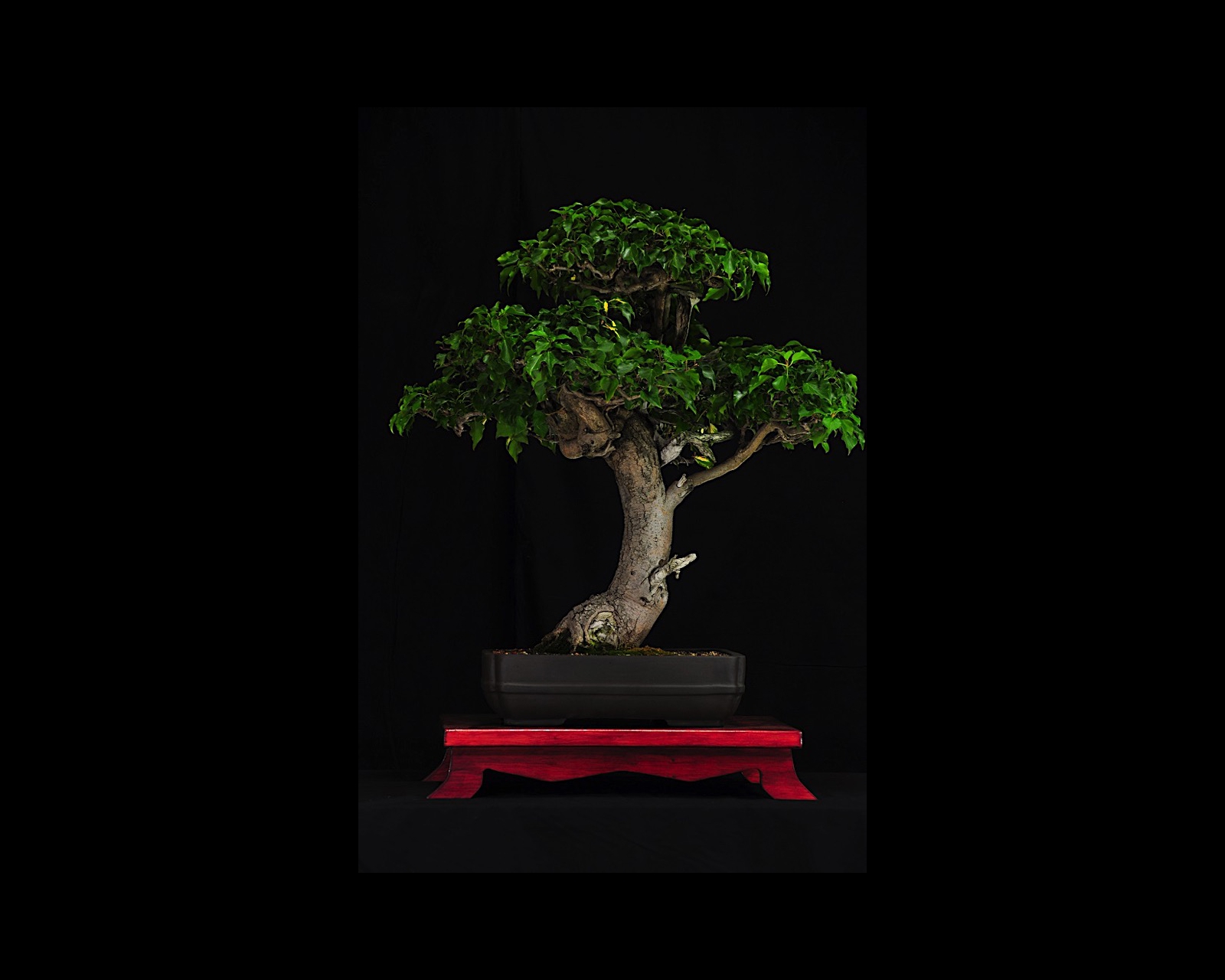 Hedera helix. Age of tree - approx 80 years. Trained since 2008. This plant was dug from a garden in 2006 and originally styled by Chris De Nola in 2008 as a demonstration at a Goulburn Bonsai Society meeting. It flowers and fruits every year, however the fruits are removed before the seeds can be 'delivered' into the environment.
Hedera helix. Age of tree - approx 80 years. Trained since 2008. This plant was dug from a garden in 2006 and originally styled by Chris De Nola in 2008 as a demonstration at a Goulburn Bonsai Society meeting. It flowers and fruits every year, however the fruits are removed before the seeds can be 'delivered' into the environment.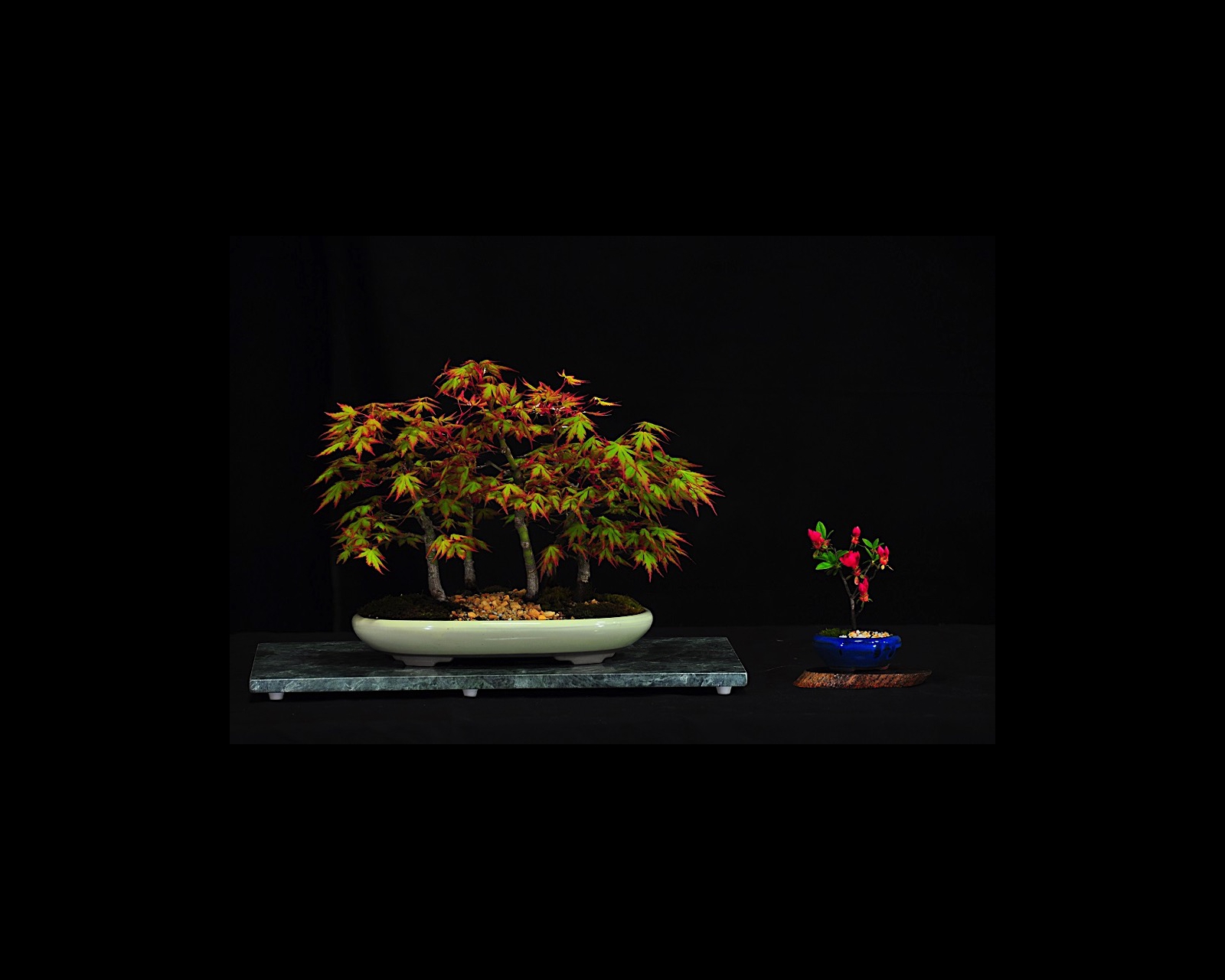 Acer palmatum. Age of tree 10 years. Trained since 2008. This 'mini forest' was create using seedlings which self-propagated from my neighbour's mature maple tree. It consists of five trees which have been positioned as they currently are from the time I started styling the group.
Acer palmatum. Age of tree 10 years. Trained since 2008. This 'mini forest' was create using seedlings which self-propagated from my neighbour's mature maple tree. It consists of five trees which have been positioned as they currently are from the time I started styling the group.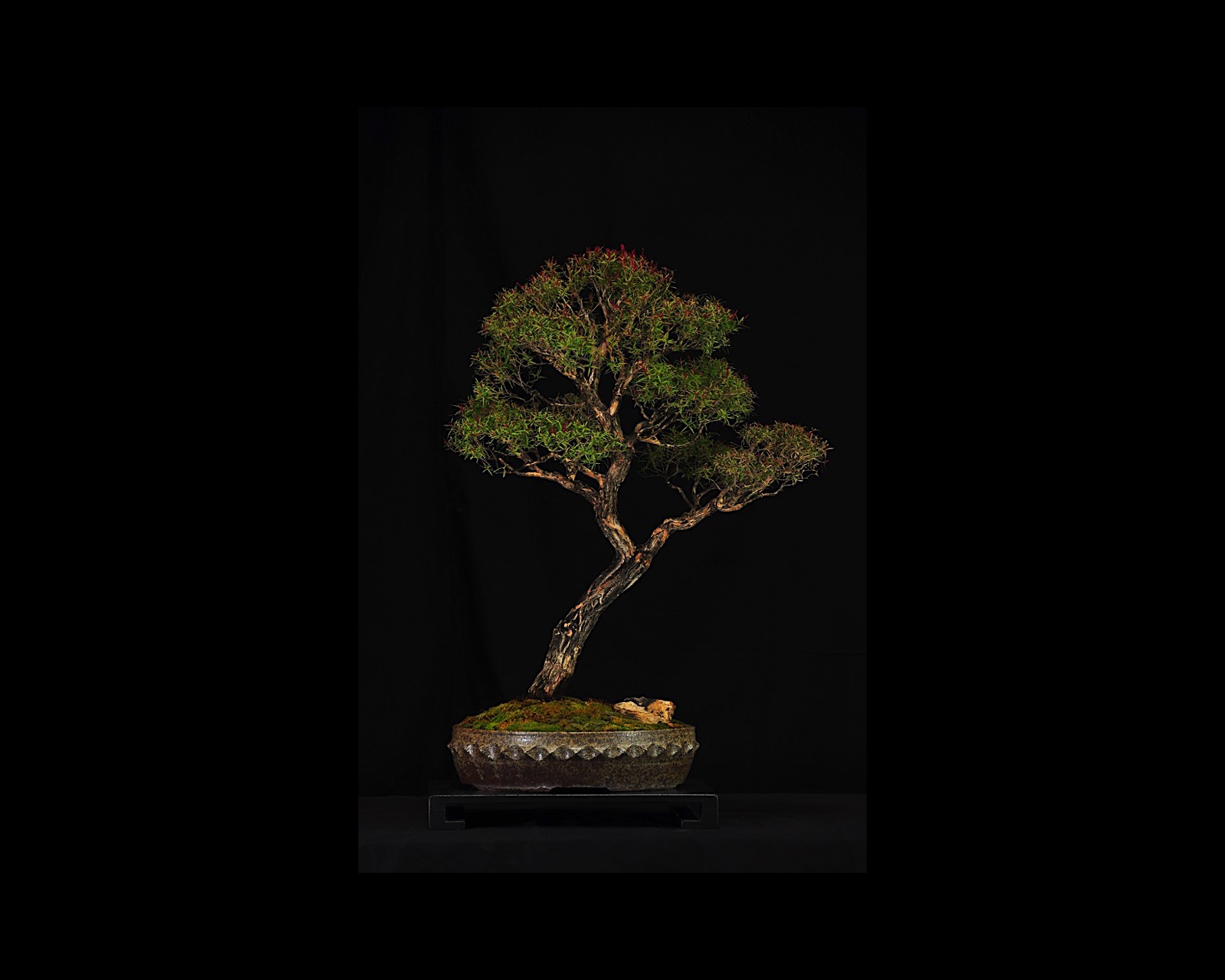 Leptospermum nitidum 'Copper Sheen'. Age of tree 15 years. Trained since 2008. First styled as a literati, I have allowed the tree to grow out to a softer appearance while still aiming to give the impression of a solitary tree in a challenging environment.
Leptospermum nitidum 'Copper Sheen'. Age of tree 15 years. Trained since 2008. First styled as a literati, I have allowed the tree to grow out to a softer appearance while still aiming to give the impression of a solitary tree in a challenging environment. 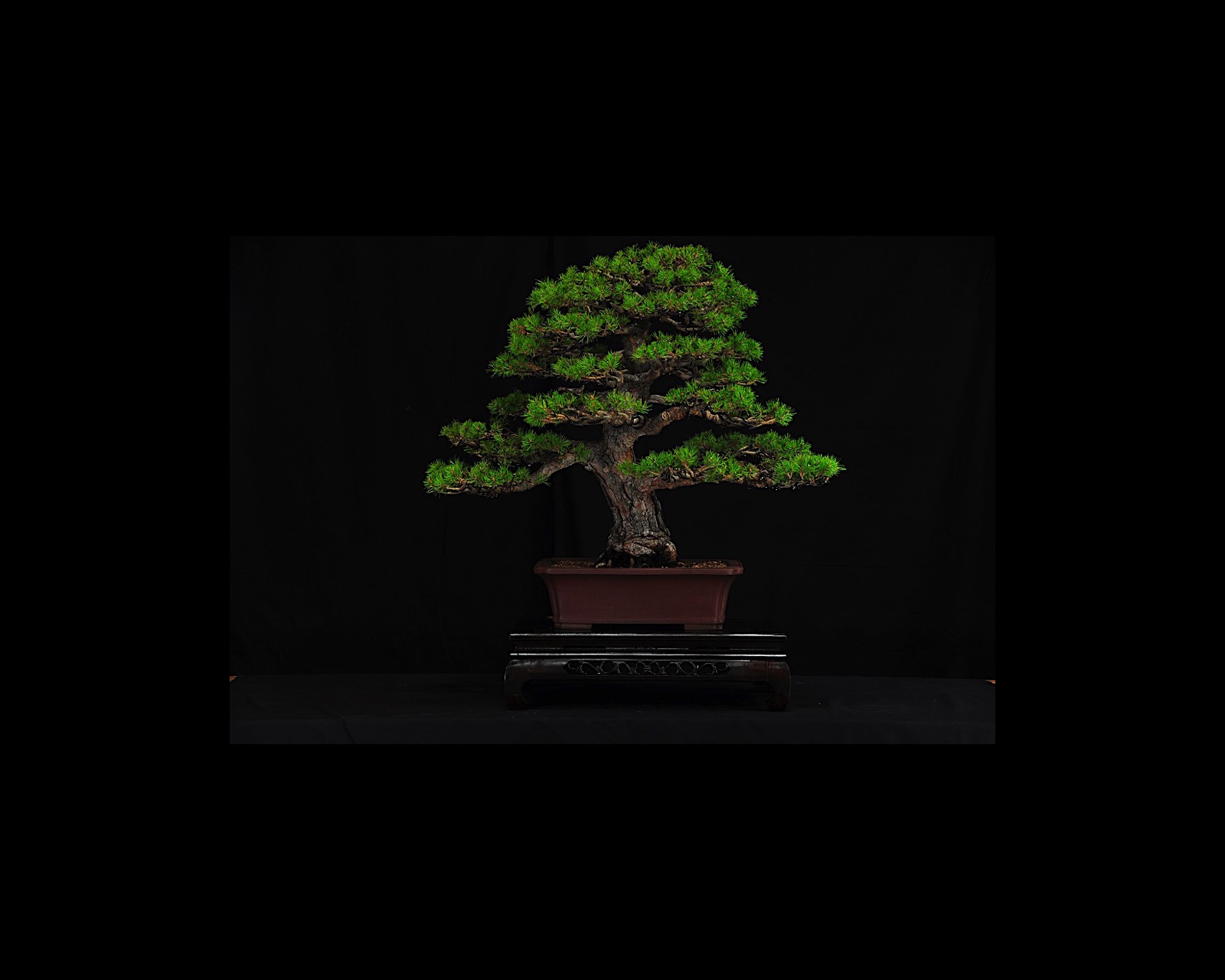 Pinus sylvestrus. Age of tree Unknown.Trained since 2009. When I bought this tree from a local nursery as a stock plant, I was attracted to the size and movement of the trunk. It reacts to bonsai techniques well and buds back on old wood. Its limbs thicken up quickly and at various stages I have had to do some heavy bending to set them in place.
Pinus sylvestrus. Age of tree Unknown.Trained since 2009. When I bought this tree from a local nursery as a stock plant, I was attracted to the size and movement of the trunk. It reacts to bonsai techniques well and buds back on old wood. Its limbs thicken up quickly and at various stages I have had to do some heavy bending to set them in place.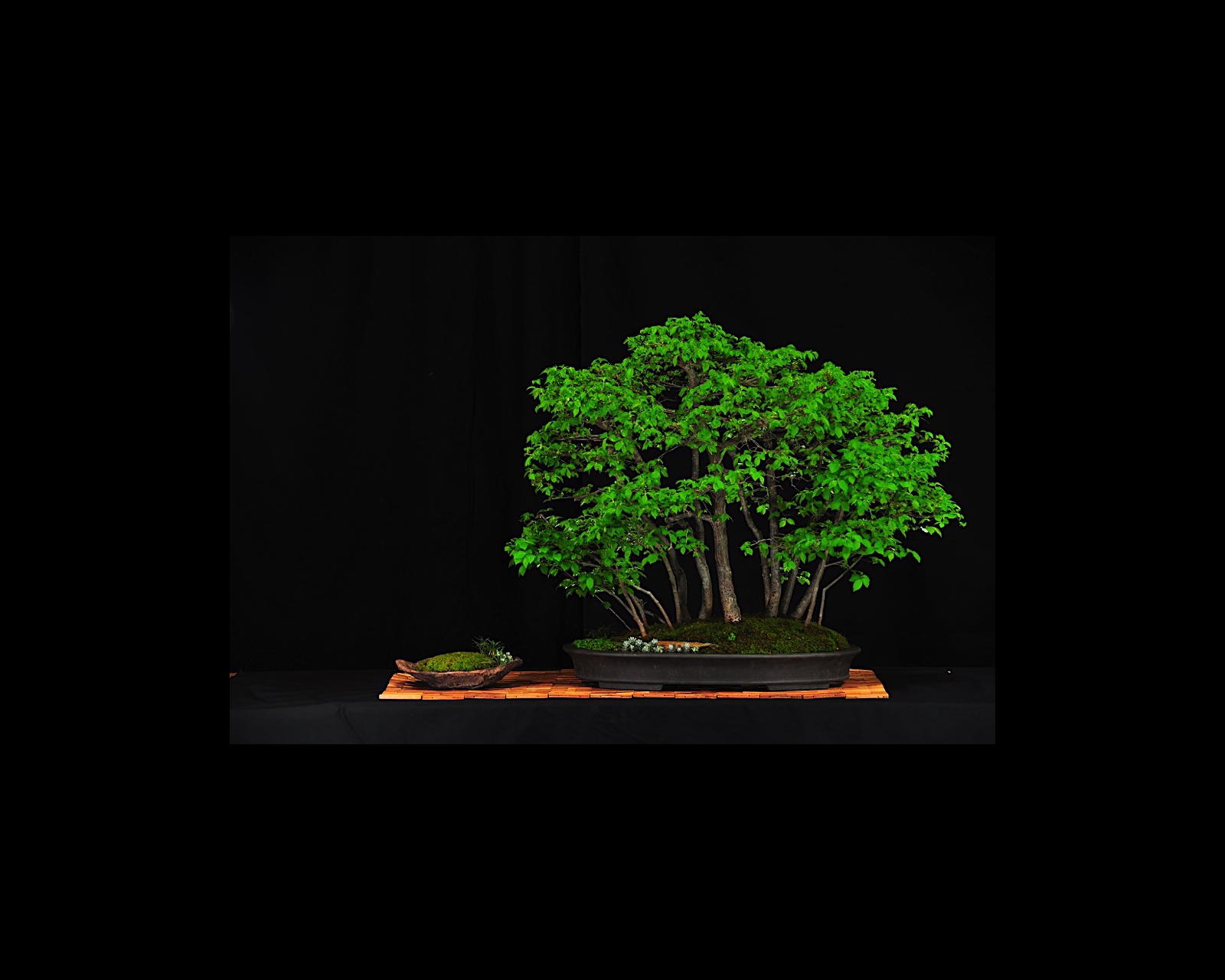 Ulmus minor. Age of tree - 18 years. Trained since 2010. The trees in this forest were dug from the site of the current Arboretum during a CBS dig in approximately 2004. They were first planted together in a forest in 2010.
Ulmus minor. Age of tree - 18 years. Trained since 2010. The trees in this forest were dug from the site of the current Arboretum during a CBS dig in approximately 2004. They were first planted together in a forest in 2010. 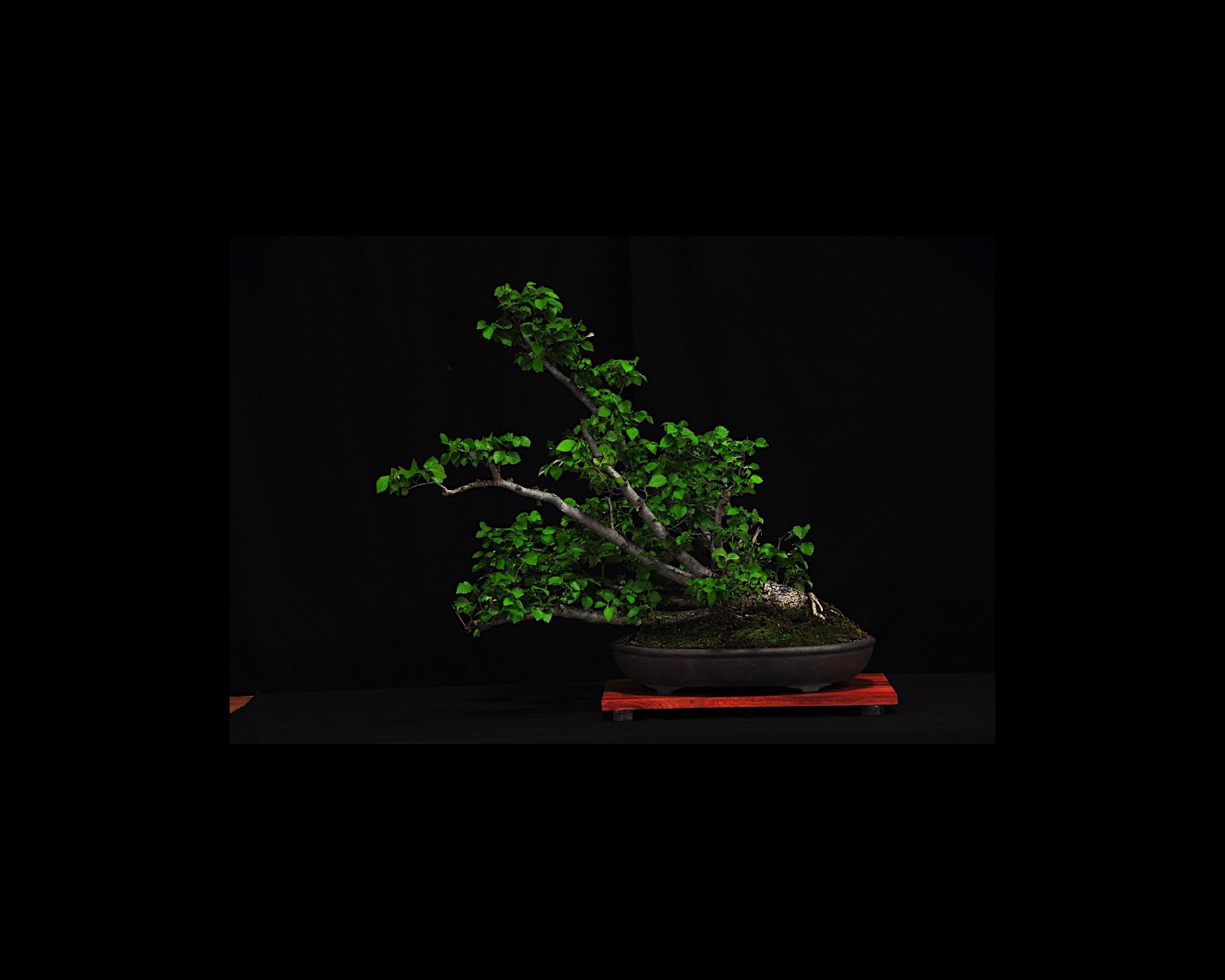 Ulmus procera. Age of tree - Unknown. Trained since 2012. This plant was dug from the side of the road . An old elm had been knocked down, giving rise to a forest of suckers. Its reverse-tapered stump made the reclining position necessary.
Ulmus procera. Age of tree - Unknown. Trained since 2012. This plant was dug from the side of the road . An old elm had been knocked down, giving rise to a forest of suckers. Its reverse-tapered stump made the reclining position necessary.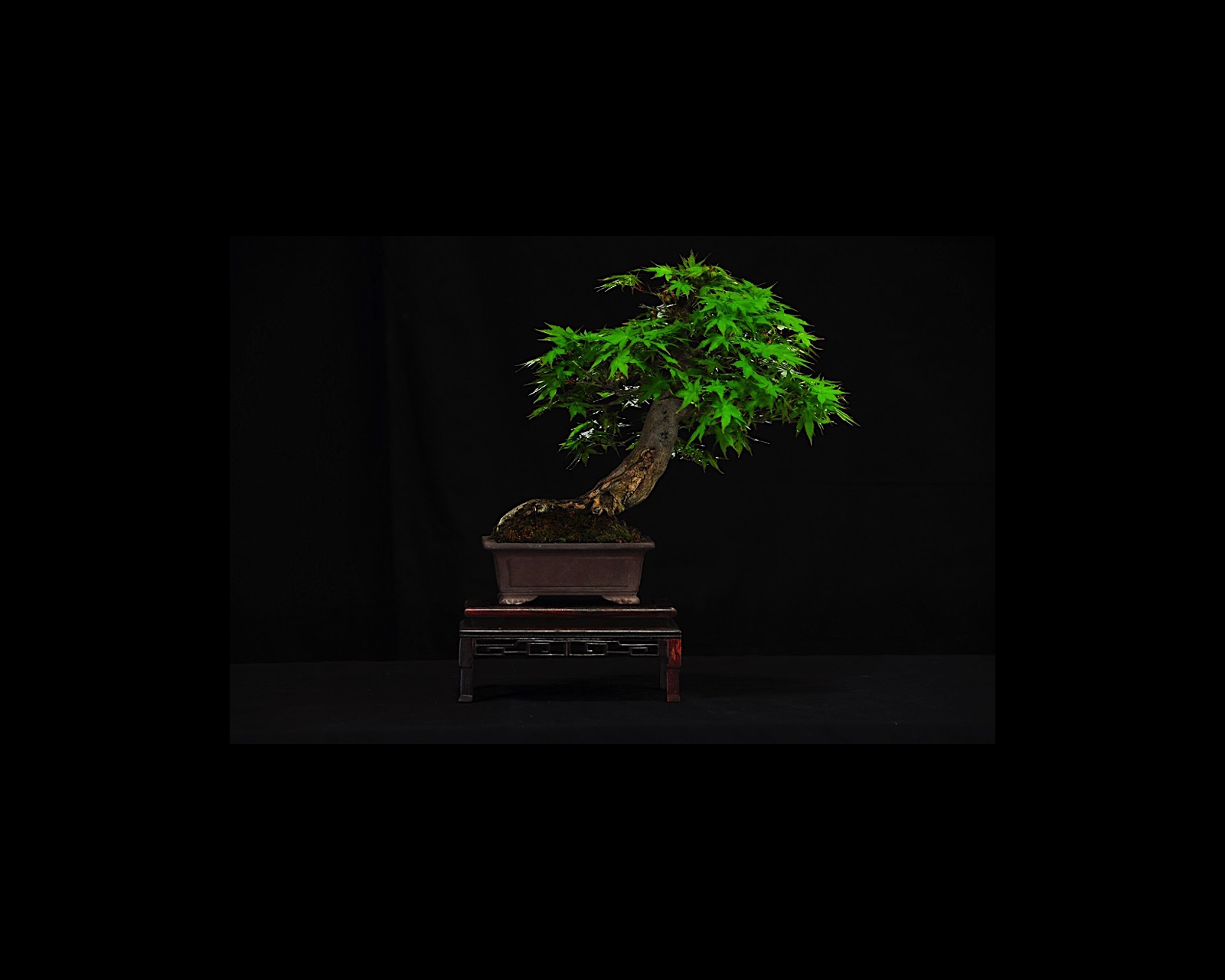 Acer palmatum. Age of tree - 15 years. Trained since 2012. This tree was ground-grown for a couple of years. The scarring resulted from cutting back a large root.
Acer palmatum. Age of tree - 15 years. Trained since 2012. This tree was ground-grown for a couple of years. The scarring resulted from cutting back a large root.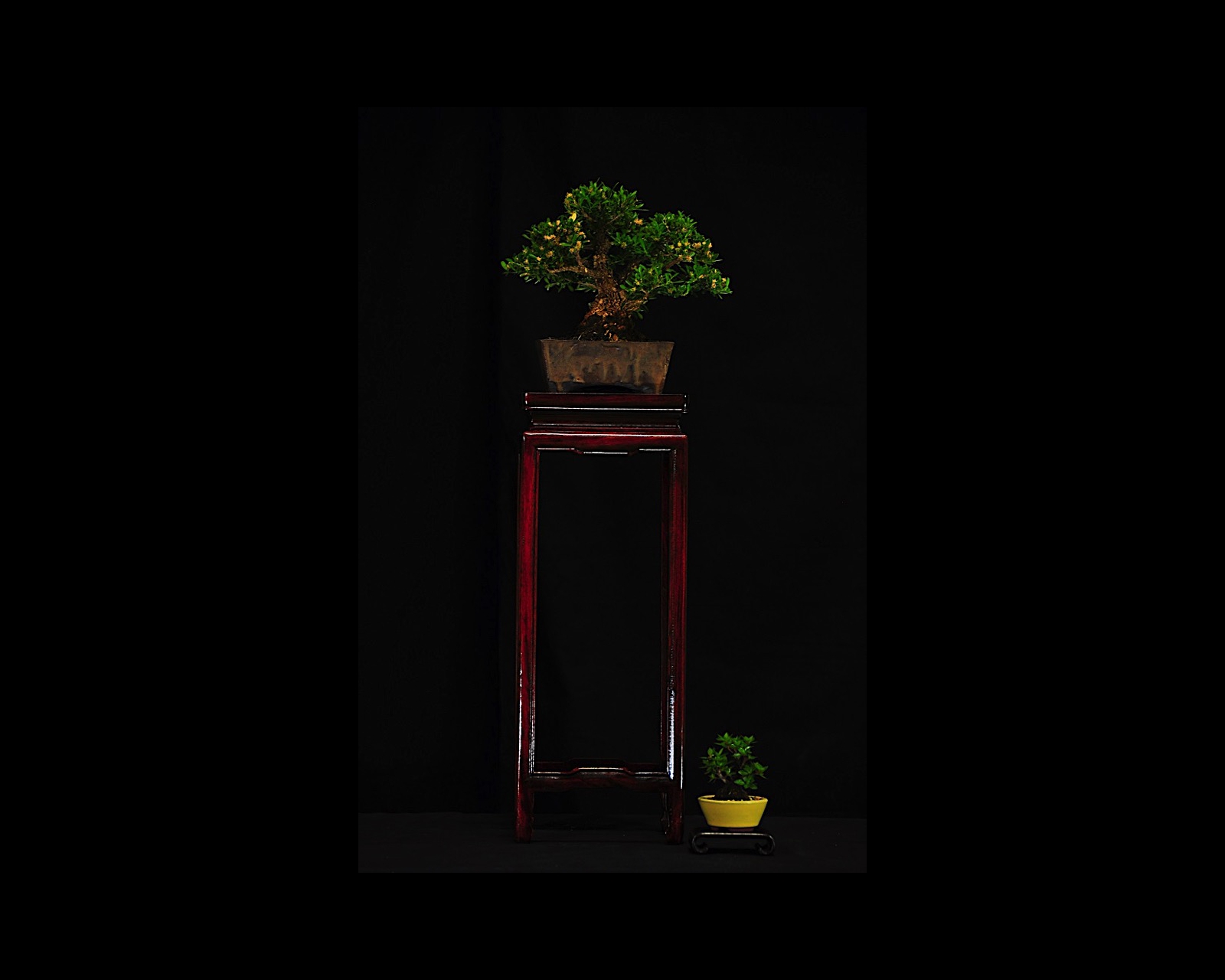 Buxus harlandii. Age of tree - 12 years. Trained since 2012. This bonsai was grown from a cutting and allowed to grow freely in plastic pots for a number of years to thicken the trunk. It was then cut back very hard and new growth trained partially with the use of wire but mostly just 'clip and grow' technique. It was potted this year into a Japanese Tokoname pot from the Izumiya kiln.
Buxus harlandii. Age of tree - 12 years. Trained since 2012. This bonsai was grown from a cutting and allowed to grow freely in plastic pots for a number of years to thicken the trunk. It was then cut back very hard and new growth trained partially with the use of wire but mostly just 'clip and grow' technique. It was potted this year into a Japanese Tokoname pot from the Izumiya kiln.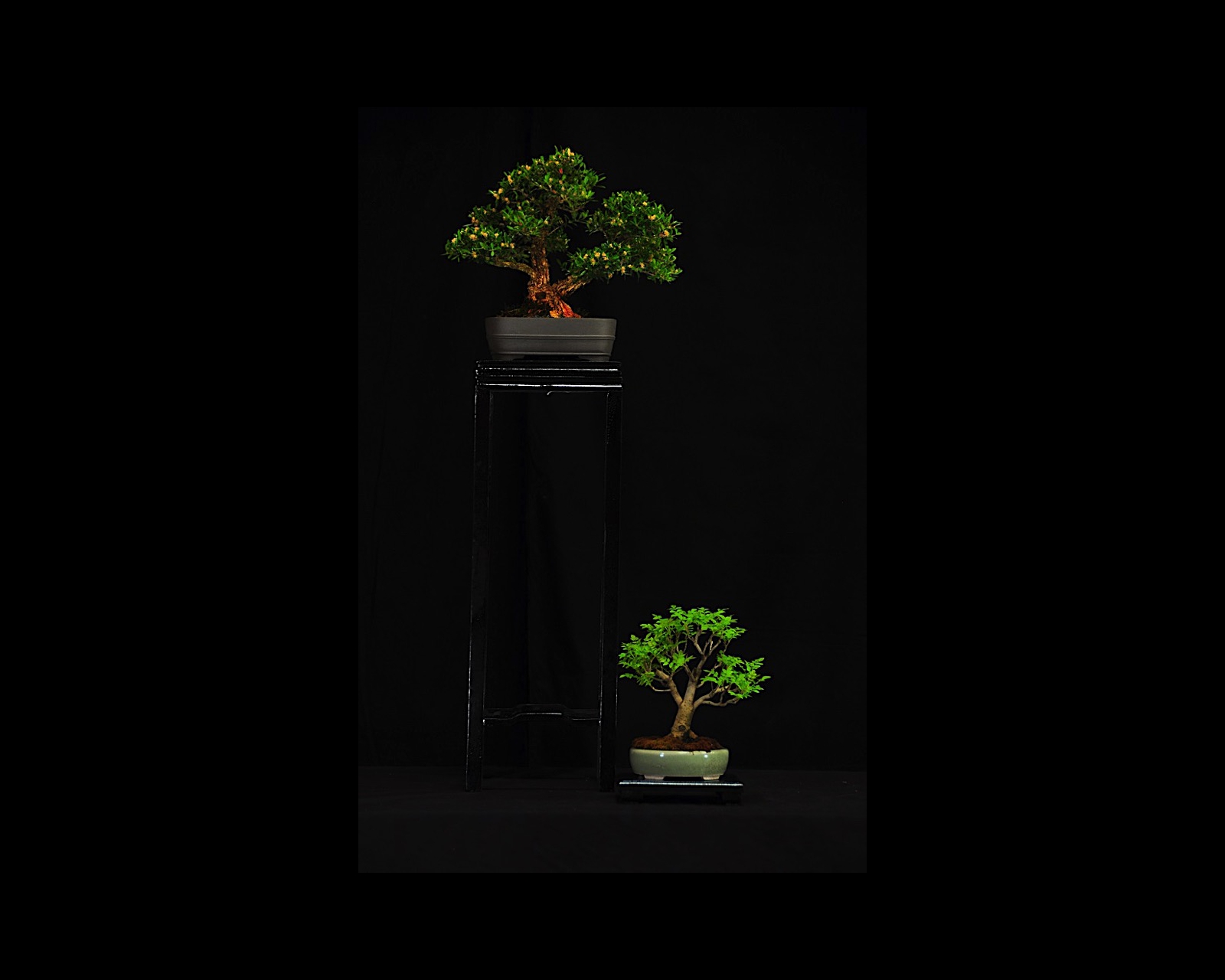 Buxus harlandii. Age of tree 12 years. Trained since 2012. This bonsai was grown from a cutting and allowed to grow freely in plastic pots for a number of years to thicken the trunk. It was then cut back very hard and new growth trained partially with the use of wire but mostly just 'clip and grow'. it was potted this year into an Australian made pot.
Buxus harlandii. Age of tree 12 years. Trained since 2012. This bonsai was grown from a cutting and allowed to grow freely in plastic pots for a number of years to thicken the trunk. It was then cut back very hard and new growth trained partially with the use of wire but mostly just 'clip and grow'. it was potted this year into an Australian made pot.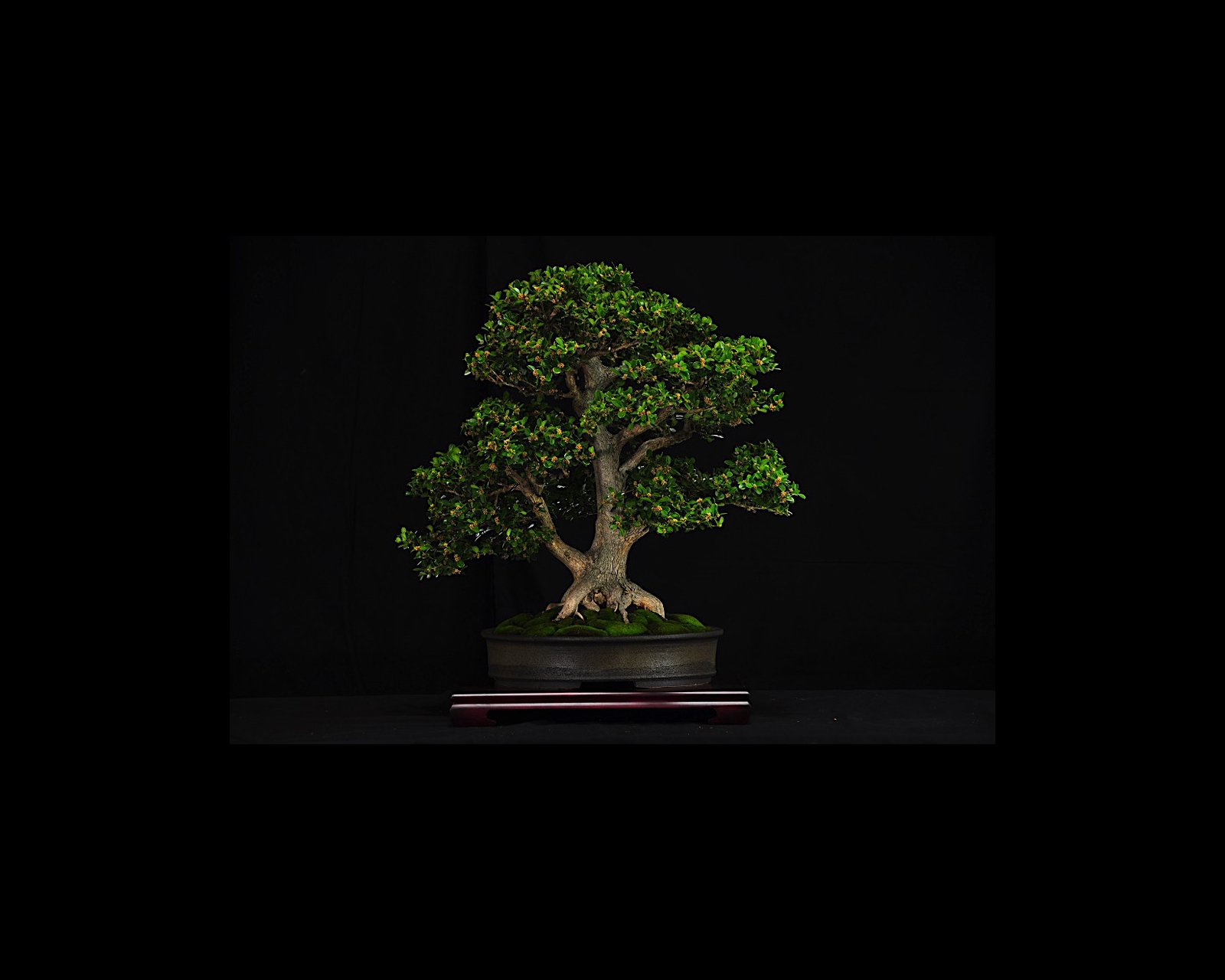 Buxus microphylla. Age of tree - Approx 25 years. Trained since 2012. This plant was dug from a garden in 2011 and was first worked on 2012 as it was very strong and healthy. It was workshopped with Pavol Slovak in 2016 and was planted into this Pat Kennedy pot in 2016.
Buxus microphylla. Age of tree - Approx 25 years. Trained since 2012. This plant was dug from a garden in 2011 and was first worked on 2012 as it was very strong and healthy. It was workshopped with Pavol Slovak in 2016 and was planted into this Pat Kennedy pot in 2016.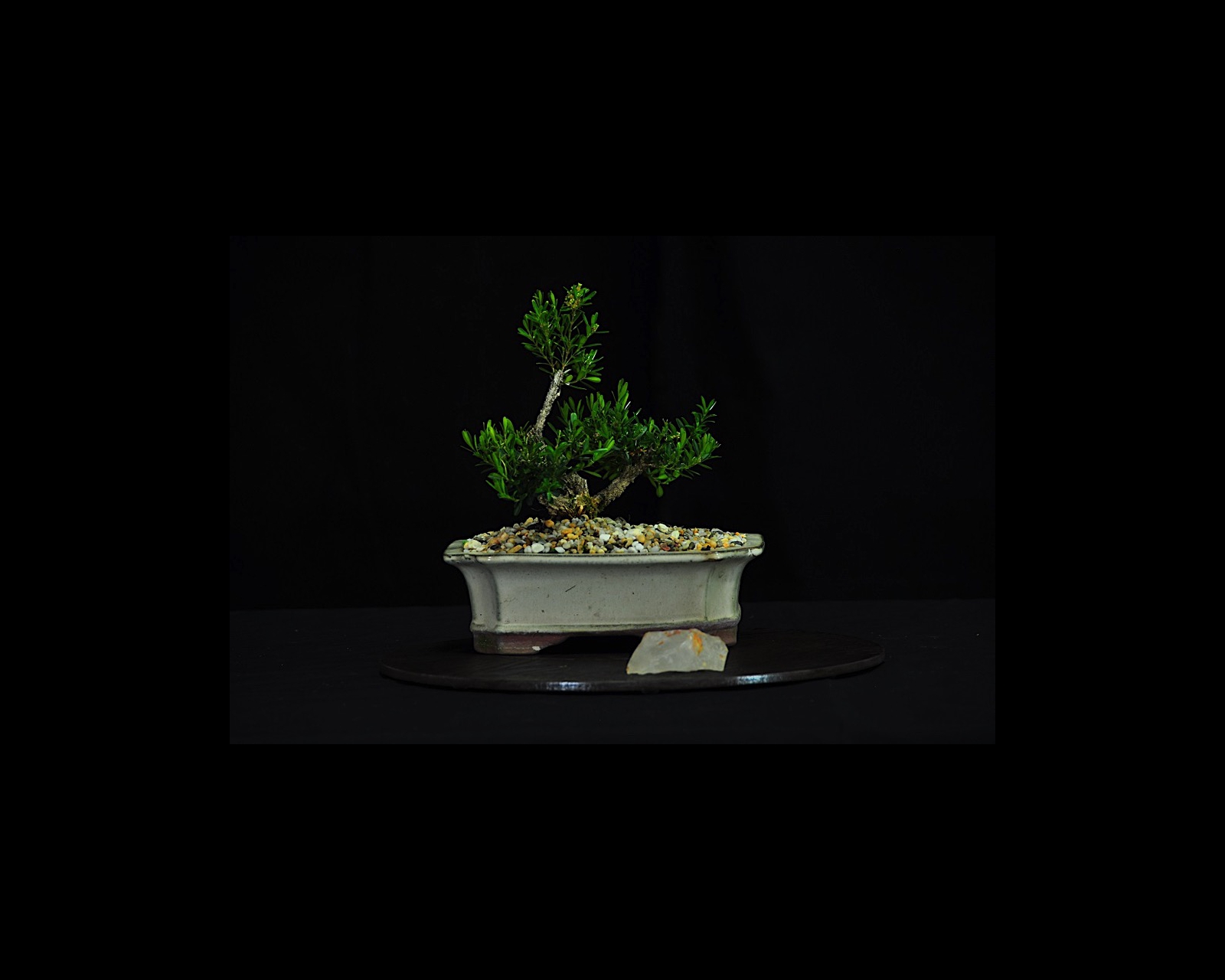 Buxus harlandii 'Mystique'. Age of tree Approximately 5 years. Trained since 2012. This plant was one of a group at CBS. It was cut back shortly afterwards and I have slowly developed its current shape by clip and grow method.
Buxus harlandii 'Mystique'. Age of tree Approximately 5 years. Trained since 2012. This plant was one of a group at CBS. It was cut back shortly afterwards and I have slowly developed its current shape by clip and grow method.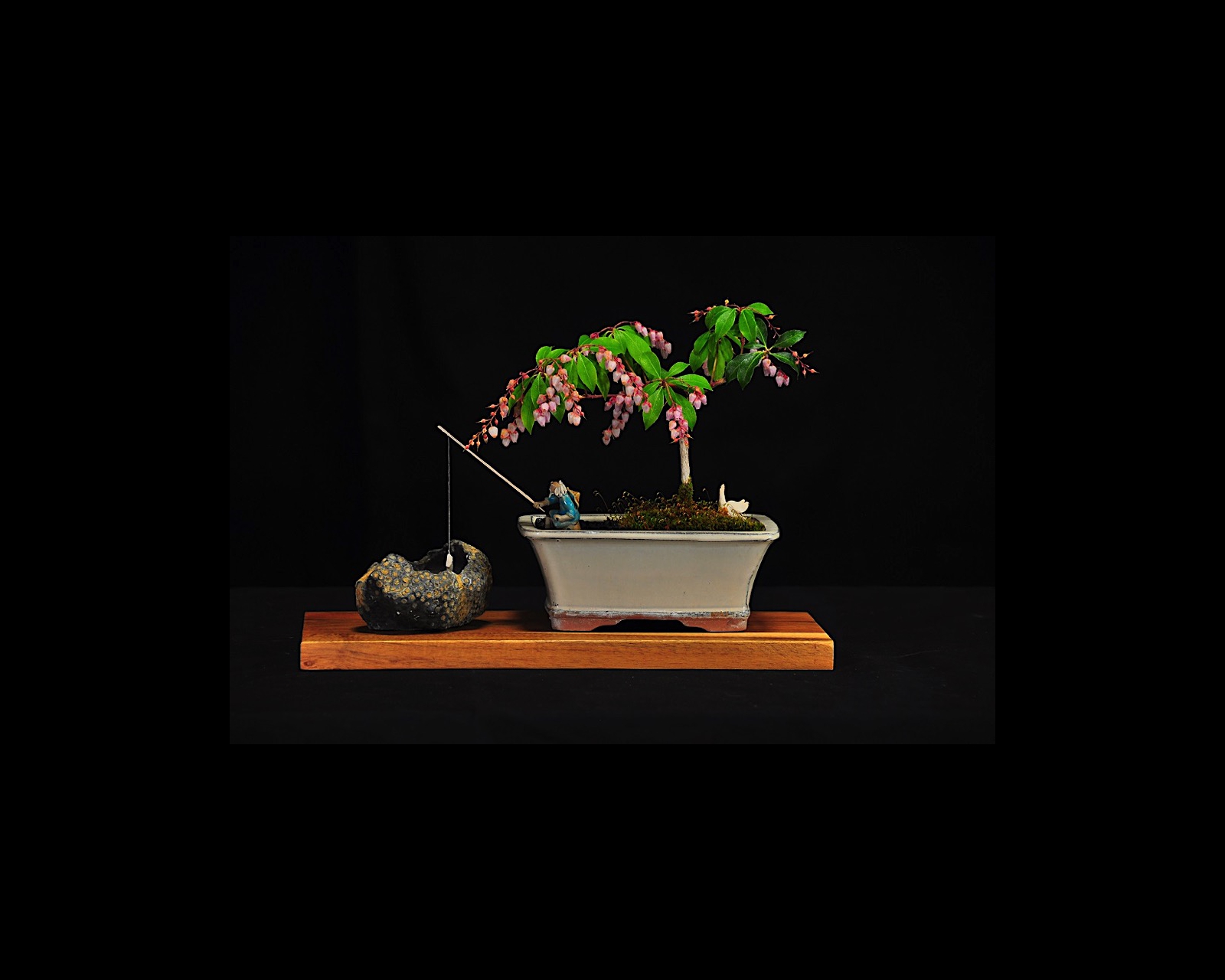 Pieris japonica. Age of tree 6 years. Trained since 2012. This Pieris japonica was from a bonsai nursery and bloomed for the first time this year - also sometimes named 'Christmas Bells' when I walked out and saw the flowers it felt like Christmas! Seeing a tree flower for the first time is so exciting - quite often flowering trees have buds pinched off as flowers take a lot of energy to produce. Until the trunk is at least strong enough to support them it's wise not to divert the growth into flower production.
Pieris japonica. Age of tree 6 years. Trained since 2012. This Pieris japonica was from a bonsai nursery and bloomed for the first time this year - also sometimes named 'Christmas Bells' when I walked out and saw the flowers it felt like Christmas! Seeing a tree flower for the first time is so exciting - quite often flowering trees have buds pinched off as flowers take a lot of energy to produce. Until the trunk is at least strong enough to support them it's wise not to divert the growth into flower production.
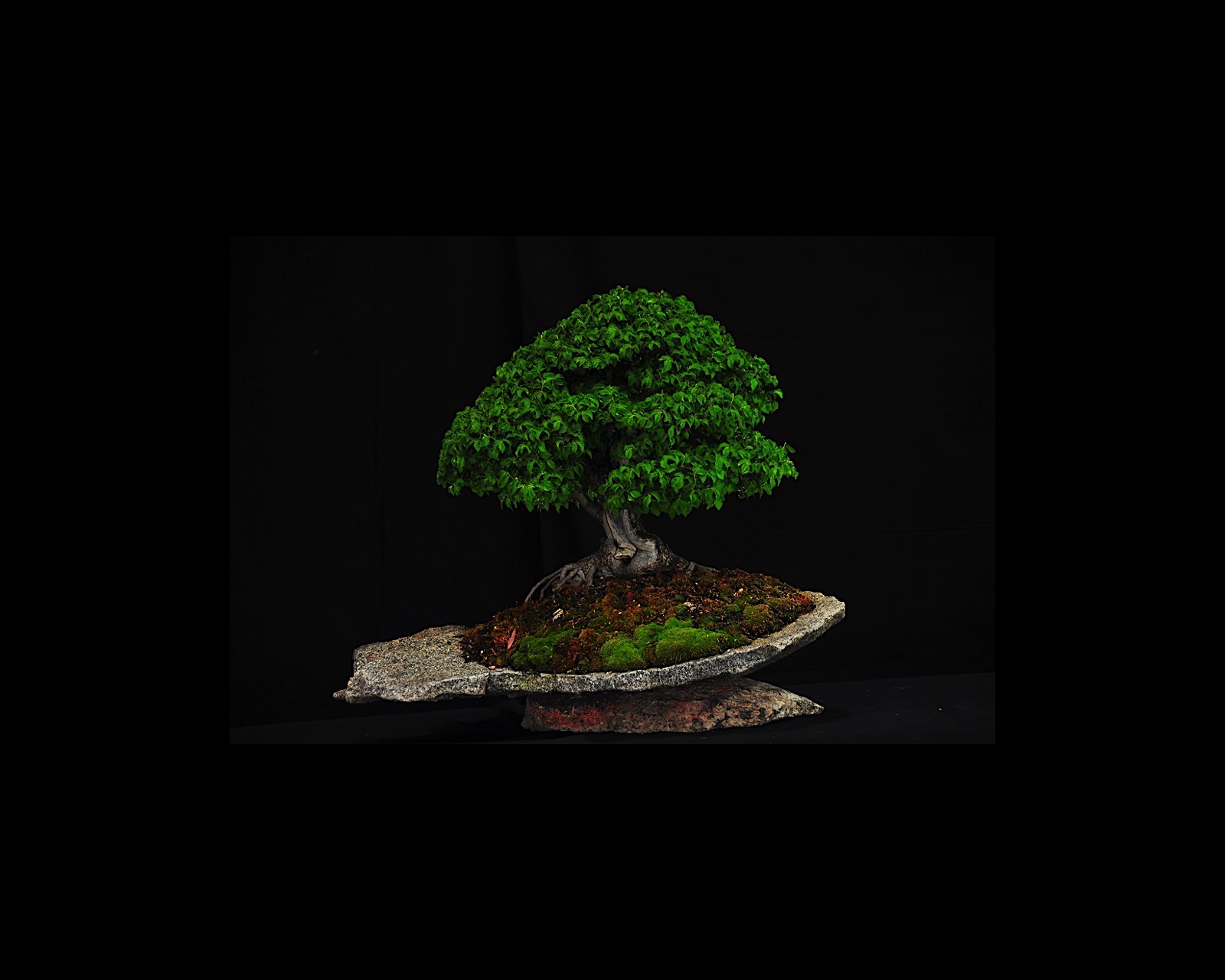 Ulmus pumila. Age of tree Unknown. Trained since 2013. This bonsai was developed from a sucker collected from a sheep paddock. The tree was close to an electric fence, but sheep and cattle still managed to reach it and trim and break the tree. it has been trained using the clip and grow method. It is planted on a natural granite slab collected from Crackenback and gifted to me by Craig C.
Ulmus pumila. Age of tree Unknown. Trained since 2013. This bonsai was developed from a sucker collected from a sheep paddock. The tree was close to an electric fence, but sheep and cattle still managed to reach it and trim and break the tree. it has been trained using the clip and grow method. It is planted on a natural granite slab collected from Crackenback and gifted to me by Craig C.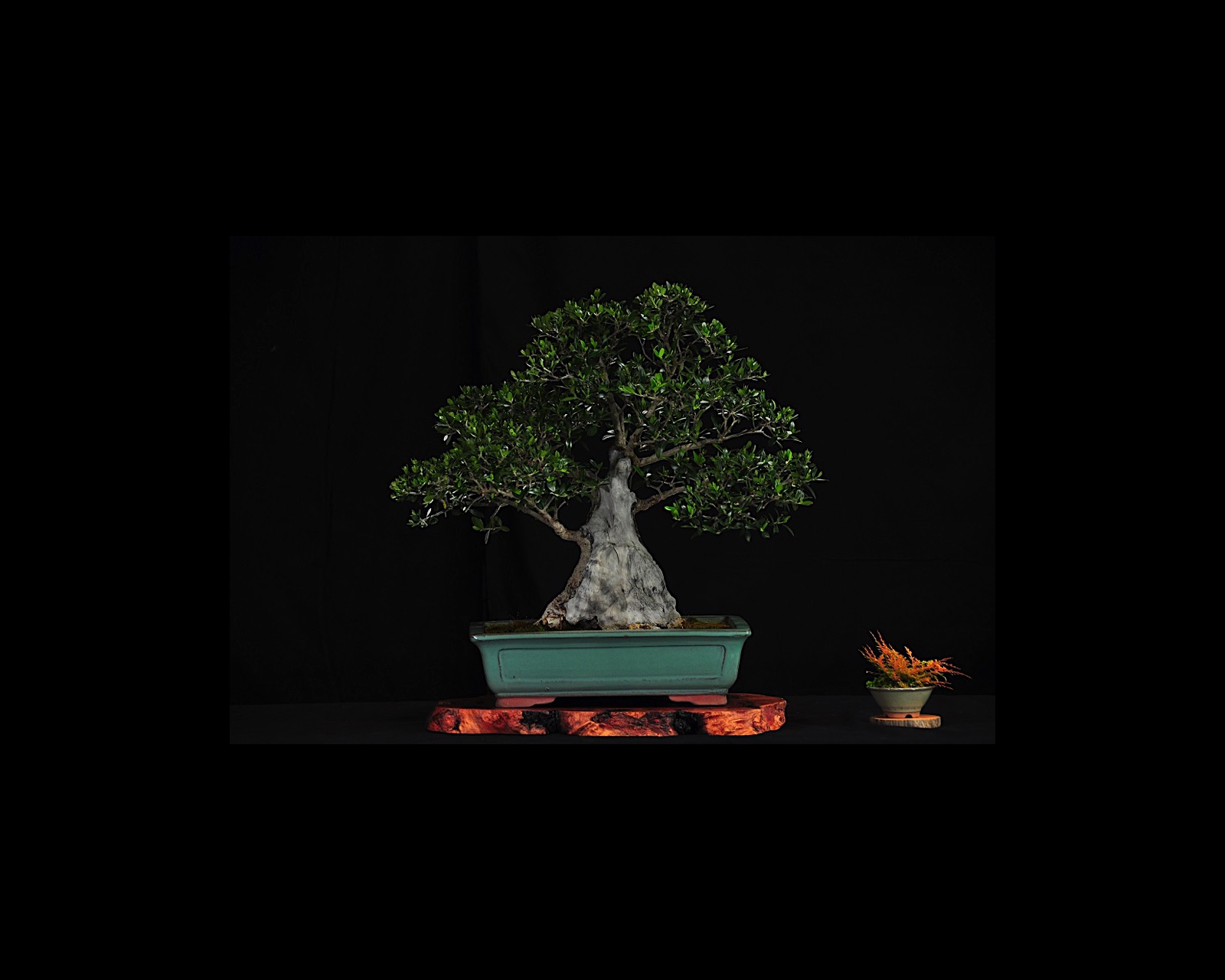 Olea europaea. Age of tree 28 years. Trained since 2013. This tree is a ‘yamadori’ collected in Adelaide at a dig held during the AABC Convention in 1998. Very little work was done on it for many years, with the benign neglect resulting in the natural occurring ‘shari’ (deadwood) on the lower trunk. In 2013, the upper part of the trunk was carved to extend the deadwood, first styling of the branches was begun, and the tree was potted into a bonsai pot.
Olea europaea. Age of tree 28 years. Trained since 2013. This tree is a ‘yamadori’ collected in Adelaide at a dig held during the AABC Convention in 1998. Very little work was done on it for many years, with the benign neglect resulting in the natural occurring ‘shari’ (deadwood) on the lower trunk. In 2013, the upper part of the trunk was carved to extend the deadwood, first styling of the branches was begun, and the tree was potted into a bonsai pot.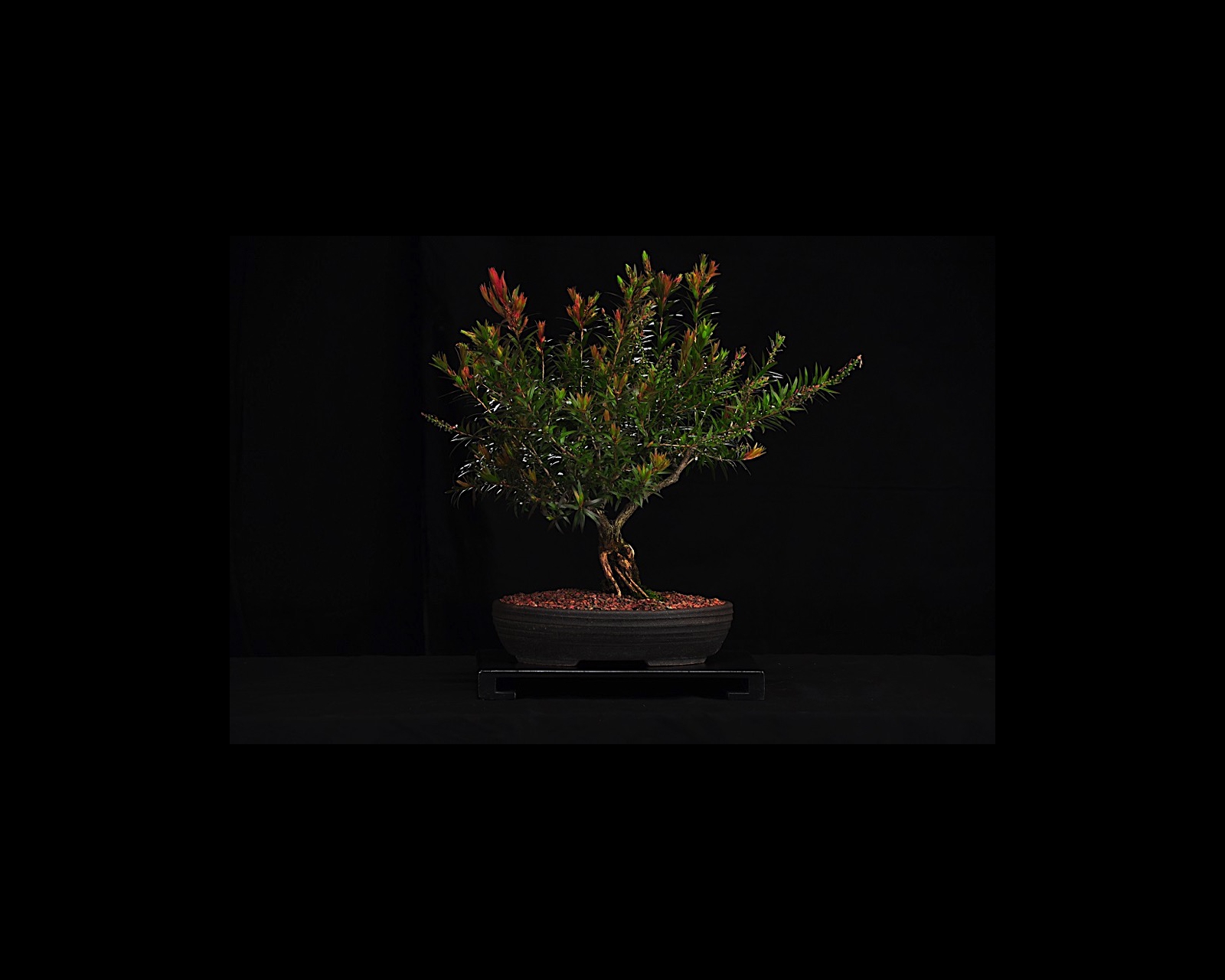 Callistemon sp. Age of tree 8 years. Trained since 2013. This started as nursery stock which has been allowed to grow in a natural style with minimal clipping. This is the first year that it has flowered.
Callistemon sp. Age of tree 8 years. Trained since 2013. This started as nursery stock which has been allowed to grow in a natural style with minimal clipping. This is the first year that it has flowered. Pinus thunbergii. Age of tree 10 years. Trained since 2013. This bonsai was initially styled from raw stock in 2013.
Pinus thunbergii. Age of tree 10 years. Trained since 2013. This bonsai was initially styled from raw stock in 2013.
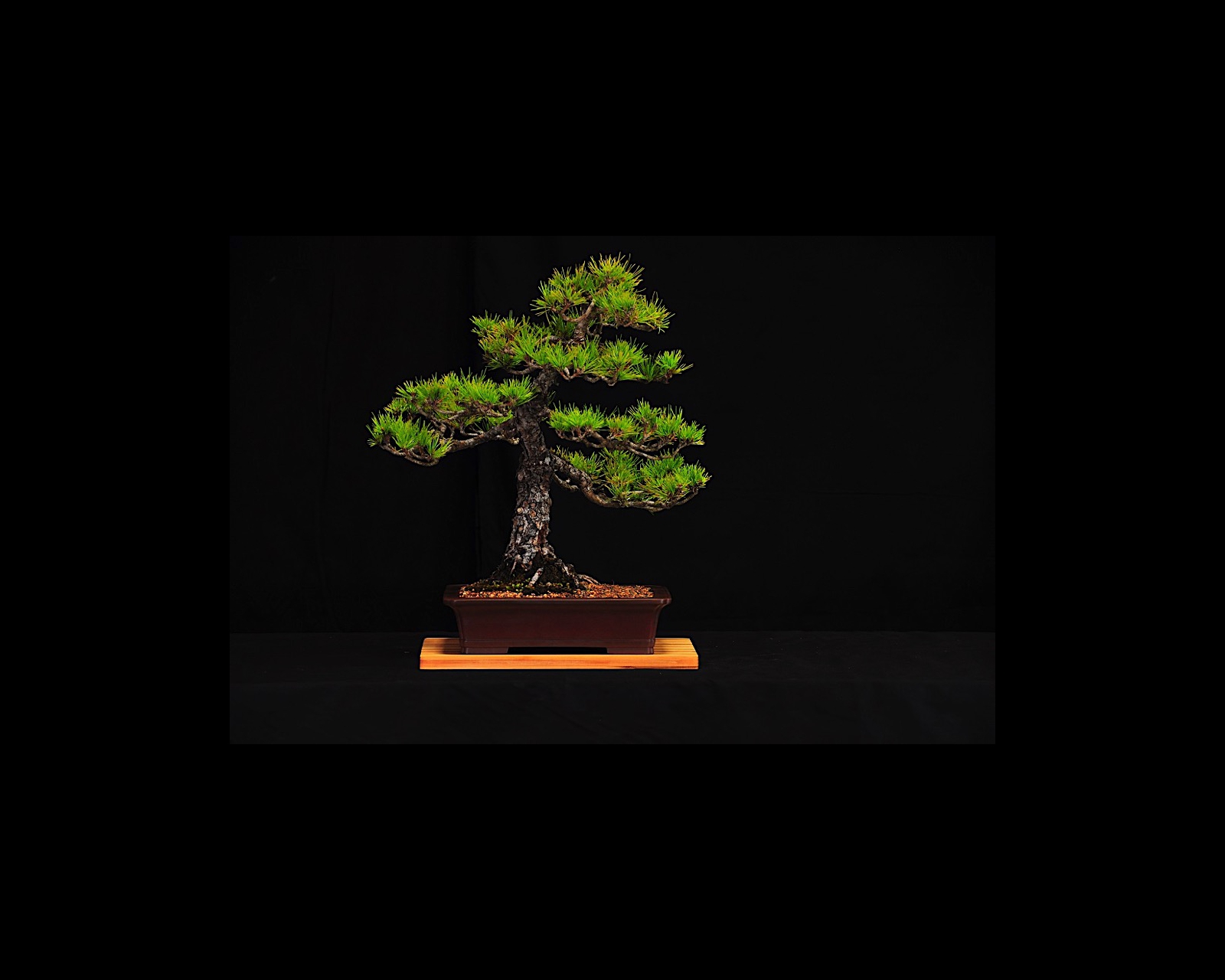 Pinus thunbergii. Age of tree 25 years. Trained since 2013. This bonsai was first styled from raw stock at workshop with Grant Bowie in 2013. I have subsequent continued its styling and refinement.
Pinus thunbergii. Age of tree 25 years. Trained since 2013. This bonsai was first styled from raw stock at workshop with Grant Bowie in 2013. I have subsequent continued its styling and refinement.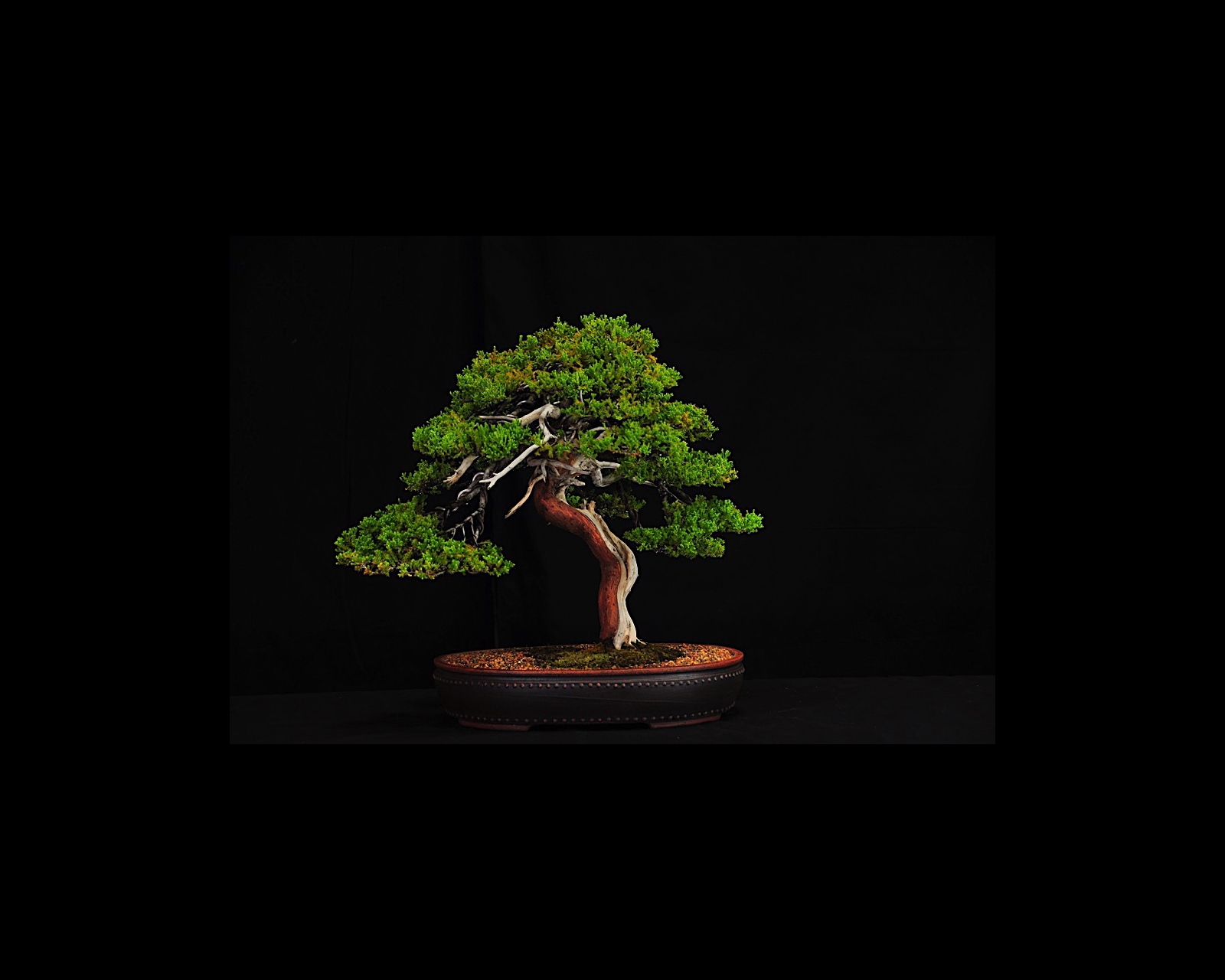 Juniperus squamata. Age of tree 27 years. Trained since 2013. This bonsai was first styled as part of a workshop with Ryan Neil in 2013. I have since continued its styling and refinement.
Juniperus squamata. Age of tree 27 years. Trained since 2013. This bonsai was first styled as part of a workshop with Ryan Neil in 2013. I have since continued its styling and refinement.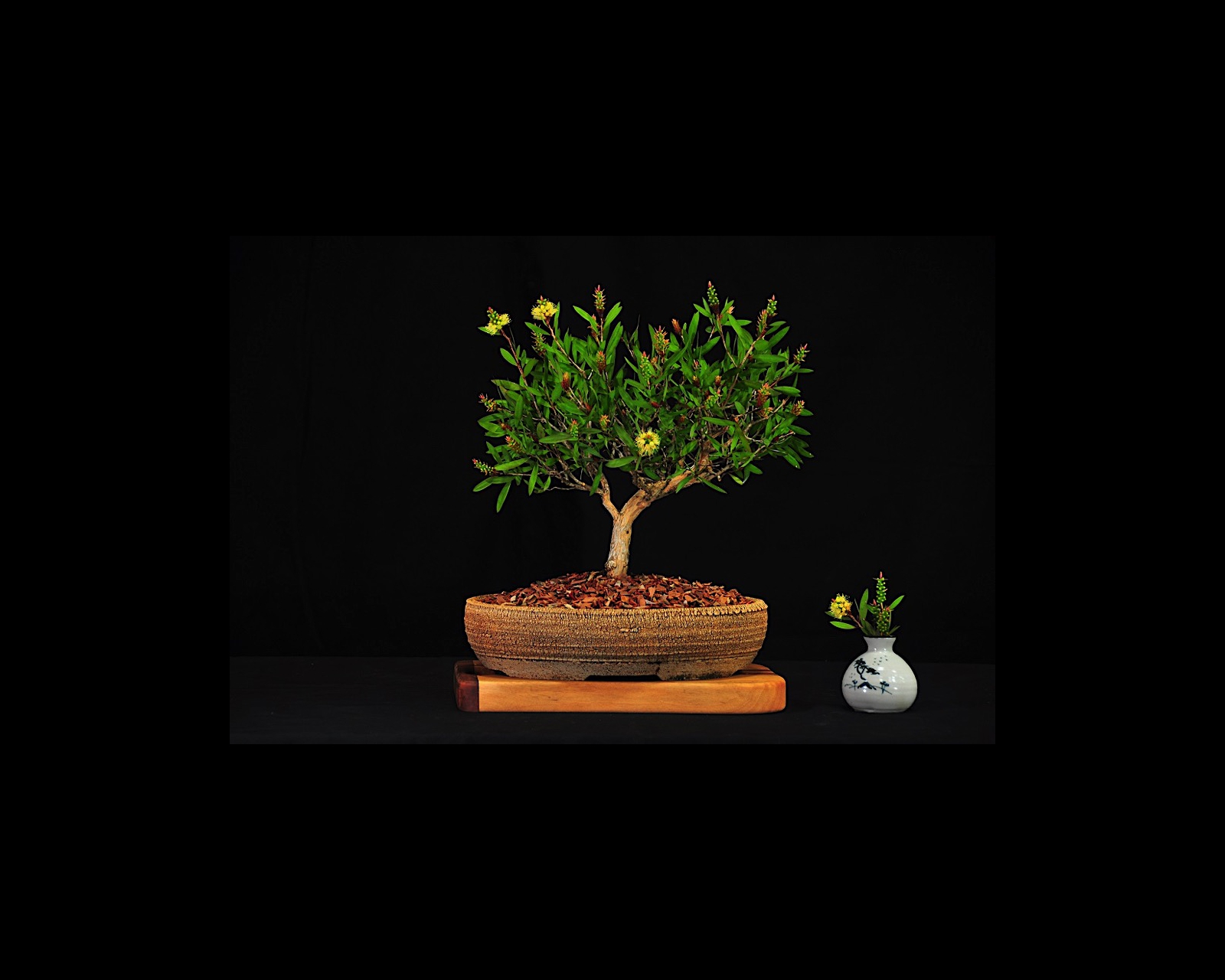 Callistemon. Age of tree Unknown. Trained since 2013. This tree was one of the first bonsai I created after joining the Canberra Bonsai Club. It was nursery stock, bought in Jindabyne early 2013. Can you see the signs of a beginner ‘artist’? I chose a bent tree because it had movement. I clipped, and the tree grew for three years to create the branch structure and it grew skyward in a broom style. The fourth year of styling I had a nice compact tree, but, I practiced restraint (no clipping last season’s growth) and the tree responded with this floral display.
Callistemon. Age of tree Unknown. Trained since 2013. This tree was one of the first bonsai I created after joining the Canberra Bonsai Club. It was nursery stock, bought in Jindabyne early 2013. Can you see the signs of a beginner ‘artist’? I chose a bent tree because it had movement. I clipped, and the tree grew for three years to create the branch structure and it grew skyward in a broom style. The fourth year of styling I had a nice compact tree, but, I practiced restraint (no clipping last season’s growth) and the tree responded with this floral display.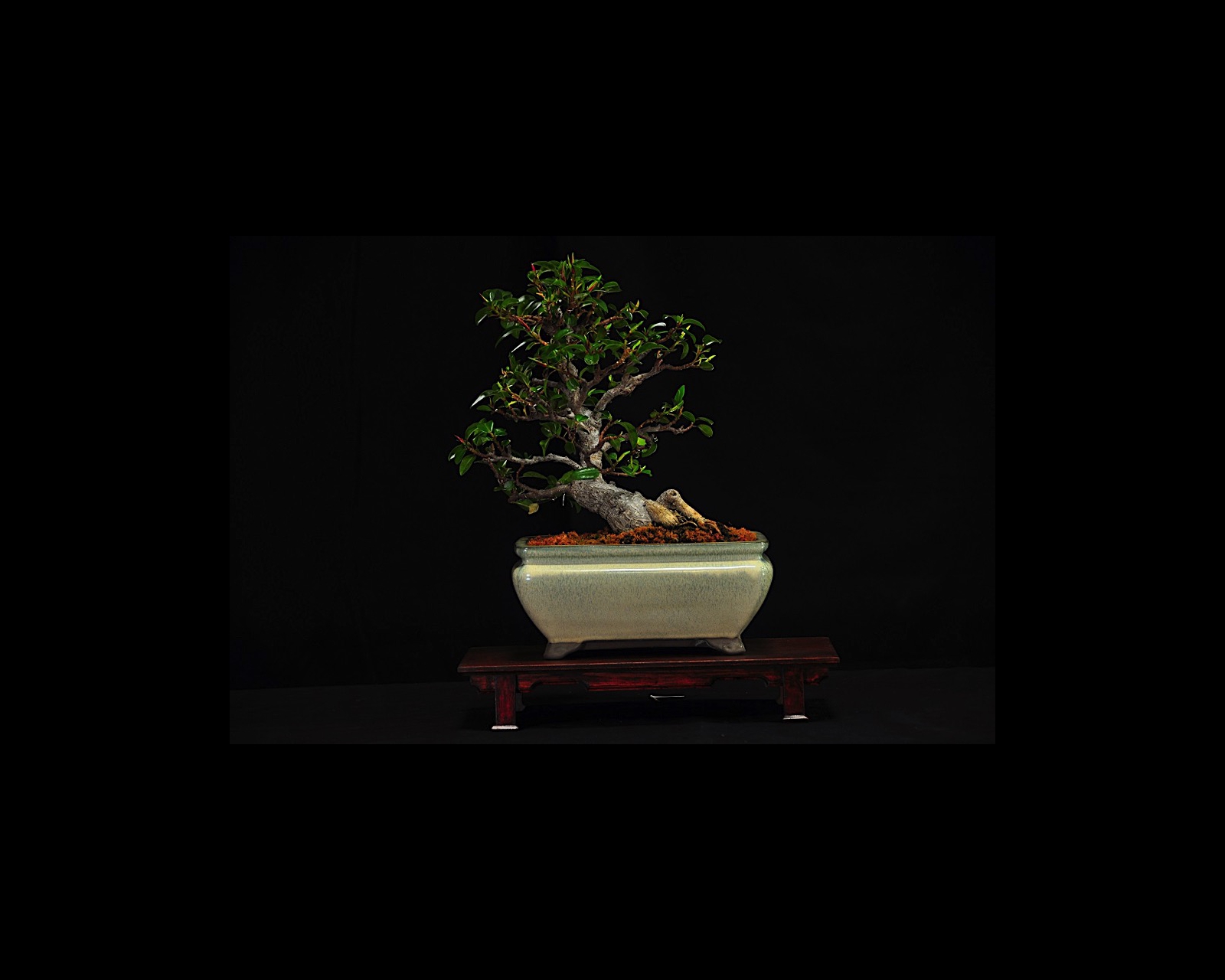 Ficus sp. Age of tree 8 years. Trained since 2013. This bonsai was one of my grandmother’s favourites and represented her style. The fig has been styled as if it was windswept or had fallen over and re-grown. My grandmother planted the tree on a slant to give it a different aspect to the viewer. The moss gives the effect of a tree in a natural environment.
Ficus sp. Age of tree 8 years. Trained since 2013. This bonsai was one of my grandmother’s favourites and represented her style. The fig has been styled as if it was windswept or had fallen over and re-grown. My grandmother planted the tree on a slant to give it a different aspect to the viewer. The moss gives the effect of a tree in a natural environment.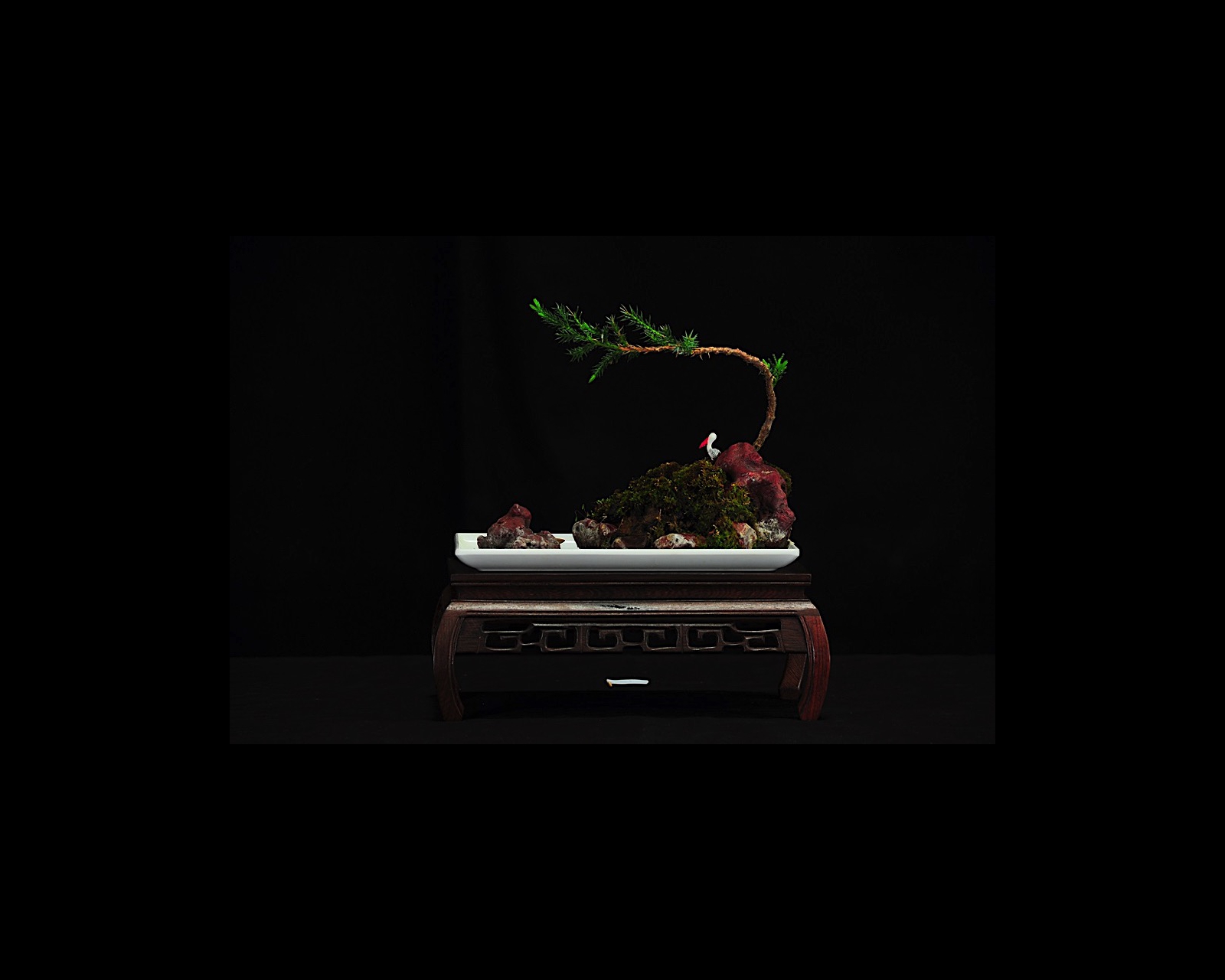 Juniperus chinensis. Age of tree 5 years. Trained since 2013. This Chinese juniper is from nursery stock and was my first island landscape. The juniper is an informal upright shaped to draw the eye along the island and the moss that decorates it and create a positive flow of energy (feng shui). My inspiration comes from the amazing penjing landscapes at the NBPCA and memories of the tiny islands I had the pleasure to sail around and see so many of during my time in the Navy.
Juniperus chinensis. Age of tree 5 years. Trained since 2013. This Chinese juniper is from nursery stock and was my first island landscape. The juniper is an informal upright shaped to draw the eye along the island and the moss that decorates it and create a positive flow of energy (feng shui). My inspiration comes from the amazing penjing landscapes at the NBPCA and memories of the tiny islands I had the pleasure to sail around and see so many of during my time in the Navy. 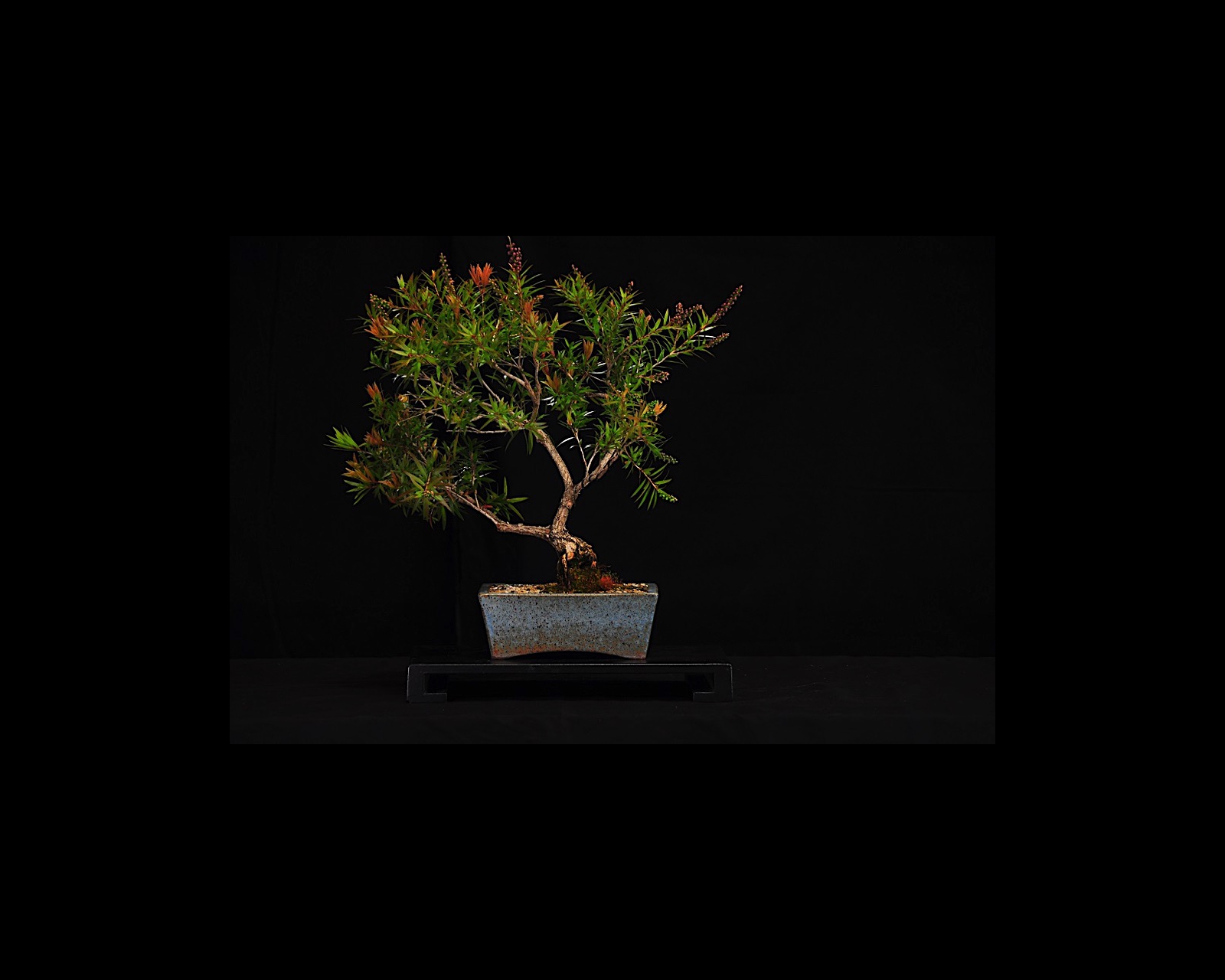 Callistemon sp. Age of tree 6 years. Trained since 2014. This plant was reject nursery stock. I rescued it and allowed it to grow on with only a little clipping. This is its first year of flowering.
Callistemon sp. Age of tree 6 years. Trained since 2014. This plant was reject nursery stock. I rescued it and allowed it to grow on with only a little clipping. This is its first year of flowering. 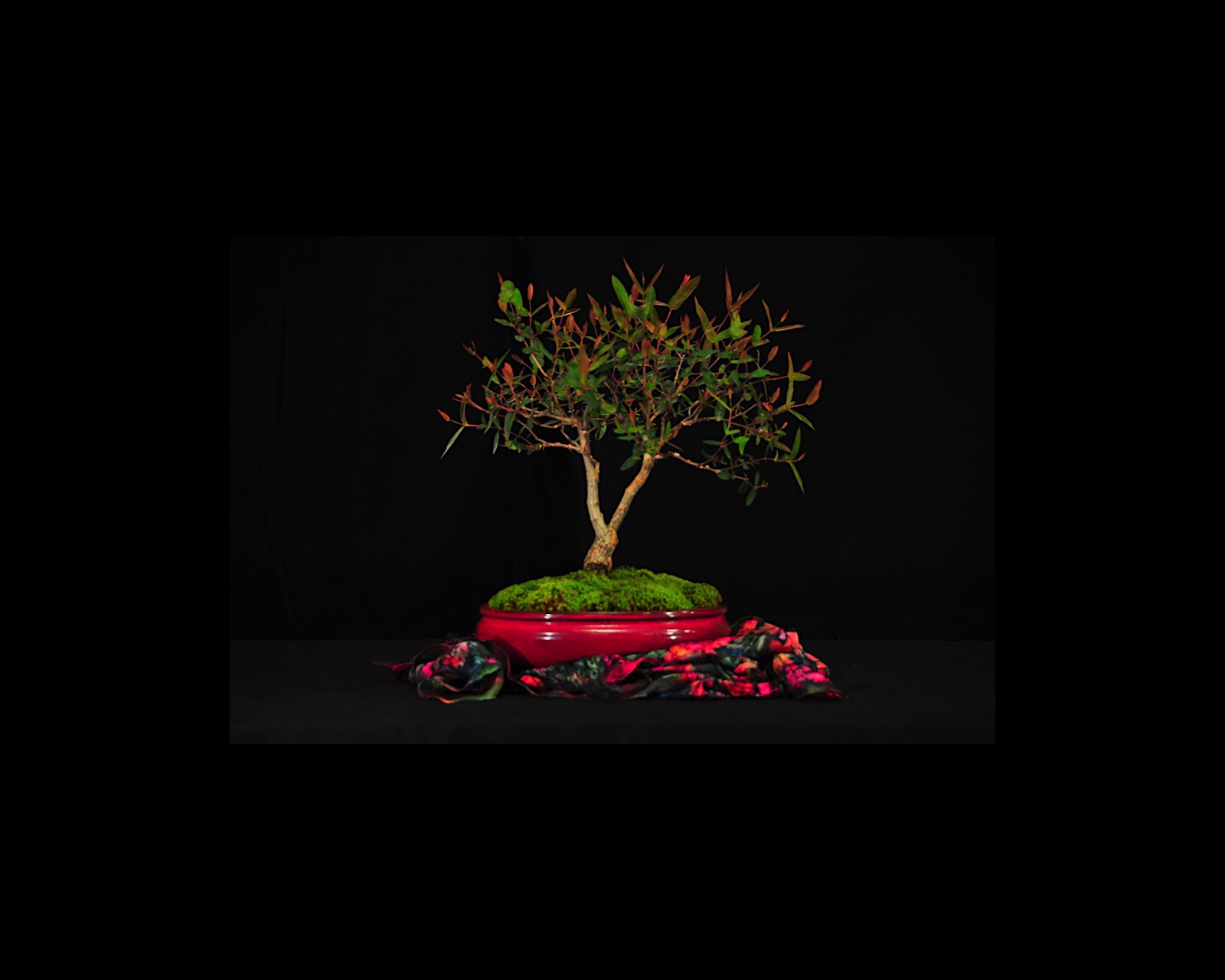 Angophora floribunda. Age of tree 6 years. Trained since 2014. This tree started life as nursery tube stock and the trunk had some thickness when purchased. The new foliage tends to grow bigger than desirable but has great colour.
Angophora floribunda. Age of tree 6 years. Trained since 2014. This tree started life as nursery tube stock and the trunk had some thickness when purchased. The new foliage tends to grow bigger than desirable but has great colour.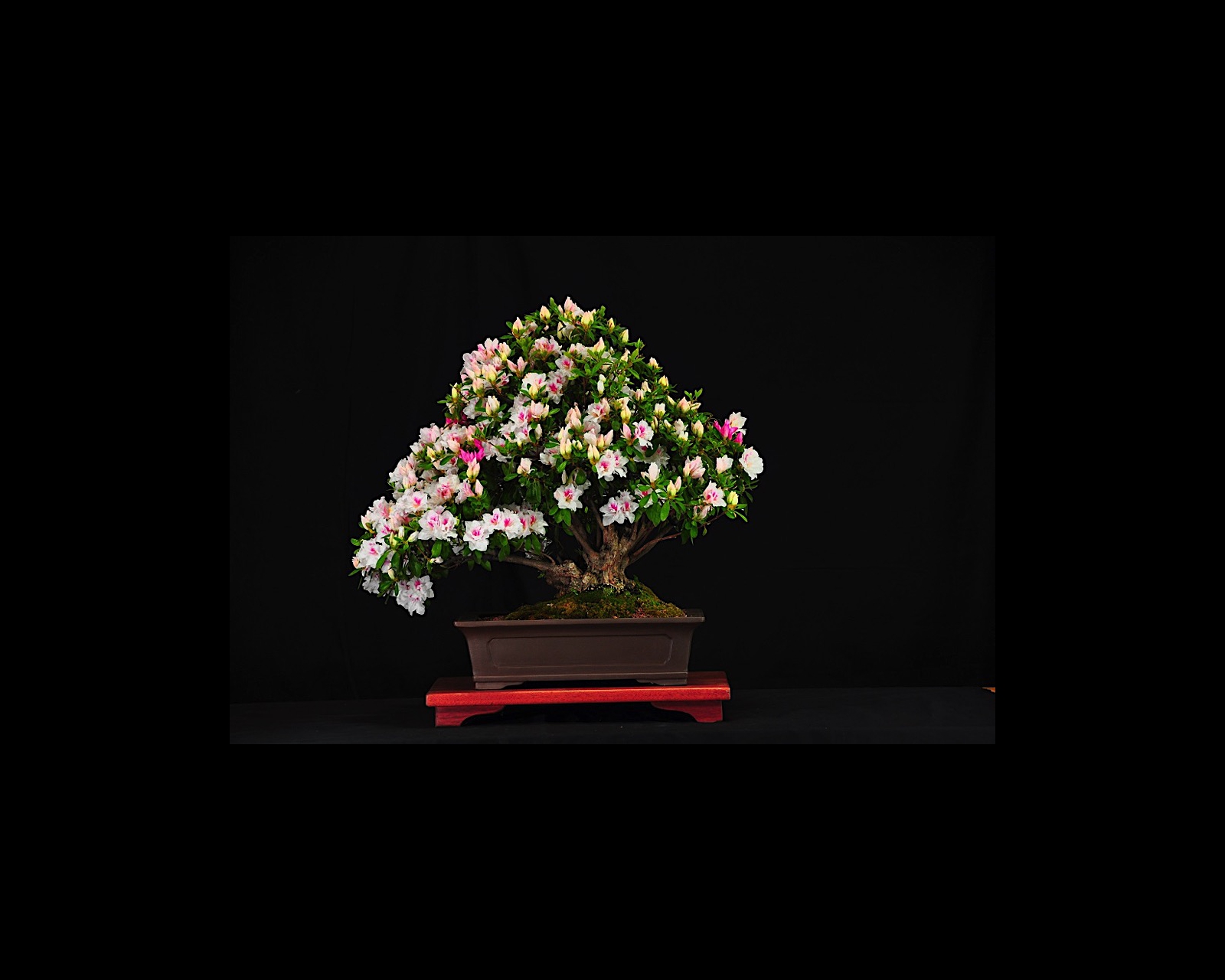 Rhododendron. Age of tree 43 years. Trained since 2014. Three years ago, I bought this plant from a nursery as a 40-year old plant. It was much taller and I have cut it down and shaped it over the last three years. The base gives a great sense of age and the mixture of pink and white flowers is very appealing.
Rhododendron. Age of tree 43 years. Trained since 2014. Three years ago, I bought this plant from a nursery as a 40-year old plant. It was much taller and I have cut it down and shaped it over the last three years. The base gives a great sense of age and the mixture of pink and white flowers is very appealing.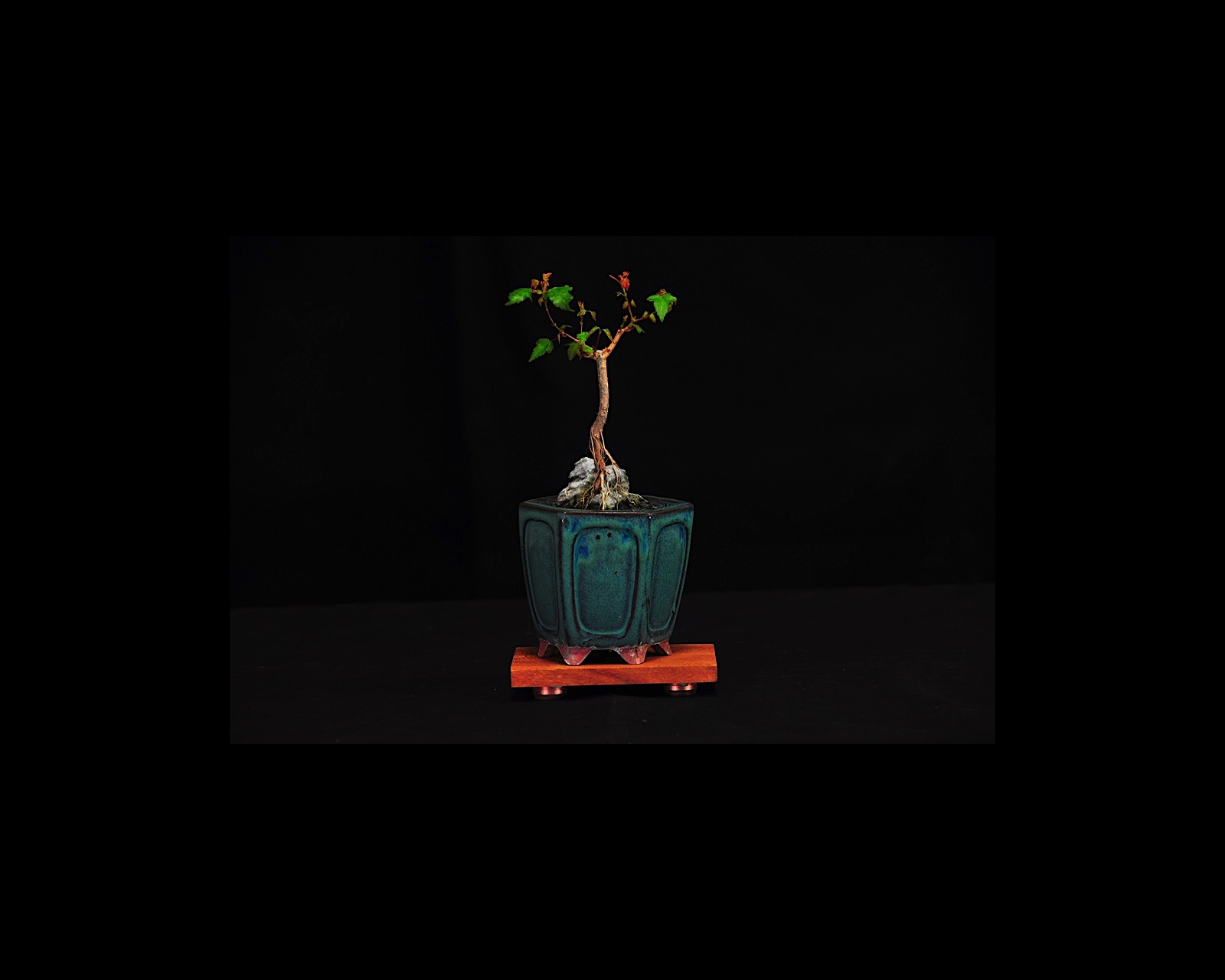 Acer buergerianum. Age of tree 5 years. Trained since 2014. This trident maple is from dry root nursery stock that came to me as a two year old plant. The amazing roots he came with showed he was destined to become a root over rock style bonsai. Each year I repot him and expose an extra centimetre or two of roots. I anticipate if will take another decade or so to get it to the point where the majority of the rock and roots will be on display on a shallow marble tray.
Acer buergerianum. Age of tree 5 years. Trained since 2014. This trident maple is from dry root nursery stock that came to me as a two year old plant. The amazing roots he came with showed he was destined to become a root over rock style bonsai. Each year I repot him and expose an extra centimetre or two of roots. I anticipate if will take another decade or so to get it to the point where the majority of the rock and roots will be on display on a shallow marble tray.
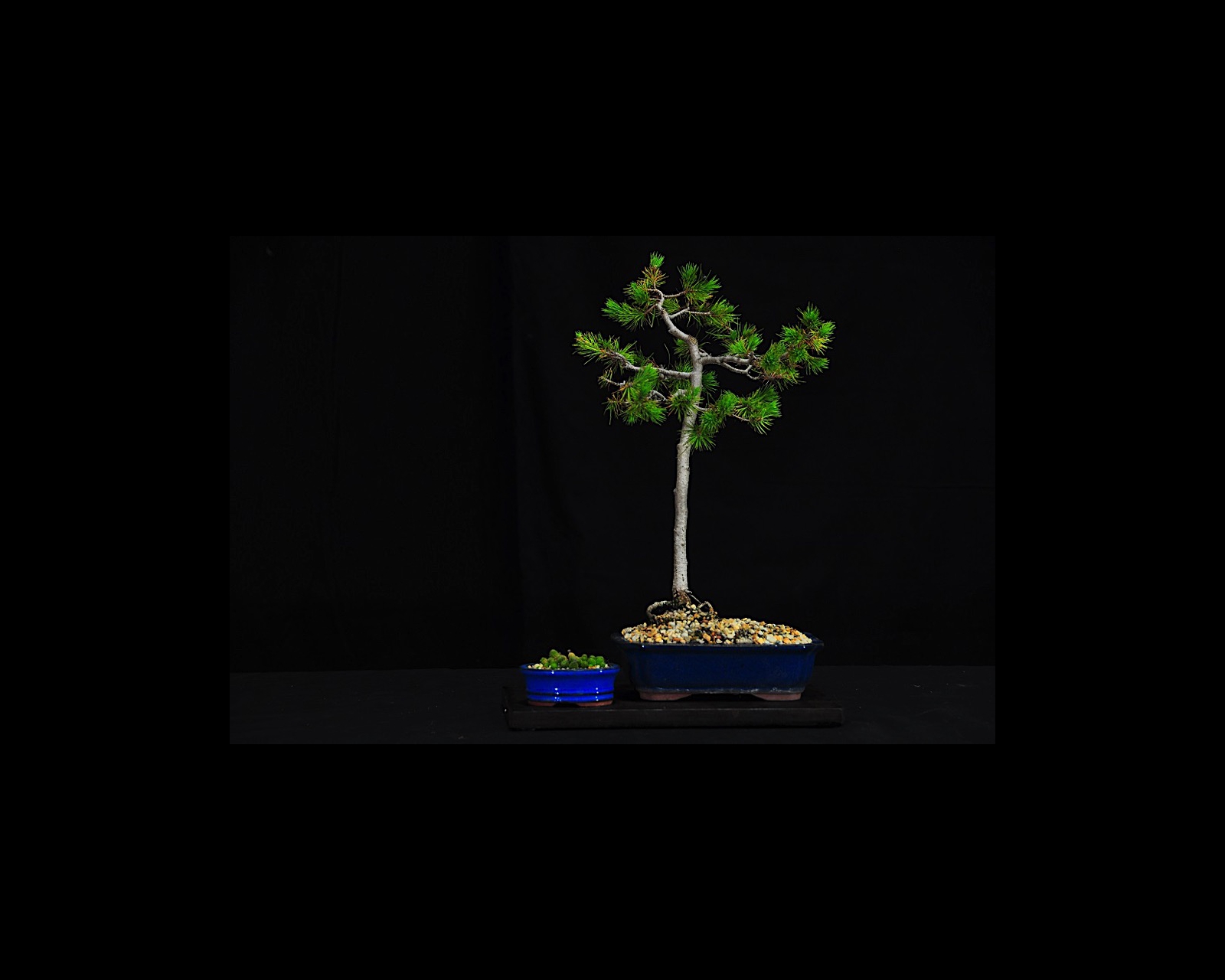 Pinus halepensis. Age of tree 5 years. Trained since 2015. This plant was purchased at Yarralumla Nursery. I have endeavoured to keep the juvenile foliage. It has been developed mainly using the 'clip and grow' method, using only a little wire.
Pinus halepensis. Age of tree 5 years. Trained since 2015. This plant was purchased at Yarralumla Nursery. I have endeavoured to keep the juvenile foliage. It has been developed mainly using the 'clip and grow' method, using only a little wire. Rhododendron sp. Age of tree - More than 3 years. Trained since 2015.
I purchased this flowering Azalea on a CBS trip to Sydney in 2014. It has flowered each year since then. It was placed in a bonsai pot 2015 and trained to the current shape.
Rhododendron sp. Age of tree - More than 3 years. Trained since 2015.
I purchased this flowering Azalea on a CBS trip to Sydney in 2014. It has flowered each year since then. It was placed in a bonsai pot 2015 and trained to the current shape.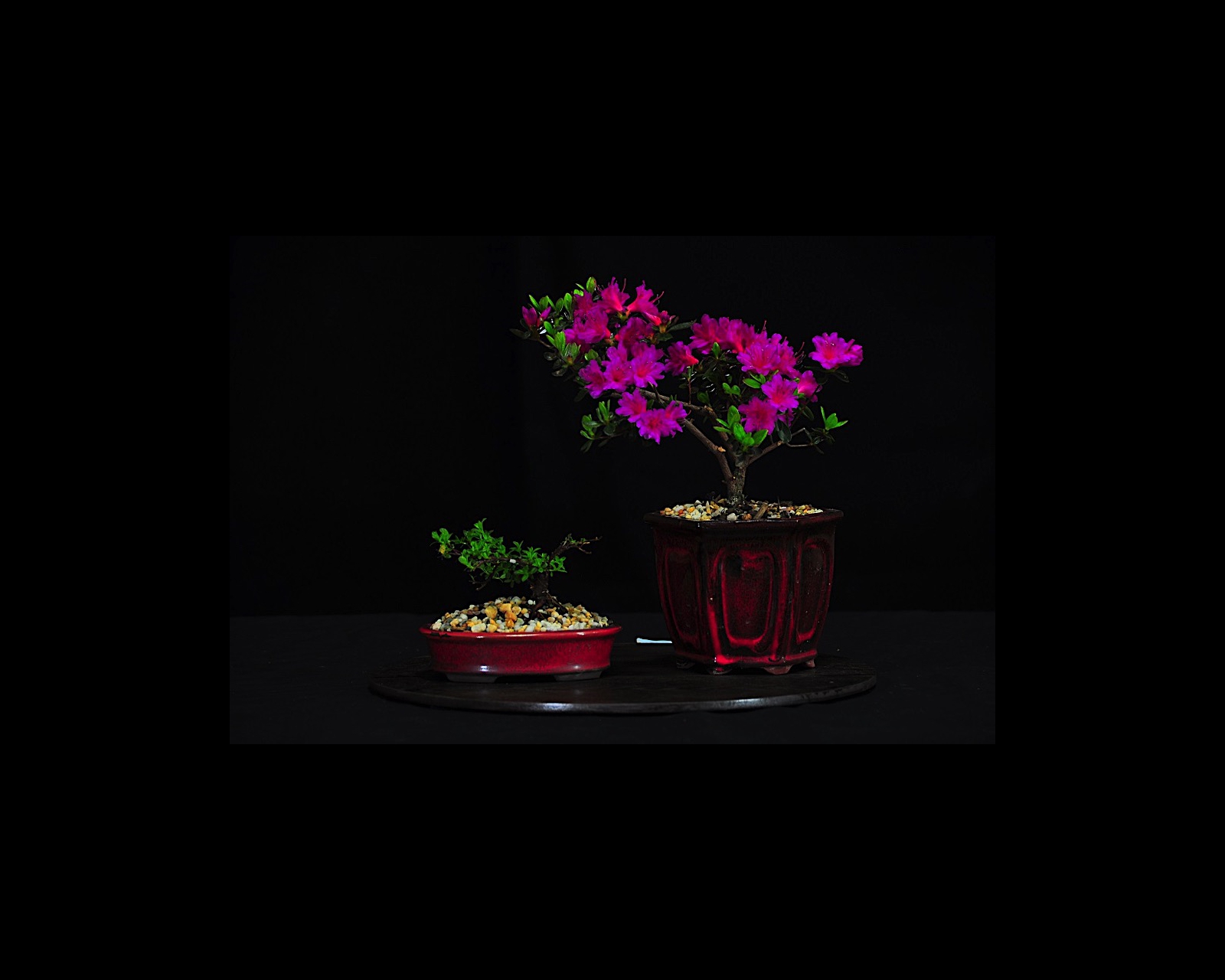 Rhododendron sp. Age of tree 5 years. Trained since 2015. Used as a companion plant here. I grew this from plant a cutting from an older plant and it developed this shape itself. It is a non-flowering Azalea. I am now training it as a cascade.
Rhododendron sp. Age of tree 5 years. Trained since 2015. Used as a companion plant here. I grew this from plant a cutting from an older plant and it developed this shape itself. It is a non-flowering Azalea. I am now training it as a cascade.
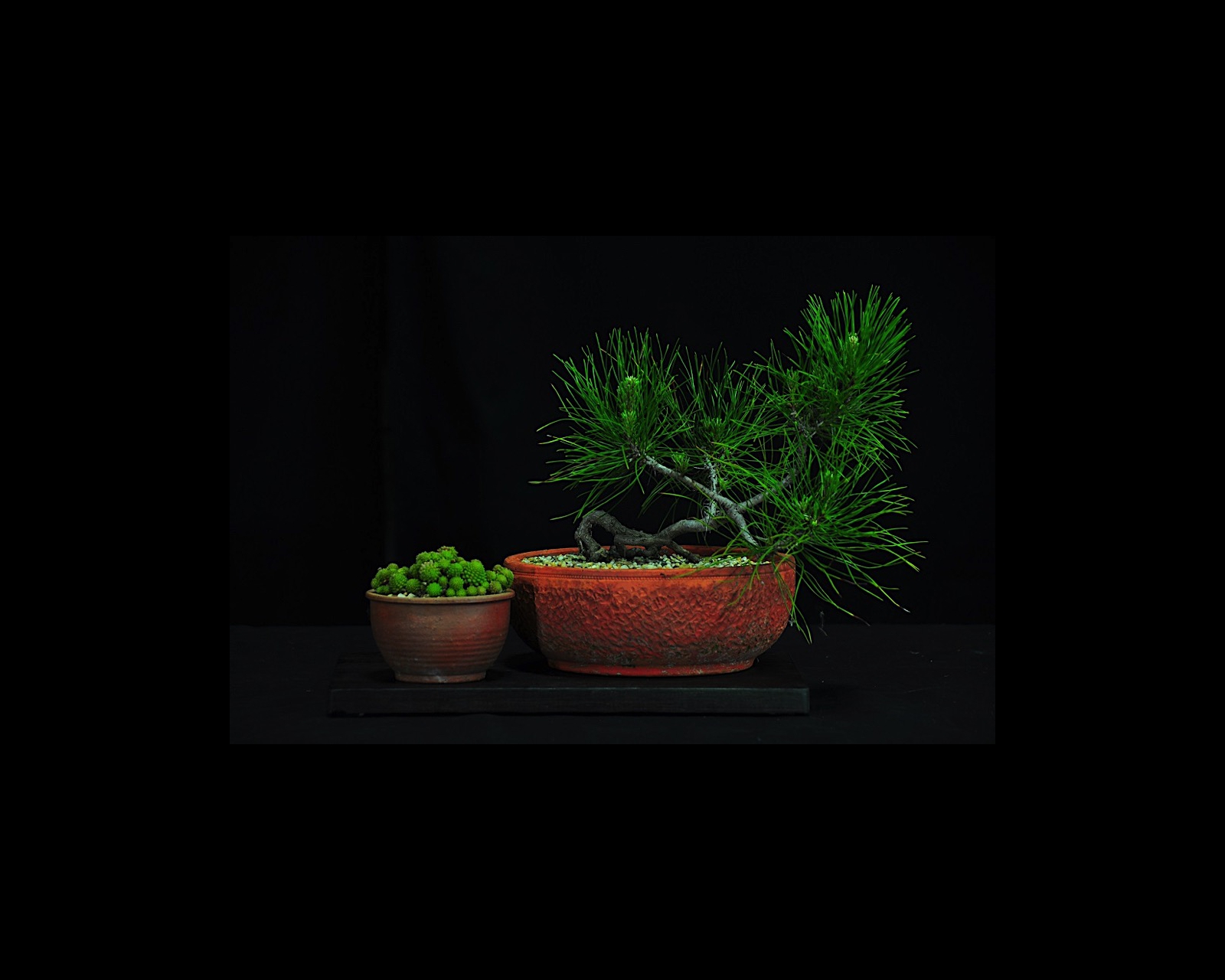 Pinus radiata. Age of tree 6 years. Trained since 2015. This plant was purchased from Bunnings and it always seemed spindly. When I repotted it I found its' roots were curly so I planted them over a rock with some roots exposed.
Pinus radiata. Age of tree 6 years. Trained since 2015. This plant was purchased from Bunnings and it always seemed spindly. When I repotted it I found its' roots were curly so I planted them over a rock with some roots exposed.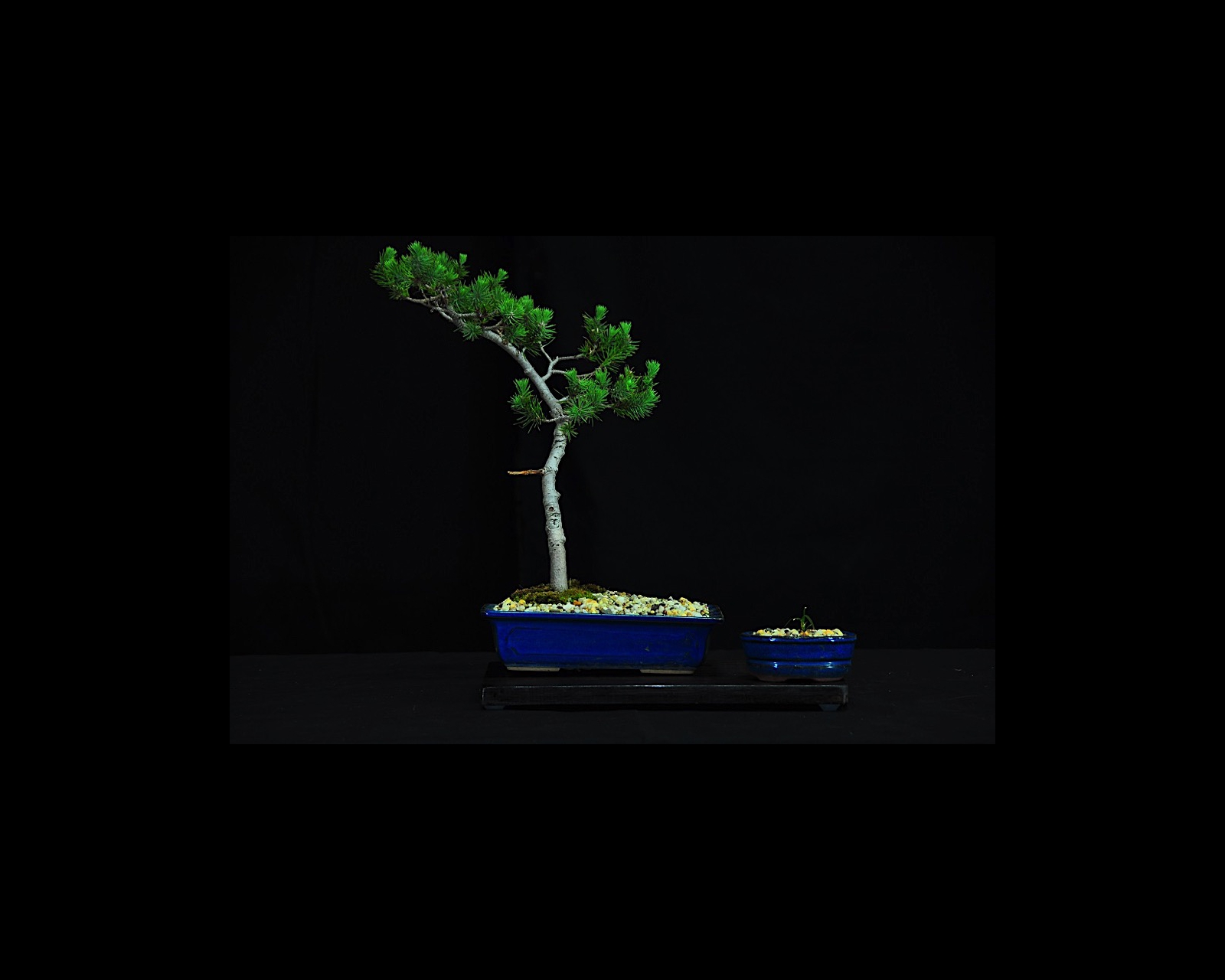 Pinus pinea. Age of tree 5 years. Trained since 2015. I grew this plant from seed. I have kept the juvenile foliage as I wish to keep the plant small. It has been grown by clip and grow method and only a little wiring used.
Pinus pinea. Age of tree 5 years. Trained since 2015. I grew this plant from seed. I have kept the juvenile foliage as I wish to keep the plant small. It has been grown by clip and grow method and only a little wiring used.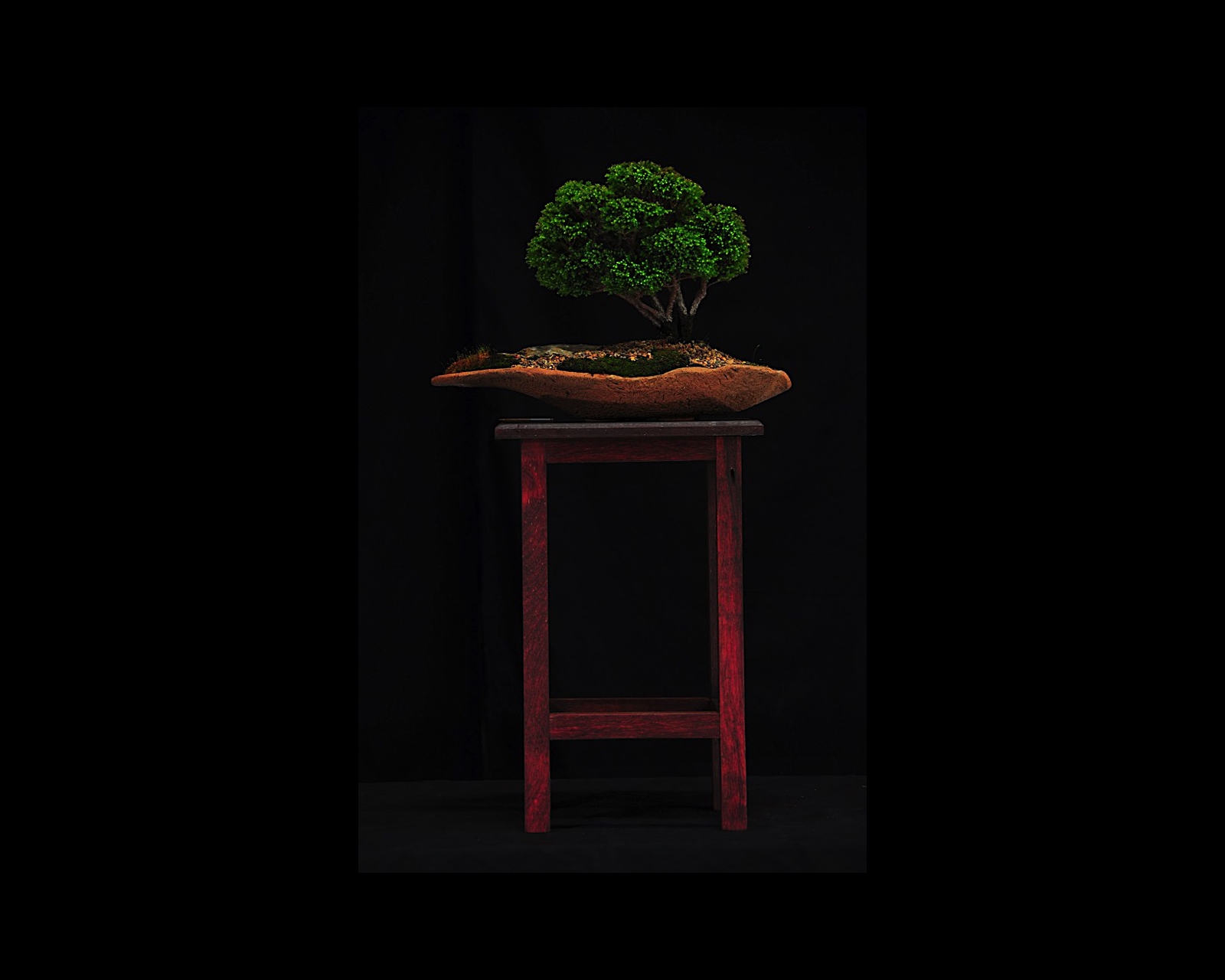 Chamaecyparis pisifera 'plumosa rogersi'. Age of tree Unknown. Trained since 2016. This tree was purchased from the club table as a small upright bushy shrub with great potential. It was wired as a gentle windswept multi-trunk style and the lower foliage removed to show the attractive bark. The pot was made for it at a club pottery workshop.
Chamaecyparis pisifera 'plumosa rogersi'. Age of tree Unknown. Trained since 2016. This tree was purchased from the club table as a small upright bushy shrub with great potential. It was wired as a gentle windswept multi-trunk style and the lower foliage removed to show the attractive bark. The pot was made for it at a club pottery workshop.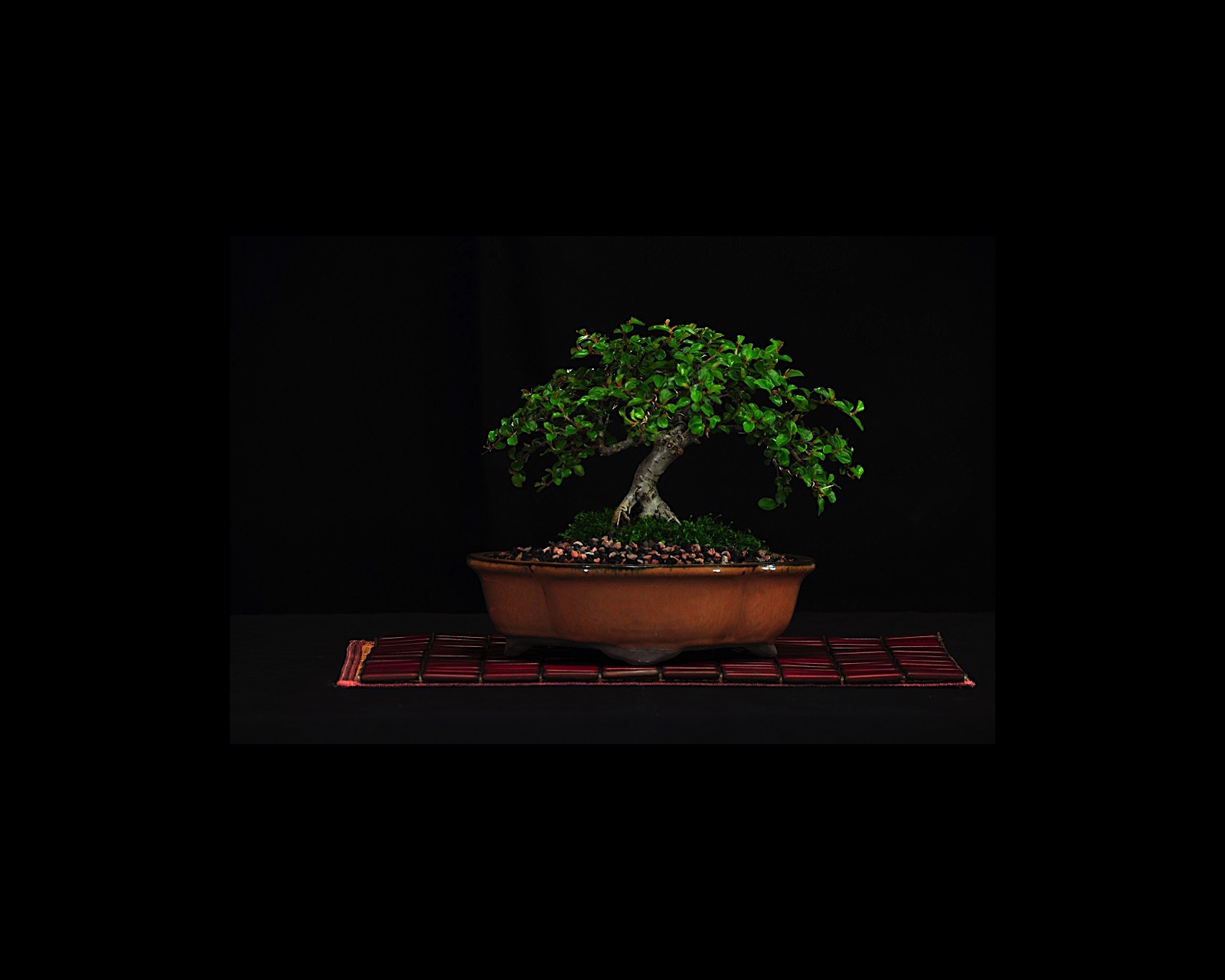 Cotoneaster horizontalis. Age of tree Unknown. Trained since 2016. This tree was purchased at the CBS Annual Show in 2016. Since then, it has undergone some moderate pruning in summer and some of the branches were wired into position. This deciduous plant lost all its leaves over winter and was completely bare six weeks ago. Since then it has produced lovely foliage and I hope to see some berries in the future.
Cotoneaster horizontalis. Age of tree Unknown. Trained since 2016. This tree was purchased at the CBS Annual Show in 2016. Since then, it has undergone some moderate pruning in summer and some of the branches were wired into position. This deciduous plant lost all its leaves over winter and was completely bare six weeks ago. Since then it has produced lovely foliage and I hope to see some berries in the future.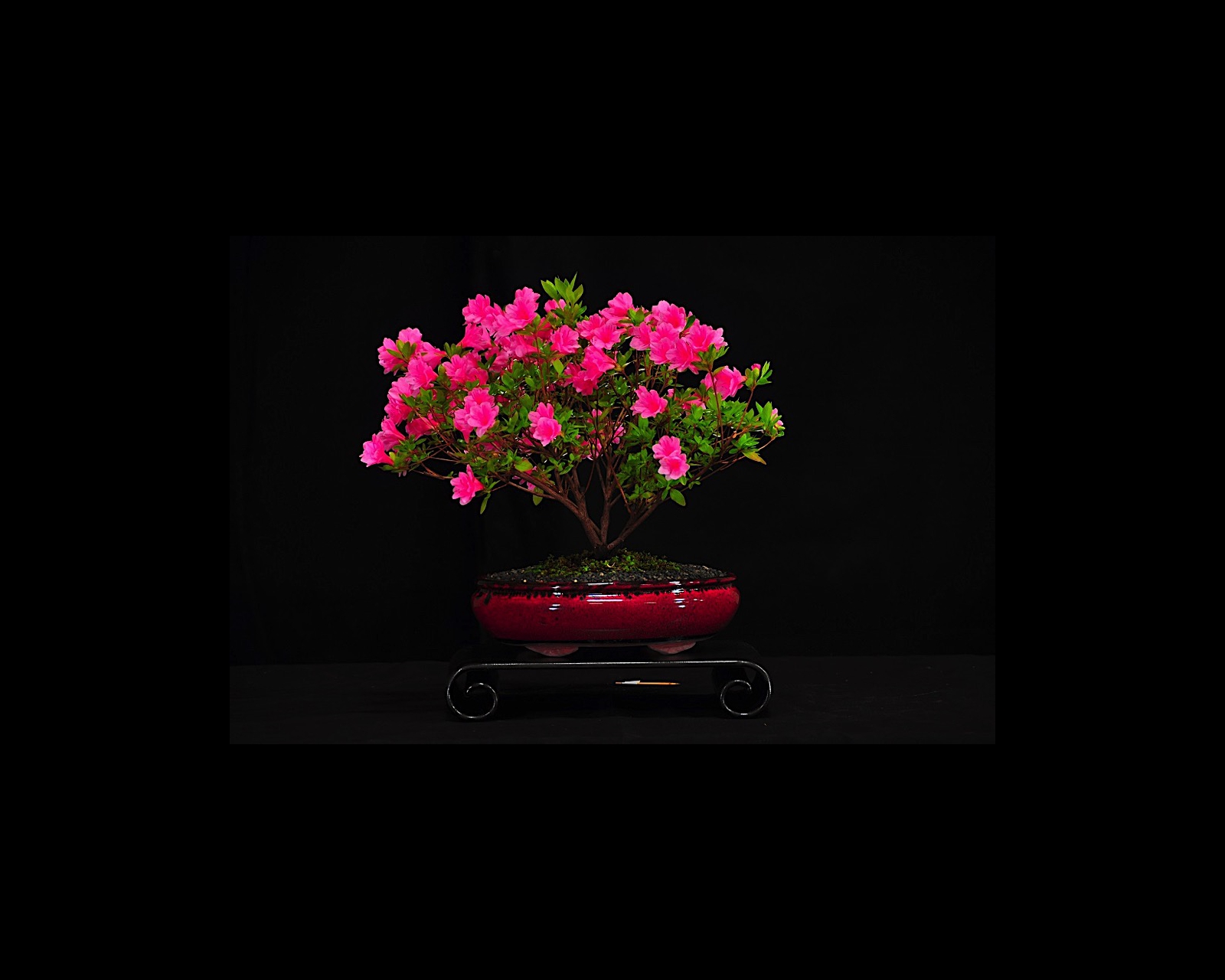 Rhododendron sp. Age of tree 3 years (estimated). Trained since 2016. This azalea was purchased at a local nursery and potted and styled at Brenda Parker’s CBS workshop in November 2016. It has the potential for further development in broom style.
Rhododendron sp. Age of tree 3 years (estimated). Trained since 2016. This azalea was purchased at a local nursery and potted and styled at Brenda Parker’s CBS workshop in November 2016. It has the potential for further development in broom style.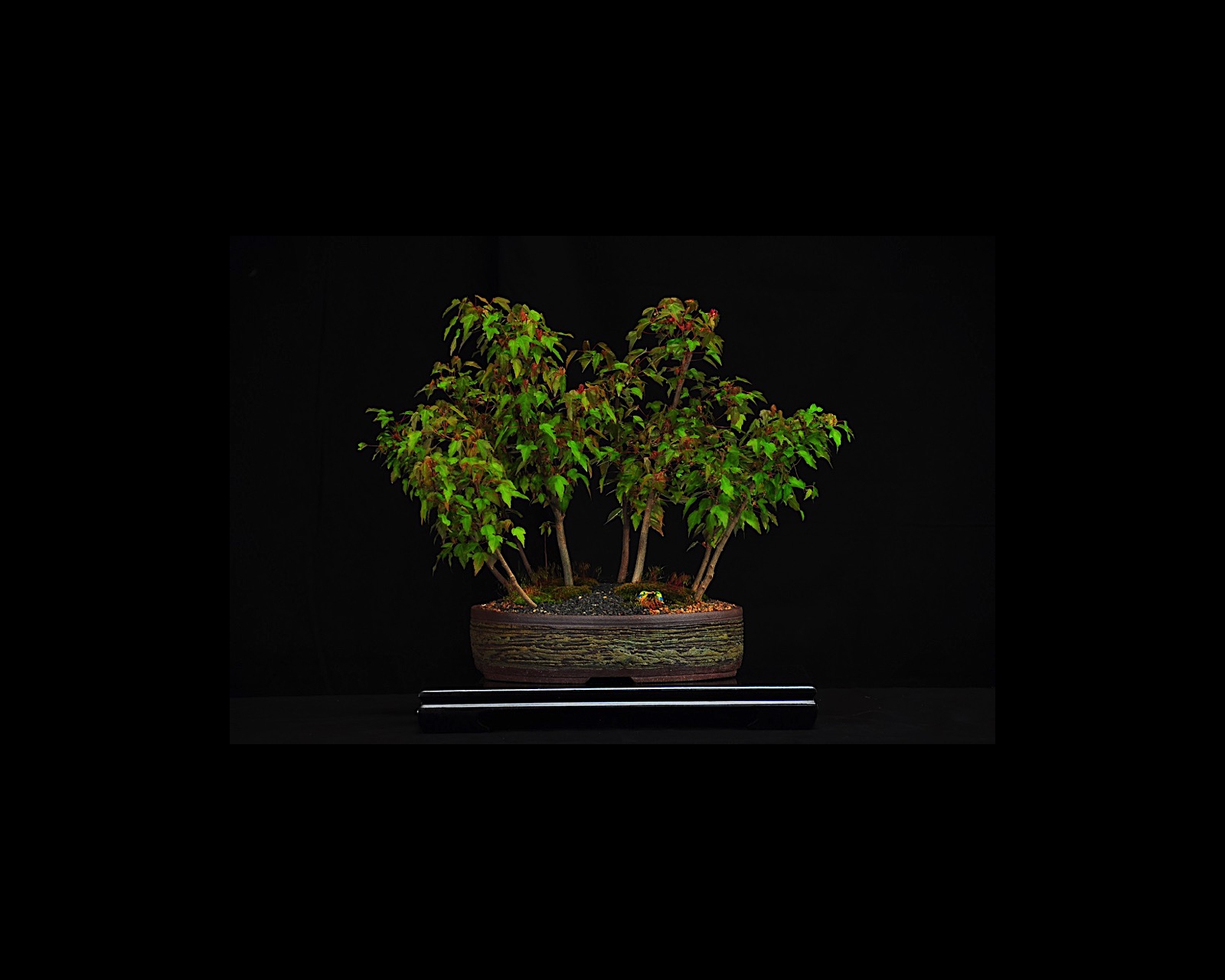 Acer buergerianum
Age of tree 3 years. Trained since 2016. Using 1 and 2 year old trident maple seedlings, this forest was first assembled in July 2016. Initially, a small amount of wiring was needed to provide balance. In early 2017, leaves were trimmed and some branches shortened to retain a compact forest style. In late August 2017, the forest was lifted from its training pot, its roots trimmed, and it was replanted into its current pot, by Marg Fenn. It demonstrates just how quickly it is possible to create a forest bonsai from very young plant material; one which will, with time, acquire the physical characteristics of a mature forest.
Acer buergerianum
Age of tree 3 years. Trained since 2016. Using 1 and 2 year old trident maple seedlings, this forest was first assembled in July 2016. Initially, a small amount of wiring was needed to provide balance. In early 2017, leaves were trimmed and some branches shortened to retain a compact forest style. In late August 2017, the forest was lifted from its training pot, its roots trimmed, and it was replanted into its current pot, by Marg Fenn. It demonstrates just how quickly it is possible to create a forest bonsai from very young plant material; one which will, with time, acquire the physical characteristics of a mature forest.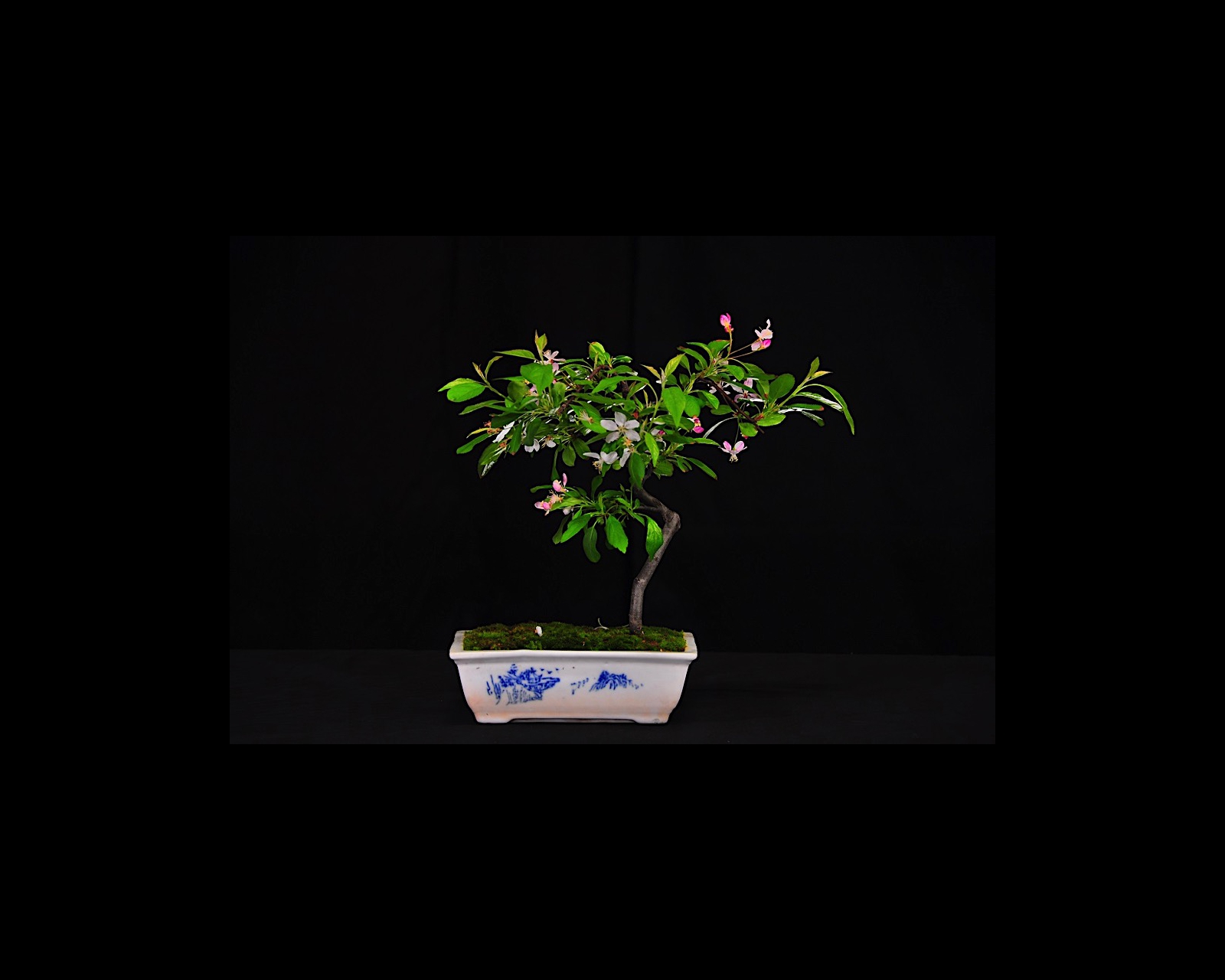 Malus floribunda. Age of tree 2 years. Trained since 2016. The tree was purchased from a garden nursery in 2016 and has been trained since that time. It has flowered well over the last two years. I have been working on the trunk and tried to shape it.
Malus floribunda. Age of tree 2 years. Trained since 2016. The tree was purchased from a garden nursery in 2016 and has been trained since that time. It has flowered well over the last two years. I have been working on the trunk and tried to shape it.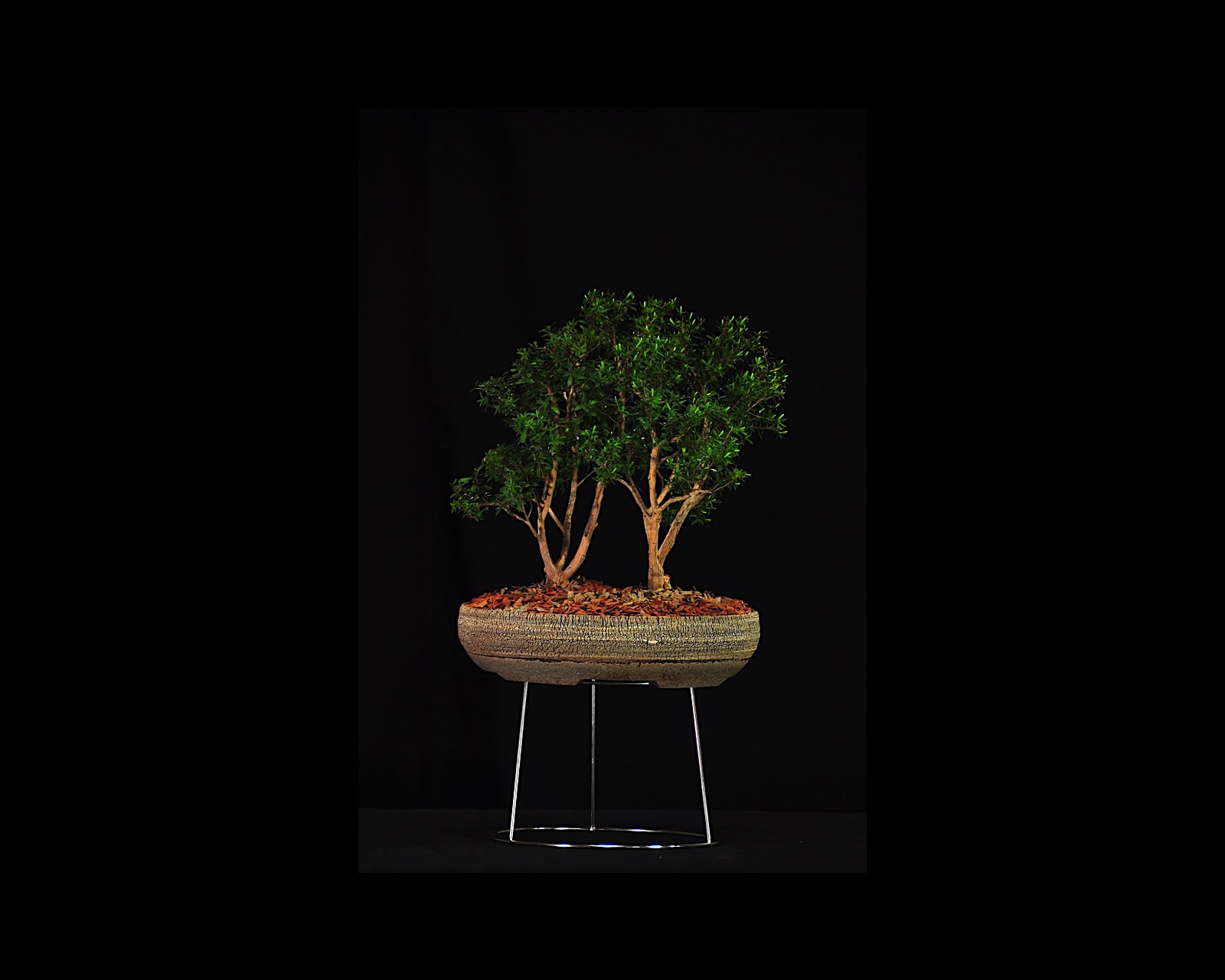 Kunzea ericoides 'Snowman'. Age of tree 7 years. Trained since 2016. This pair of trees were nursery stock. The new growth is not synchronised on both trees so for a few weeks the spring growth highlights the individual trees. A future possibility is to add other trees to create a forest.
Kunzea ericoides 'Snowman'. Age of tree 7 years. Trained since 2016. This pair of trees were nursery stock. The new growth is not synchronised on both trees so for a few weeks the spring growth highlights the individual trees. A future possibility is to add other trees to create a forest.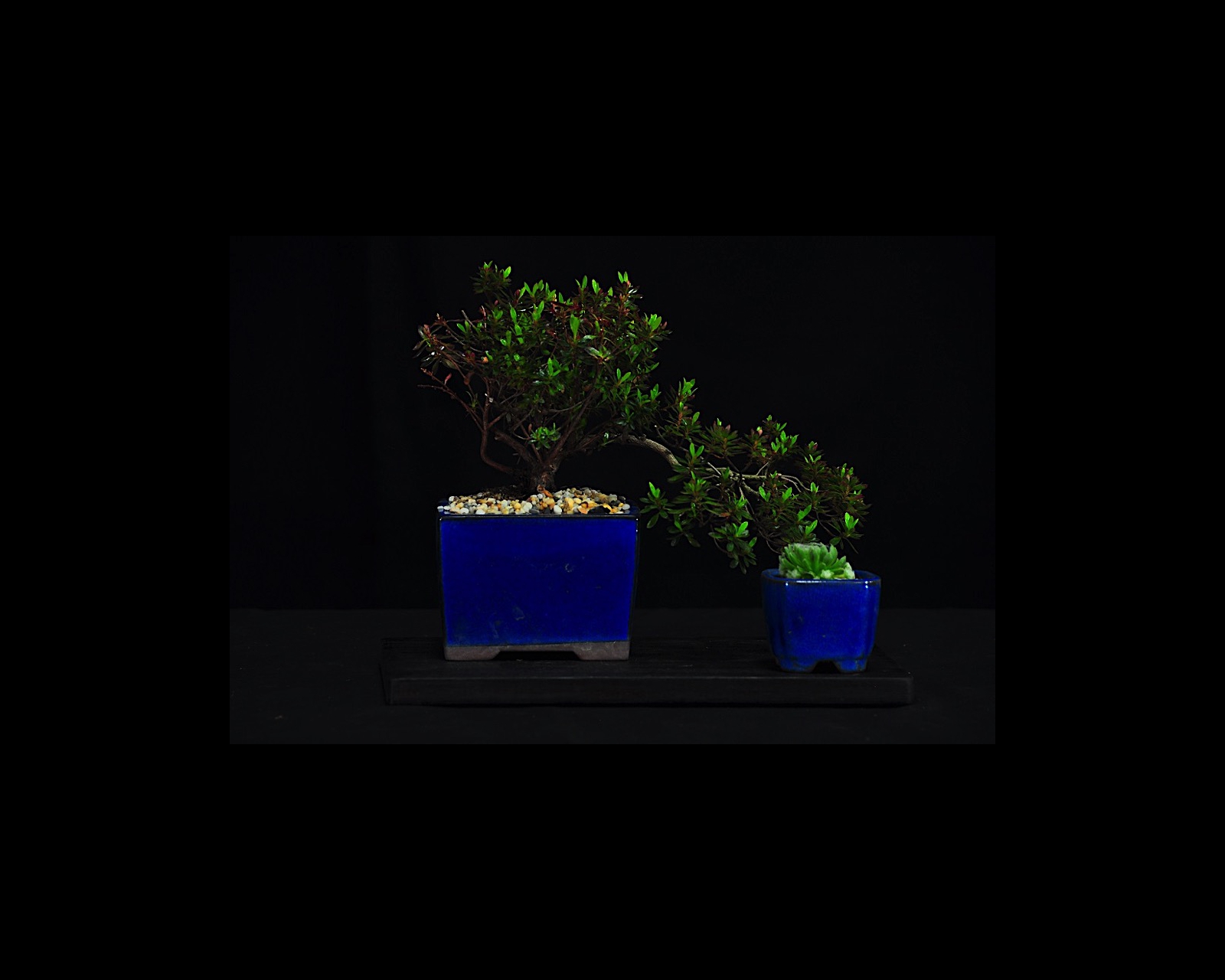 Rhododendron sp. Age of tree - Approximately 4 years. Trained since 2016.
This plant was purchased at Bunnings as a rooted cutting. It was allowed to grow till this year when it started to make buds and was trimmed to its current shape.
Rhododendron sp. Age of tree - Approximately 4 years. Trained since 2016.
This plant was purchased at Bunnings as a rooted cutting. It was allowed to grow till this year when it started to make buds and was trimmed to its current shape.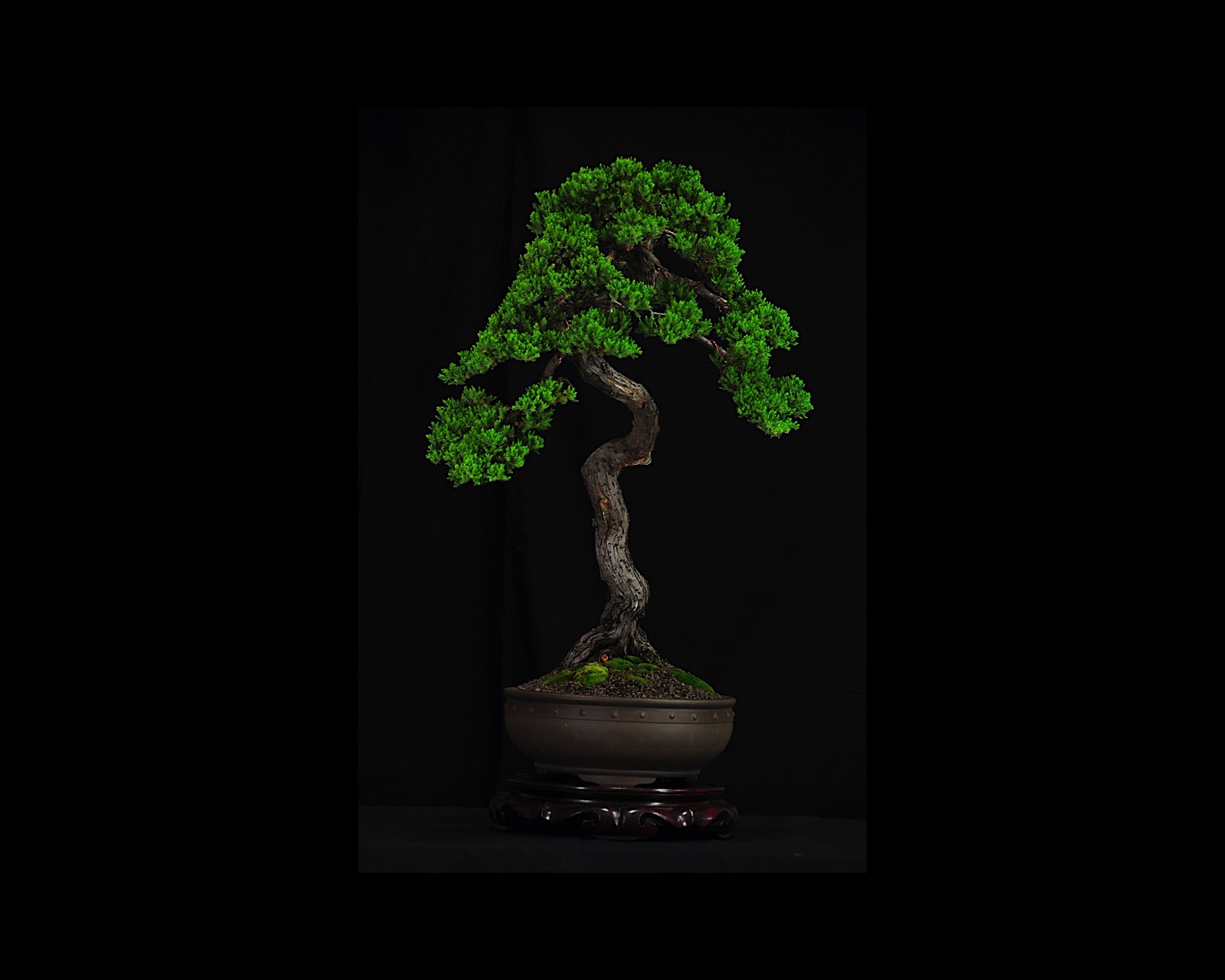 Juniperus squamata 'Prostrata'. Age of tree 30 years. Trained since 2016. Originally styled from advanced bonsai stock by Master Min-Hsuan Lo of Taiwan at the 'Tops' weekend in 2016. The tree was purchased, restyled and potted.
Juniperus squamata 'Prostrata'. Age of tree 30 years. Trained since 2016. Originally styled from advanced bonsai stock by Master Min-Hsuan Lo of Taiwan at the 'Tops' weekend in 2016. The tree was purchased, restyled and potted. 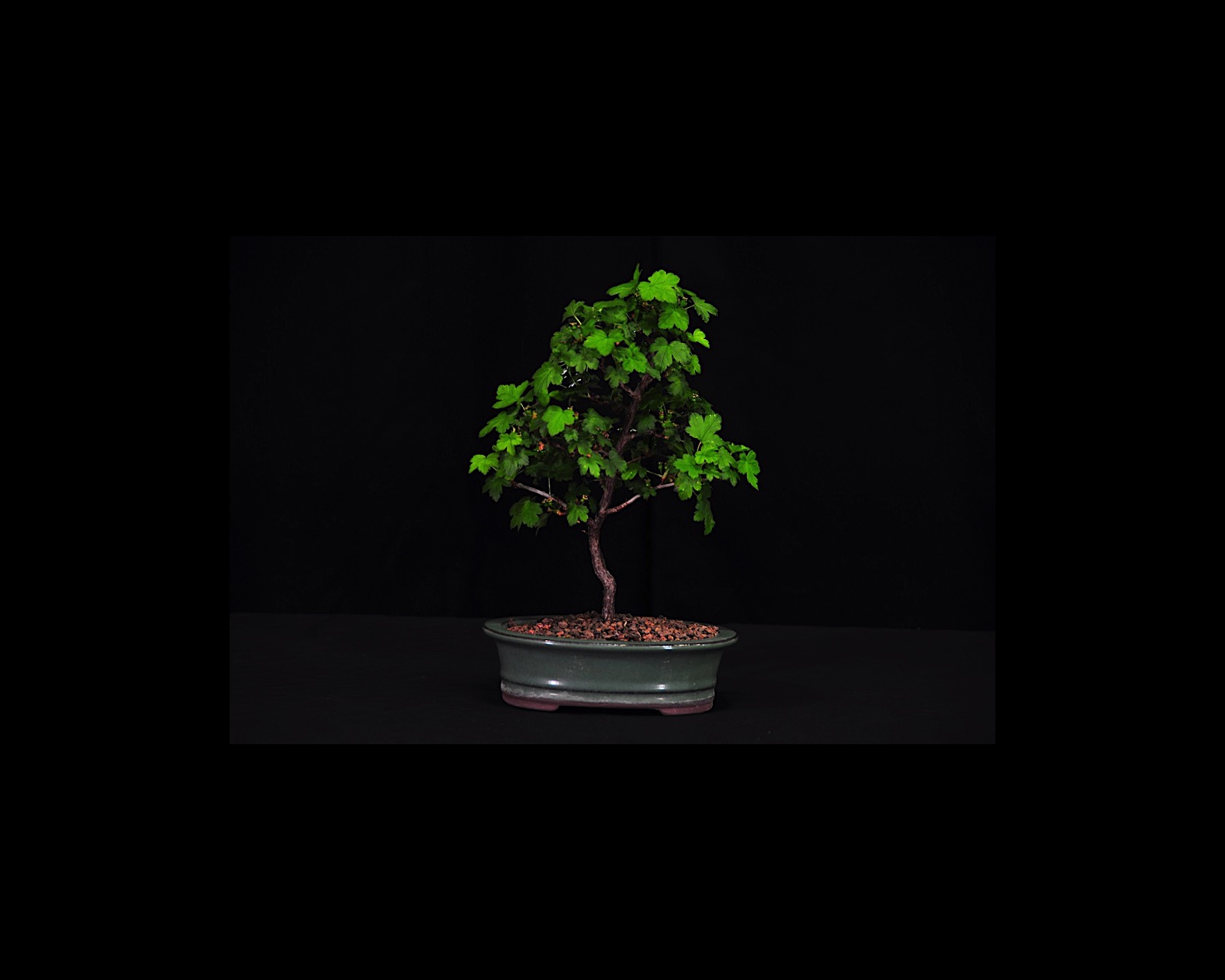 Crataegus phoenopyrum. Age of tree 4 years. Trained since 2016. This tree was bought in the CBS show three years ago and has only been worked on in the last year or so.
Crataegus phoenopyrum. Age of tree 4 years. Trained since 2016. This tree was bought in the CBS show three years ago and has only been worked on in the last year or so.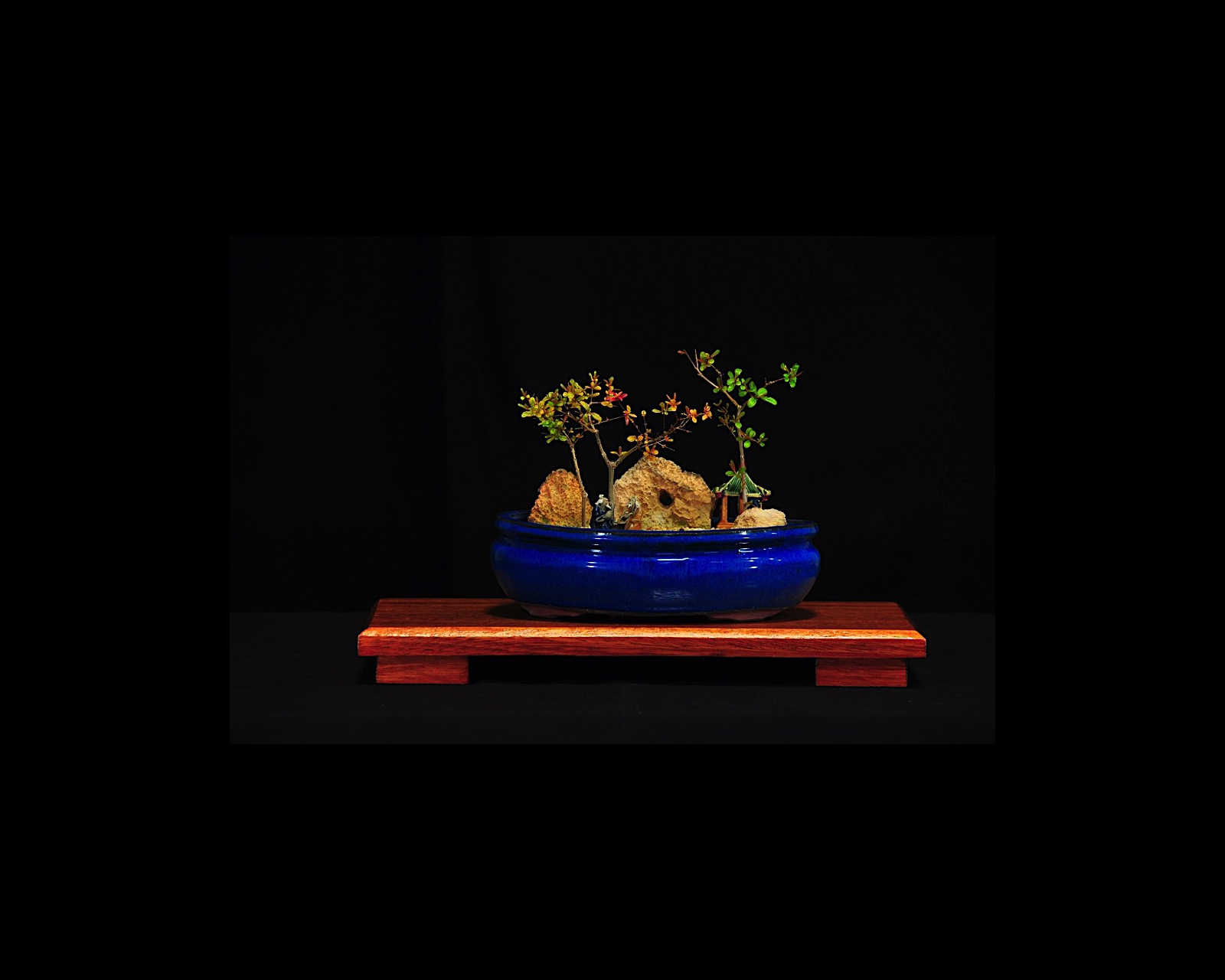 Punica granatum. Age of tree 2 years. Trained since 2016. This composition came about after I found the central sandstone with the hole in it at the Port Fairy lighthouse when visiting my parents. I wanted it to be the centrepiece of a bonsai landscape (penjing) that evoked a sense of the oceanside. I love pomegranates and the changing colours of their foliage reflecting the seasons; they are enthusiastic and forgiving trees and I felt they would be quite feasible in a sea setting. I served over a decade in the Navy and I miss the ocean a lot. This penjing is one of my favourites.
Punica granatum. Age of tree 2 years. Trained since 2016. This composition came about after I found the central sandstone with the hole in it at the Port Fairy lighthouse when visiting my parents. I wanted it to be the centrepiece of a bonsai landscape (penjing) that evoked a sense of the oceanside. I love pomegranates and the changing colours of their foliage reflecting the seasons; they are enthusiastic and forgiving trees and I felt they would be quite feasible in a sea setting. I served over a decade in the Navy and I miss the ocean a lot. This penjing is one of my favourites.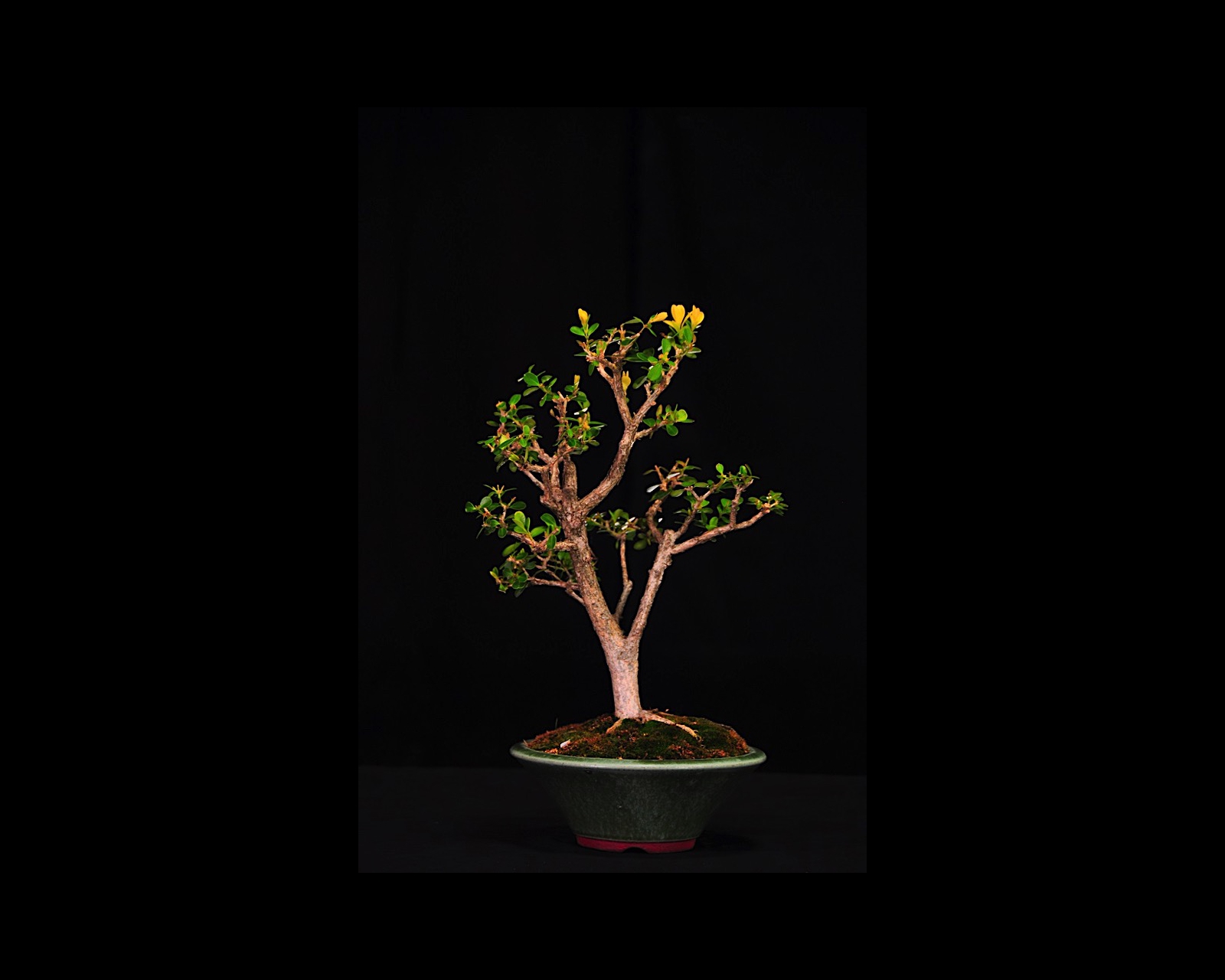 Buxus microphylla. Age of tree 5 years. Trained since 2017. This tree was bought in 2016 CBS show in a plastic pot. I have worked on it only from this year.
Buxus microphylla. Age of tree 5 years. Trained since 2017. This tree was bought in 2016 CBS show in a plastic pot. I have worked on it only from this year.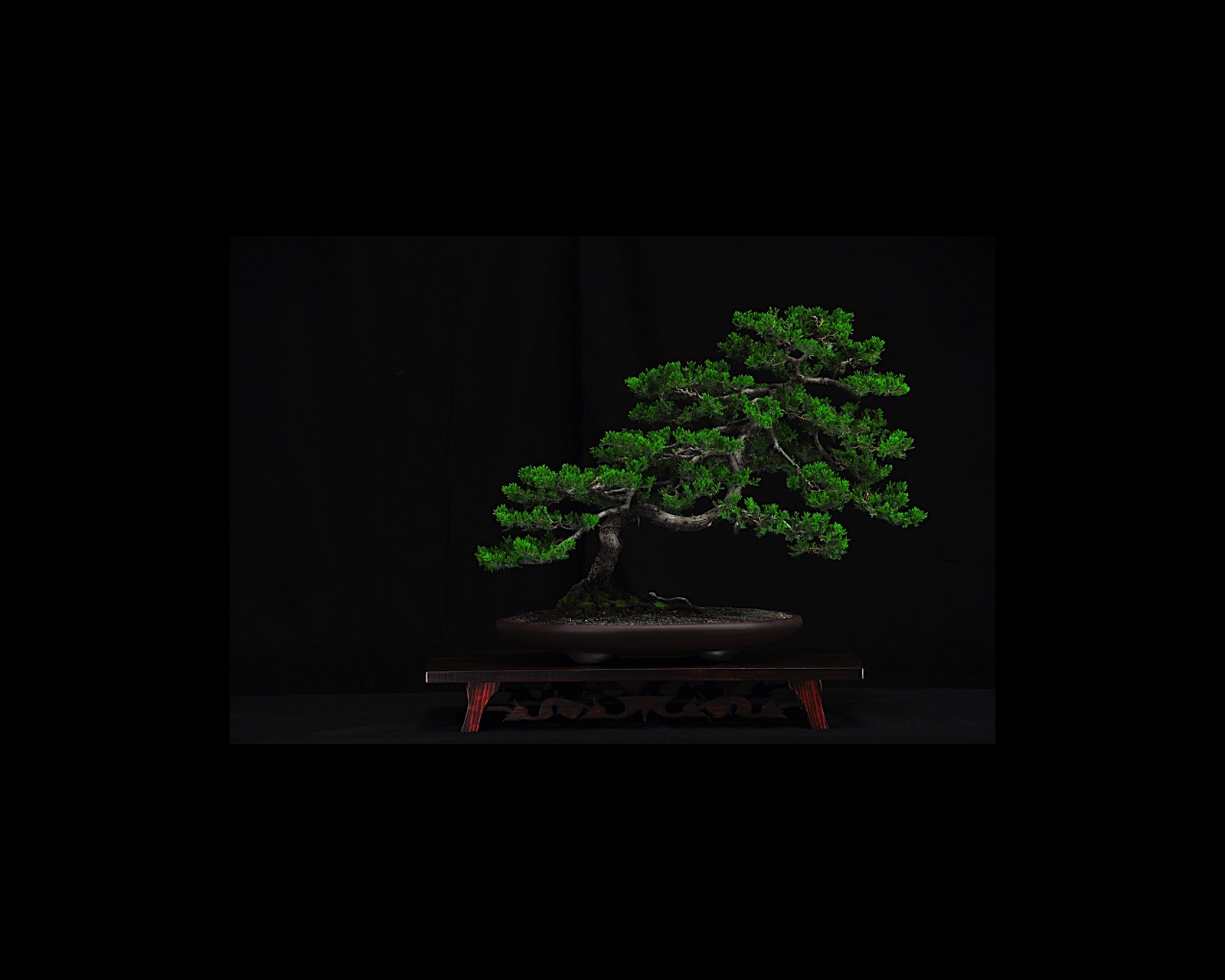 Juniperus squamata. Age of tree 17 years (estimated). Trained since Unknown. To me, the rolling cascades of this beautiful juniper symbolise the notion of continuity. Picture a gently flowing waterfall and allow your eye to follow a line of cascades from the apex to a lower branch and and then to the next lower branch, then to an even lower branch. Now do it again but follow a different line. ... and again.
Juniperus squamata. Age of tree 17 years (estimated). Trained since Unknown. To me, the rolling cascades of this beautiful juniper symbolise the notion of continuity. Picture a gently flowing waterfall and allow your eye to follow a line of cascades from the apex to a lower branch and and then to the next lower branch, then to an even lower branch. Now do it again but follow a different line. ... and again.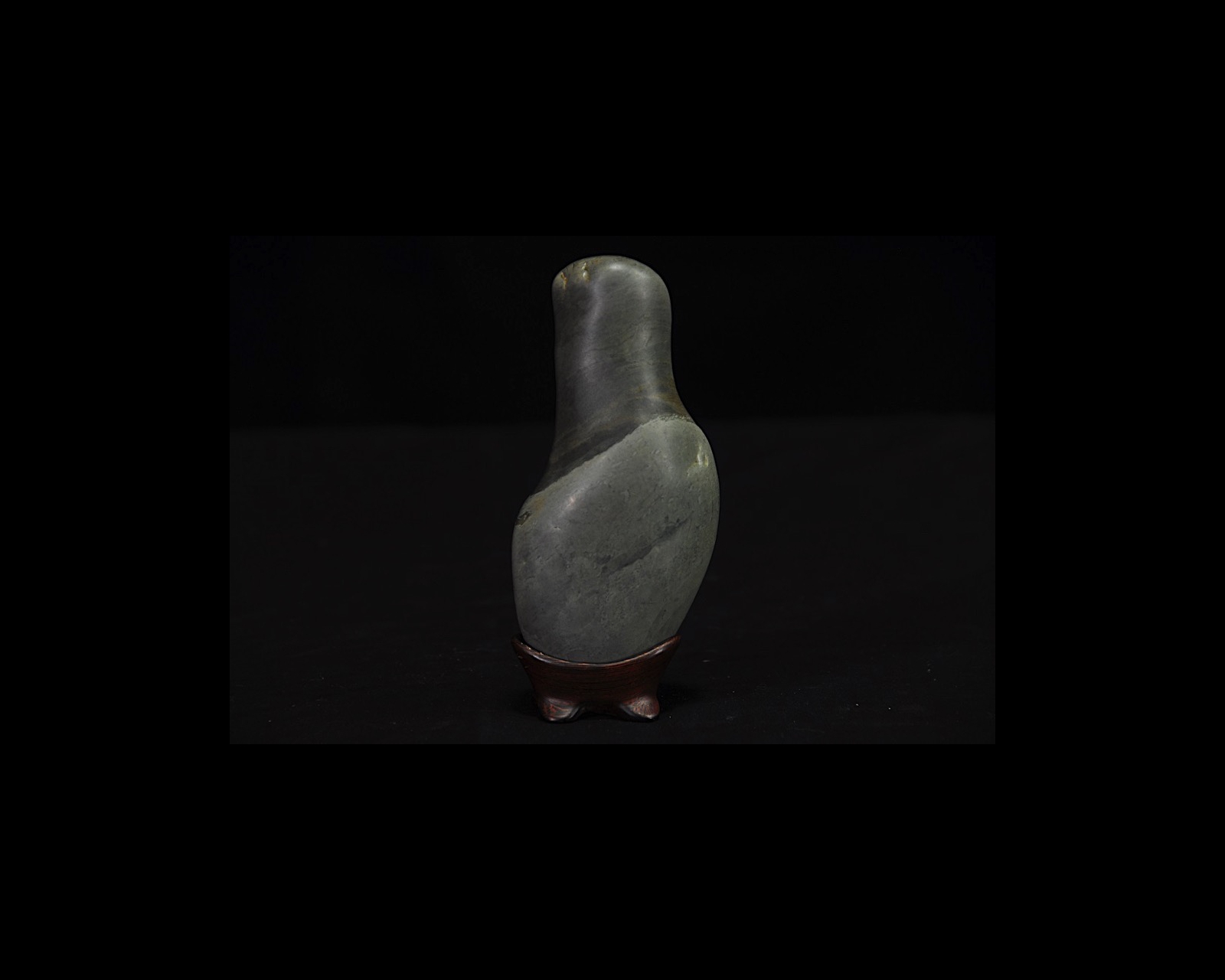 This is my favourite suiseki from a large collection. I think it has the beautiful curves and glow of an expectant mother.
This is my favourite suiseki from a large collection. I think it has the beautiful curves and glow of an expectant mother.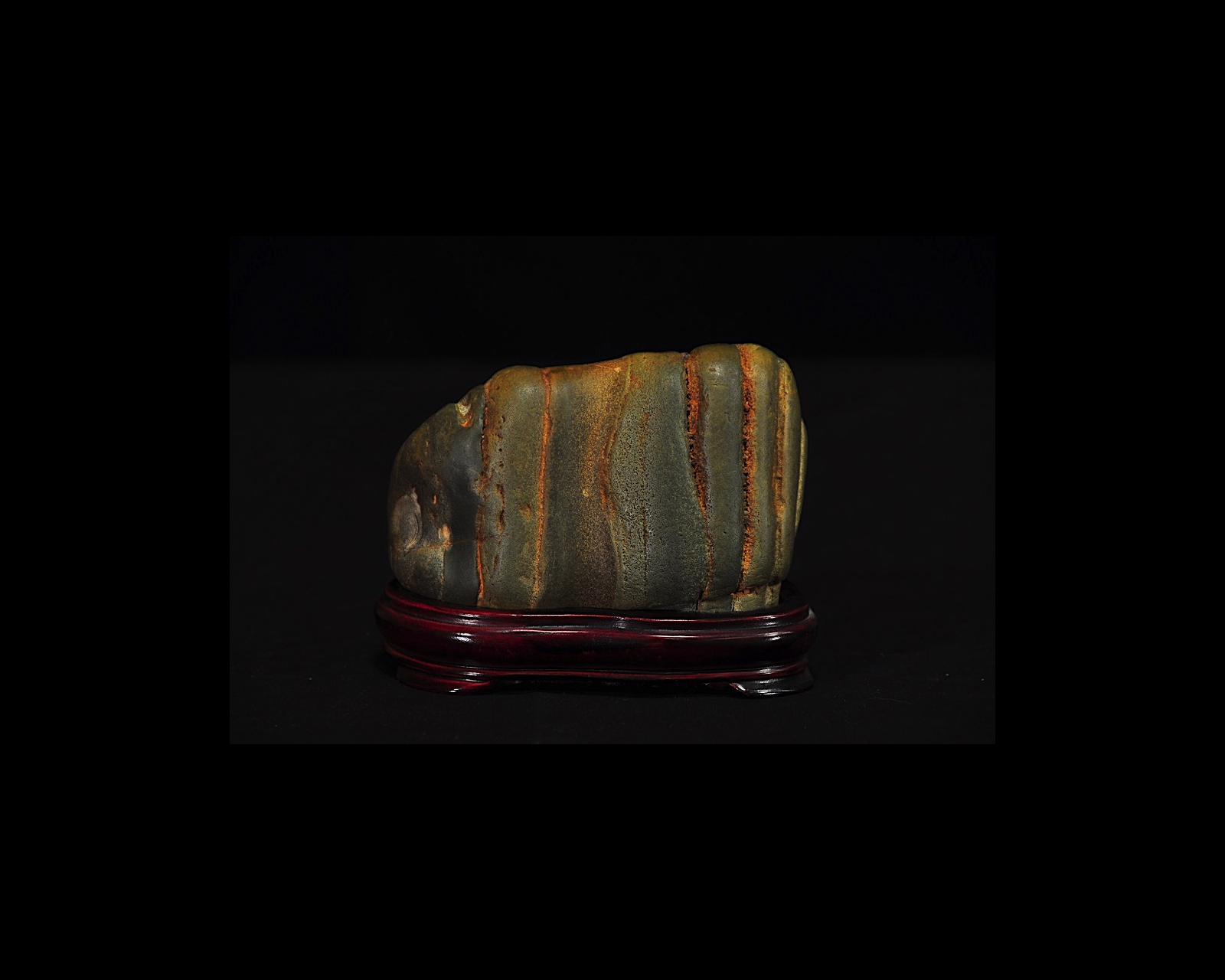 Ocean Jasper (Orbicular (Madagascan) Jasper). This viewing stone, suiseki 水石 (Japanese) or gongshí 贡石(Chinese) is ocean jasper with a gorgeous geode (rough crystal) furnishing. The mineral is aptly named with the randomly sized green and white circular patterns evoking the image of rock pools and ripples from briny rain. The smoky crystal geode facets make me think of looking into the clear waters of the Daintree river as the sun on the water turns the riverbed pebbles into gemstones.
Ocean Jasper (Orbicular (Madagascan) Jasper). This viewing stone, suiseki 水石 (Japanese) or gongshí 贡石(Chinese) is ocean jasper with a gorgeous geode (rough crystal) furnishing. The mineral is aptly named with the randomly sized green and white circular patterns evoking the image of rock pools and ripples from briny rain. The smoky crystal geode facets make me think of looking into the clear waters of the Daintree river as the sun on the water turns the riverbed pebbles into gemstones.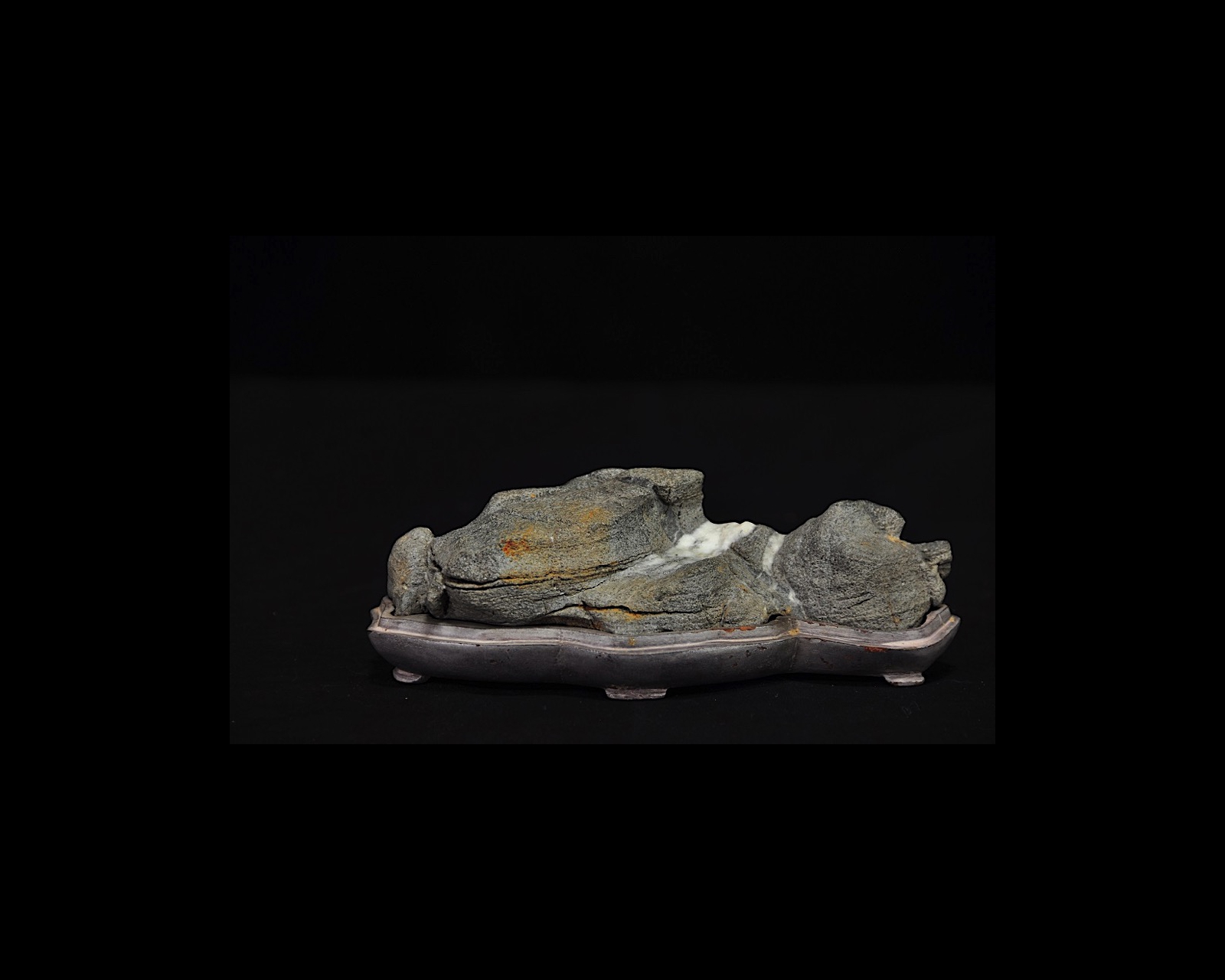 The Bungle Bungles. The moment I saw this stone I was put in mind of the ancient, amazing stone formations we have in Australia, especially the Bungle Bungle stone formations in the Kimberly, Western Australia. Whenever I look at this suiseki I feel like I have a miniature of the Bungle Bungles in the house; a perfect stone replica of the Australian outback.
The Bungle Bungles. The moment I saw this stone I was put in mind of the ancient, amazing stone formations we have in Australia, especially the Bungle Bungle stone formations in the Kimberly, Western Australia. Whenever I look at this suiseki I feel like I have a miniature of the Bungle Bungles in the house; a perfect stone replica of the Australian outback.
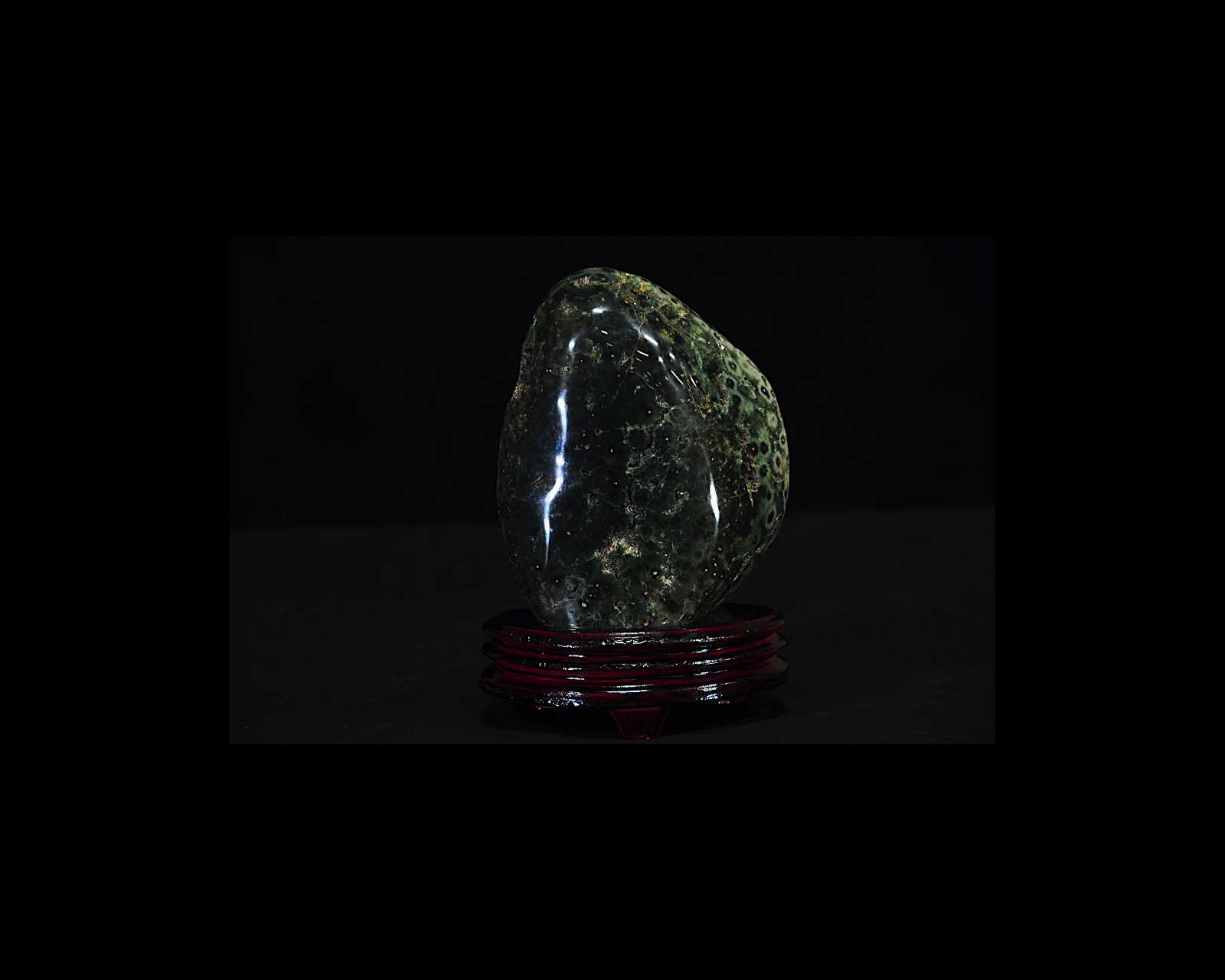 Chrysophase from Queensland.
Chrysophase from Queensland.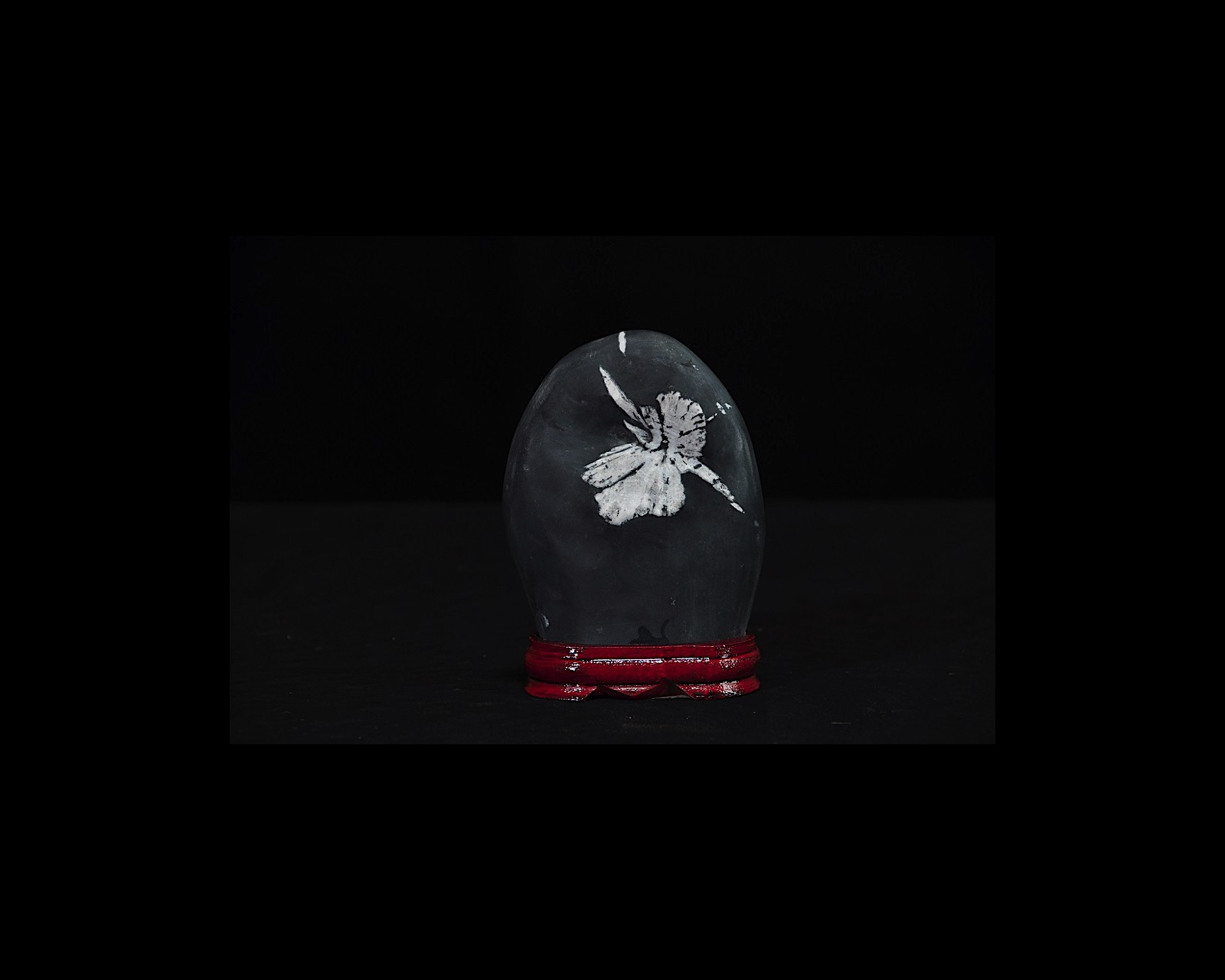
 Mountain range and Hut stone (Japan)
Mountain range and Hut stone (Japan)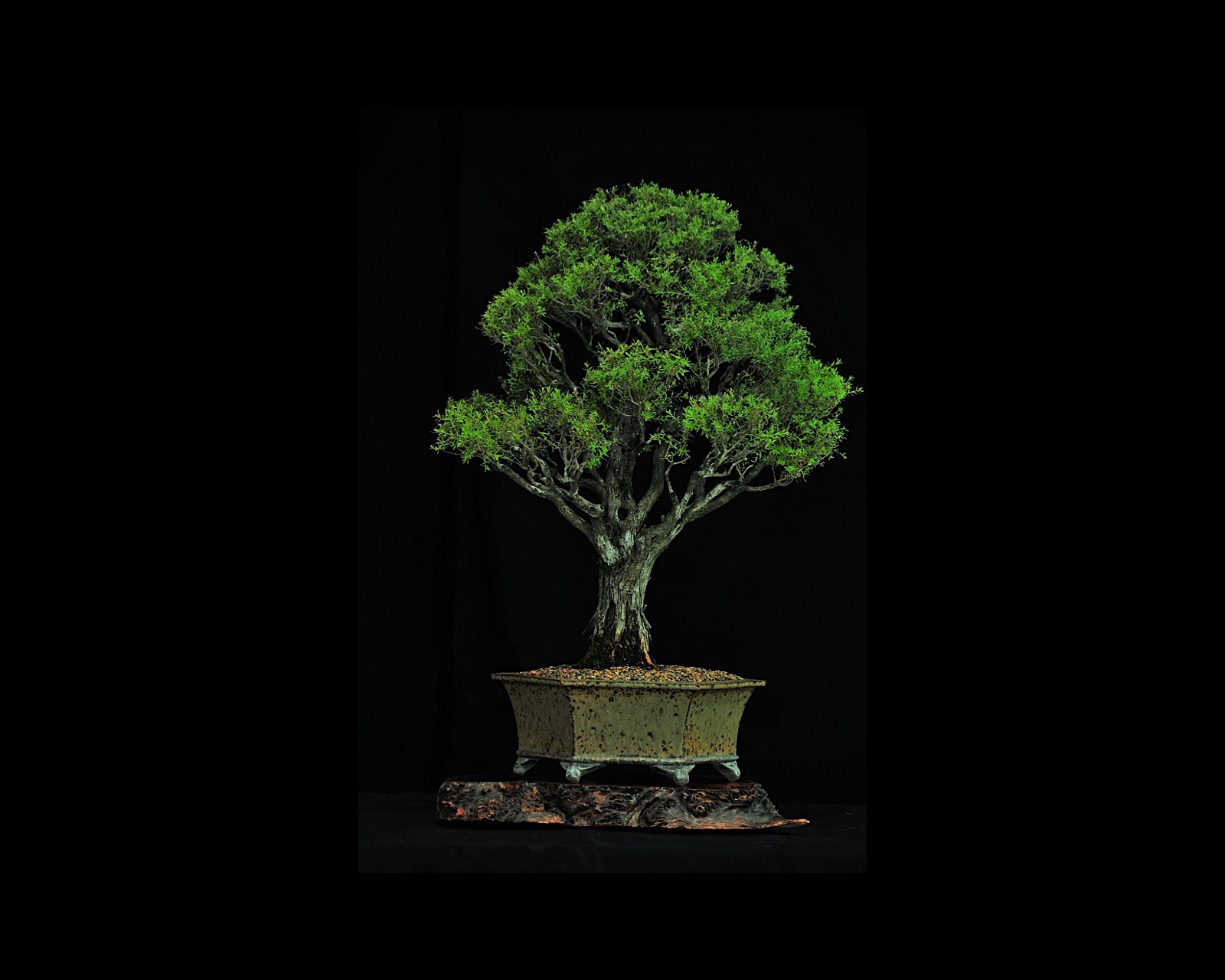 Leptospermum lanigerum. Age of tree 18 years. Trained since 2002. I set out to develop a tree that looked old, rugged and natural. I like the strong base and distinct foliage pads, and think the strong hexagonal pot suits it well.
Leptospermum lanigerum. Age of tree 18 years. Trained since 2002. I set out to develop a tree that looked old, rugged and natural. I like the strong base and distinct foliage pads, and think the strong hexagonal pot suits it well.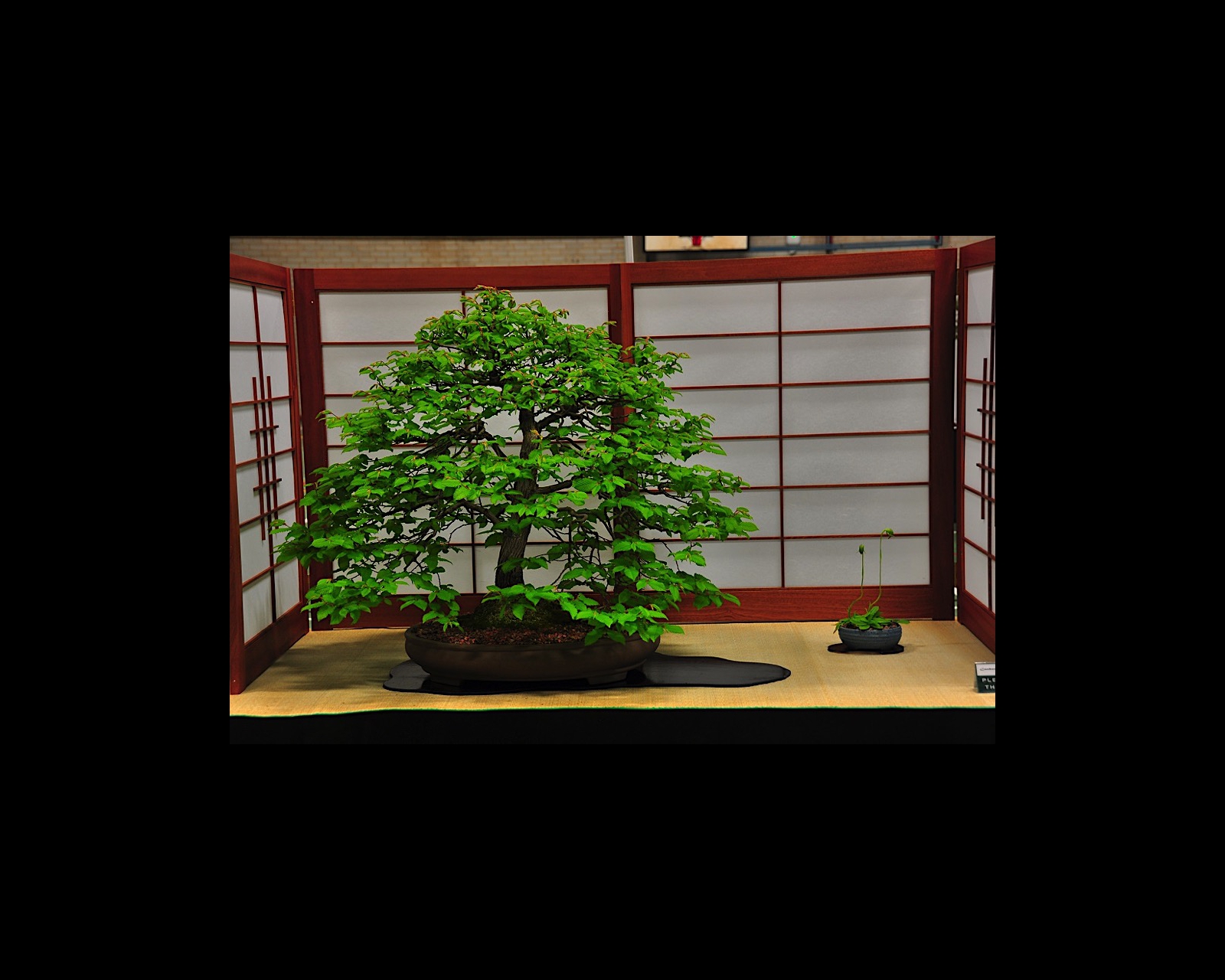
 (Rosa sp) Age 71 yrs, Trained since 1974. This is possibly a floribunda rose but its provenance is unknown. This plant was collected as a gift from my Grandmother's garden in 1974 when she learned I was interested in bonsai. 'It's never done any good in my garden' she said. When I dug it out I found she had unknowingly planted it on a hidden lump of old builder's concrete. My grandmother was thrilled when it became a bonsai that flowered with tiny orange/red roses. It is pruned as a rose should be and has a significant stump which demonstrates its age.
(Rosa sp) Age 71 yrs, Trained since 1974. This is possibly a floribunda rose but its provenance is unknown. This plant was collected as a gift from my Grandmother's garden in 1974 when she learned I was interested in bonsai. 'It's never done any good in my garden' she said. When I dug it out I found she had unknowingly planted it on a hidden lump of old builder's concrete. My grandmother was thrilled when it became a bonsai that flowered with tiny orange/red roses. It is pruned as a rose should be and has a significant stump which demonstrates its age.  (Ligustrum lucidum) Age of tree 41 years, Trained since 1976. This plant was collected in 1976 from my garden with a naturally curved trunk that formed as the seedling emerged from the ground and made its way between large autumn leaves. Over the years the roots have been partially exposed to reveal the look of the fingers of a hand. It was tip pruned as it grew to maintain emphasis on the trunk and to live up to its name 'Hand of Fate'. It could have so easily been thrown away as a weed.
(Ligustrum lucidum) Age of tree 41 years, Trained since 1976. This plant was collected in 1976 from my garden with a naturally curved trunk that formed as the seedling emerged from the ground and made its way between large autumn leaves. Over the years the roots have been partially exposed to reveal the look of the fingers of a hand. It was tip pruned as it grew to maintain emphasis on the trunk and to live up to its name 'Hand of Fate'. It could have so easily been thrown away as a weed.
 (Picea glauca var. albertiana 'Conica'). Picea glauca var. albertiana 'Conica'. Age of tree 41 years, Trained since 1980. When I started bonsai in 1980, I liked classical 'formal upright' trees. This species is perfect material for that style and although not an exciting tree, this one is 'family' after being in my care for 37 years.
(Picea glauca var. albertiana 'Conica'). Picea glauca var. albertiana 'Conica'. Age of tree 41 years, Trained since 1980. When I started bonsai in 1980, I liked classical 'formal upright' trees. This species is perfect material for that style and although not an exciting tree, this one is 'family' after being in my care for 37 years.
 (Juniperus procumbens 'Nana'). Age of tree 37 years. Trained since 1984. This tree was grown from a cutting and was planted on the rock, which is limestone from Marmion, Western Australia.
Junipers are lime loving plants suited to limestone.
(Juniperus procumbens 'Nana'). Age of tree 37 years. Trained since 1984. This tree was grown from a cutting and was planted on the rock, which is limestone from Marmion, Western Australia.
Junipers are lime loving plants suited to limestone.
 (Acer palmatum) Age of tree 32 years. Trained since 1986. This tree is one of a number of Japanese maples collected as seedlings in 1985, with styling started the following year. The tree was grown in various training pots until fairly mature as a bonsai, and was then potted into a bonsai pot in 2003.
(Acer palmatum) Age of tree 32 years. Trained since 1986. This tree is one of a number of Japanese maples collected as seedlings in 1985, with styling started the following year. The tree was grown in various training pots until fairly mature as a bonsai, and was then potted into a bonsai pot in 2003.
 Pinus ponderosa Age of tree 37 years. Trained since 1986. This tree was collected as a wild seedling in the Pierces Creek pine plantation near the Cotter in 1985. At that time, it was estimated to be five years old. The species is unknown but it is likely a Pinus ponderosa - Western yellow pine as it was growing near a plantation of these. Other opinion says it could be a Pinus heldrechii - Bosnian pine.
Pinus ponderosa Age of tree 37 years. Trained since 1986. This tree was collected as a wild seedling in the Pierces Creek pine plantation near the Cotter in 1985. At that time, it was estimated to be five years old. The species is unknown but it is likely a Pinus ponderosa - Western yellow pine as it was growing near a plantation of these. Other opinion says it could be a Pinus heldrechii - Bosnian pine.
 Acer palmatum. Age of tree Unknown. Trained since 1987. This forest was developed from a series of seedlings given to me by a neighbour as he was weeding. They were left to grow in separate pots for some years before being put into a group where they have developed together. A small tree was added in 2017 to improve the visual balance.
Acer palmatum. Age of tree Unknown. Trained since 1987. This forest was developed from a series of seedlings given to me by a neighbour as he was weeding. They were left to grow in separate pots for some years before being put into a group where they have developed together. A small tree was added in 2017 to improve the visual balance.
 Juniperus chinensis 'Shimpaku'. Age of tree 19 years. Trained since 1988. The curving base and the lines of the cascading branch are very pleasing. I grew this tree in a black plastic pot for 4-5 years before it was ready for a bonsai pot.
Juniperus chinensis 'Shimpaku'. Age of tree 19 years. Trained since 1988. The curving base and the lines of the cascading branch are very pleasing. I grew this tree in a black plastic pot for 4-5 years before it was ready for a bonsai pot. Japanese garden juniper. Juniperus procumbens. Age of tree-More than 40 years. Trained since 1989. This Chinese penjing setting was created from large trained juniper which developed root rot that entered the tree, finally rotting the whole structure away. The live vein was saved and new growth developed. The tree trunk was slowly bent over many months, one bend at a time using foam padding and heavy gauge wire fastened with plastic ties. The process is slow so as to not place too much stress on the tree. It is now developing nicely and it is hoped that by January next year it will be selected for photographic entry in China. The three Chinese figurines represent are placed so as to represent scale and the deep old container shows the tree high on a mountain
Japanese garden juniper. Juniperus procumbens. Age of tree-More than 40 years. Trained since 1989. This Chinese penjing setting was created from large trained juniper which developed root rot that entered the tree, finally rotting the whole structure away. The live vein was saved and new growth developed. The tree trunk was slowly bent over many months, one bend at a time using foam padding and heavy gauge wire fastened with plastic ties. The process is slow so as to not place too much stress on the tree. It is now developing nicely and it is hoped that by January next year it will be selected for photographic entry in China. The three Chinese figurines represent are placed so as to represent scale and the deep old container shows the tree high on a mountain
 Japanese black pine. Pinus thunbergii. Age of tree 37 years. Trained since 1991. The Japanese black pine is regarded as iconic bonsai material. This tree was purchased as mature nursery stock from the Weston Creek Bonsai Group show in 1990, and was much taller. In 1991 it was styled at a workshop with American bonsai artist, Jim Barrett, when it was reduced to its current height. The tree has been intensively restyled in recent years and now looks very different to that original styling.
Japanese black pine. Pinus thunbergii. Age of tree 37 years. Trained since 1991. The Japanese black pine is regarded as iconic bonsai material. This tree was purchased as mature nursery stock from the Weston Creek Bonsai Group show in 1990, and was much taller. In 1991 it was styled at a workshop with American bonsai artist, Jim Barrett, when it was reduced to its current height. The tree has been intensively restyled in recent years and now looks very different to that original styling. Picea sp.. Age of tree 25 years. Trained since 1992. The plant was bought in 1992 and the training was started the same year. However, in 1997, I decided to restyle it. Since then its style has been maintained, with some yearly modifications.
Picea sp.. Age of tree 25 years. Trained since 1992. The plant was bought in 1992 and the training was started the same year. However, in 1997, I decided to restyle it. Since then its style has been maintained, with some yearly modifications.
 Araucaria bidwillii. Age of tree - Approx 25 yearsTrained since 1992. This is the first year this tree has been exhibited. It was acquired as a stock plant from Bonsai World, Jilliby and is designed as a faux raft style group planting. Unlike a true raft setting, where there is only one three, in this case all are separate trees. My inspiration was "Gondwana", and particularly the ancient Huon pine tree in Tasmania, and also the enduring Hoop-pine groves of Magnetic Island in Queensland.
The leaves of this species can brown in scorching sun and heavy frosts. Although hardy, the tree appreciates regular water in summer, but is quite tolerant of occasional missed watering.
My design challenge is to work out refinement of branches, how to design species' apex, and learn how to prevent spindly branches and encourage back-budding.
Araucaria bidwillii. Age of tree - Approx 25 yearsTrained since 1992. This is the first year this tree has been exhibited. It was acquired as a stock plant from Bonsai World, Jilliby and is designed as a faux raft style group planting. Unlike a true raft setting, where there is only one three, in this case all are separate trees. My inspiration was "Gondwana", and particularly the ancient Huon pine tree in Tasmania, and also the enduring Hoop-pine groves of Magnetic Island in Queensland.
The leaves of this species can brown in scorching sun and heavy frosts. Although hardy, the tree appreciates regular water in summer, but is quite tolerant of occasional missed watering.
My design challenge is to work out refinement of branches, how to design species' apex, and learn how to prevent spindly branches and encourage back-budding. Juniperus chinensis 'Shimpaku'. Age of tree 37 years. Trained since 1993.
I was given this as tube stock in 1982, about the time Shimpaku first became available in Australia. Sometimes I am tempted to wire and position all the branches into a more immaculate, stylised shape but I rather like its informal character. More than I like wiring!
Juniperus chinensis 'Shimpaku'. Age of tree 37 years. Trained since 1993.
I was given this as tube stock in 1982, about the time Shimpaku first became available in Australia. Sometimes I am tempted to wire and position all the branches into a more immaculate, stylised shape but I rather like its informal character. More than I like wiring! Platycladus orientalis . Age of tree Unknown. Trained since 1994. This forest was constructed from cuttings of a garden specimen, taken out of curiosity rather than specially for a bonsai forest. A surprising number grew and were neglected for years until their possibility as a forest jumped out at me. Thuja forests are not common and presented an interesting change from other forests I had attempted and seen. The form is basically a series of broom style trees giving the impression of a thick forest forcing the trees to grow tall and straight.
Platycladus orientalis . Age of tree Unknown. Trained since 1994. This forest was constructed from cuttings of a garden specimen, taken out of curiosity rather than specially for a bonsai forest. A surprising number grew and were neglected for years until their possibility as a forest jumped out at me. Thuja forests are not common and presented an interesting change from other forests I had attempted and seen. The form is basically a series of broom style trees giving the impression of a thick forest forcing the trees to grow tall and straight. Acer palmatum. Age of tree Unknown. Trained since 1994. The setting was bought in 1994 as a group with five trees. I transferred the group into a larger pot, adding three more trees and the back one was replaced with a smaller tree. In 2014 two seedlings self-seeded at the back of the forest and I left them in place.
Acer palmatum. Age of tree Unknown. Trained since 1994. The setting was bought in 1994 as a group with five trees. I transferred the group into a larger pot, adding three more trees and the back one was replaced with a smaller tree. In 2014 two seedlings self-seeded at the back of the forest and I left them in place. Ficus rubiginosa. Age of tree 30 years.Trained since 1995. Two seedlings were planted close together to form a twin trunk tree. As they grew the two trunks have merged into a single tree. This bonsai was grown in a small pot right throughout development to keep scarring to a minimum.
Ficus rubiginosa. Age of tree 30 years.Trained since 1995. Two seedlings were planted close together to form a twin trunk tree. As they grew the two trunks have merged into a single tree. This bonsai was grown in a small pot right throughout development to keep scarring to a minimum. Maidenhair tree. Gingko bilobaAge of tree - 35 years. Trained since 1996
Its lovely lime green new leaves in spring and golden autumn colours make gingko a very desirable bonsai but they are very slow to grow and don't ramify very much. This tree is the result of many years of slow and patient development.
Maidenhair tree. Gingko bilobaAge of tree - 35 years. Trained since 1996
Its lovely lime green new leaves in spring and golden autumn colours make gingko a very desirable bonsai but they are very slow to grow and don't ramify very much. This tree is the result of many years of slow and patient development.
 Narrow-leaved black peppermint gum. Eucalyptus nicholii. Age of tree Unknown.
Trained since 1996. Found at south Canberra Dump in the Revolve section in the summer of 1995. It was in very little soil and full of disease. (mealy bug and sooty mildew). Over the following months I removed the pests, re-potted, cut back and trained a new leader. It was kept as an experimentand I was unsure how a Eucalypt would react to bonsai techniques. In 1999 I potted it into a bonsai pot and continued shaping into a gum tree style. After the 2001 show, I carved the lower and mid sections of the tree and then re-potted. Since that repot, I have re-potted it four times into an Australian made Pots by “Pat Kennedy”.
Over the years I have had a battle with die back and have lost some of the original branches. Generally when this happens the tree goes through a redesign utilizing old branches and new shoots.
Narrow-leaved black peppermint gum. Eucalyptus nicholii. Age of tree Unknown.
Trained since 1996. Found at south Canberra Dump in the Revolve section in the summer of 1995. It was in very little soil and full of disease. (mealy bug and sooty mildew). Over the following months I removed the pests, re-potted, cut back and trained a new leader. It was kept as an experimentand I was unsure how a Eucalypt would react to bonsai techniques. In 1999 I potted it into a bonsai pot and continued shaping into a gum tree style. After the 2001 show, I carved the lower and mid sections of the tree and then re-potted. Since that repot, I have re-potted it four times into an Australian made Pots by “Pat Kennedy”.
Over the years I have had a battle with die back and have lost some of the original branches. Generally when this happens the tree goes through a redesign utilizing old branches and new shoots.
 Corky bark Chinese elm. Ulmus parvifolia 'Cork Bark' .Age of tree 35 years
Trained since 1996. This plant was ground grown stock from the Brisbane area, and was first styled in 1996. It received two local Bonsai Show awards on the Sunshine Coast.
Corky bark Chinese elm. Ulmus parvifolia 'Cork Bark' .Age of tree 35 years
Trained since 1996. This plant was ground grown stock from the Brisbane area, and was first styled in 1996. It received two local Bonsai Show awards on the Sunshine Coast.
 Zelkova serrata. Age of tree 47 years. Trained since 1996. This group was assembled in 1996 from old stock trees for Ray Nesci on a man-made slab from Bonsai South.
Zelkova serrata. Age of tree 47 years. Trained since 1996. This group was assembled in 1996 from old stock trees for Ray Nesci on a man-made slab from Bonsai South.
 Juniperus procumbens. Age of tree 17 years. Trained since 2000. This tree was gifted to me by Case Snel from the Illawarra Bonsai Society in 2016. Case grew the tree from a small nursery plant in 2000, repotting and pruning it annually until 2015.
Juniperus procumbens. Age of tree 17 years. Trained since 2000. This tree was gifted to me by Case Snel from the Illawarra Bonsai Society in 2016. Case grew the tree from a small nursery plant in 2000, repotting and pruning it annually until 2015.
 Koelreuteria paniculata. Age of tree 16 years. Trained since 2001. This bonsai was a seedling collected from my garden and initially trained in upright style. When roots were exposed and smaller suckers developed, it continued to be trained in the upright raft style. The new foliage each year is dramatic yet soft red, turning green through summer. Flowers are golden yellow.
Koelreuteria paniculata. Age of tree 16 years. Trained since 2001. This bonsai was a seedling collected from my garden and initially trained in upright style. When roots were exposed and smaller suckers developed, it continued to be trained in the upright raft style. The new foliage each year is dramatic yet soft red, turning green through summer. Flowers are golden yellow.  Callistemon sp. Age of tree 30 years. Trained since 2002. This tree has complex associations for me. With a friend, I rescued it from immanent death as its home in a planter box was being destroyed. It is a kind of refugee - separated from its past. Its family and 'homeland' are but memories. Its life now shows vigour and completeness built out of its strength to grow and flourish where it is. It carries marks of its difficult past, but these underpin determination to thrive. This tree brings hope as it demonstrates what can be done with life as long as it can continue with help from friends.
Callistemon sp. Age of tree 30 years. Trained since 2002. This tree has complex associations for me. With a friend, I rescued it from immanent death as its home in a planter box was being destroyed. It is a kind of refugee - separated from its past. Its family and 'homeland' are but memories. Its life now shows vigour and completeness built out of its strength to grow and flourish where it is. It carries marks of its difficult past, but these underpin determination to thrive. This tree brings hope as it demonstrates what can be done with life as long as it can continue with help from friends. Juniperus squamata 'Prostrata'. Age of tree 40 years. Trained since 2002. This tree was ground grown in Sydney, styled on the Sunshine Coast and now lives in Canberra.
Juniperus squamata 'Prostrata'. Age of tree 40 years. Trained since 2002. This tree was ground grown in Sydney, styled on the Sunshine Coast and now lives in Canberra. Parrotia persica Age of tree Approx. 15 years. Trained since around 2002. This tree was gifted to me by Case Snel from the Illawarra Bonsai Society in 2015. I have no information about the tree only that I have cared for it over the 2 years.
Parrotia persica Age of tree Approx. 15 years. Trained since around 2002. This tree was gifted to me by Case Snel from the Illawarra Bonsai Society in 2015. I have no information about the tree only that I have cared for it over the 2 years.  Ulmus parvifolia. Age of tree 14 years. Trained since 2003. This Chinese elm forest belonged to my grandmother. She planted this forest when she lived in Queensland and brought it to Canberra. For me, this is a remembrance forest for my grandmother as it was one of her only penjing and is therefore quite special to me. It also represents her dedication to the care to her bonsai and her family. The forest had a restyle a year ago changing the trees from being all over the pot to being only being on one side.
Ulmus parvifolia. Age of tree 14 years. Trained since 2003. This Chinese elm forest belonged to my grandmother. She planted this forest when she lived in Queensland and brought it to Canberra. For me, this is a remembrance forest for my grandmother as it was one of her only penjing and is therefore quite special to me. It also represents her dedication to the care to her bonsai and her family. The forest had a restyle a year ago changing the trees from being all over the pot to being only being on one side. Acer palmatum 'Kotohime' . Age of tree 14 years. Trained since 2004. This maple has naturally small leaves and brilliant Autumn colour. I admired it a few years ago when the artist and owner showed it at a CBS meeting in full colour. When the artist was reducing the number of her trees, she offered it to me and it is now a prized part of my collection.
Acer palmatum 'Kotohime' . Age of tree 14 years. Trained since 2004. This maple has naturally small leaves and brilliant Autumn colour. I admired it a few years ago when the artist and owner showed it at a CBS meeting in full colour. When the artist was reducing the number of her trees, she offered it to me and it is now a prized part of my collection. Ulmus parvifolia 'Seiju'. Age of tree 17 years. Trained since 2004. The curving base and trunk of this tree are very pleasing. I have developed this tree since buying it as nursery stock in 2004.
Ulmus parvifolia 'Seiju'. Age of tree 17 years. Trained since 2004. The curving base and trunk of this tree are very pleasing. I have developed this tree since buying it as nursery stock in 2004. Rhododendron sp.. Age of tree 15 years. Trained since 2005. This plant is a non flowering species, with small leaves which change colour in cold weather. One of the aspects of this tree that gives me pleasure is the very old-looking surface root system and the multiple trunks. Along with the spreading canopy they evoke old age.
Rhododendron sp.. Age of tree 15 years. Trained since 2005. This plant is a non flowering species, with small leaves which change colour in cold weather. One of the aspects of this tree that gives me pleasure is the very old-looking surface root system and the multiple trunks. Along with the spreading canopy they evoke old age.
 Banksia ericifolia. Age of tree Unknown. Trained since 2005. I bought this tree in 2005 as a standardized pot plant (1.7m). The nursery was located in Young NSW and the owner/nurseryman had been experimenting with this plant for some years and wasn't happy with its progress.
I reduced its size to a lower shoot at 30cm which I suspect had developed due to neglect. (Bonus for me). It threw out many new shoots from which I selected the ones I was keeping and removed the unwanted ones. It has only flowered twice in the early days of its development.
Banksia ericifolia. Age of tree Unknown. Trained since 2005. I bought this tree in 2005 as a standardized pot plant (1.7m). The nursery was located in Young NSW and the owner/nurseryman had been experimenting with this plant for some years and wasn't happy with its progress.
I reduced its size to a lower shoot at 30cm which I suspect had developed due to neglect. (Bonus for me). It threw out many new shoots from which I selected the ones I was keeping and removed the unwanted ones. It has only flowered twice in the early days of its development. Melaleuca ericifolia, Age of tree 12 years. Trained since 2005. Swamp paperbarks fringe swamps and shallow rivers behind dunes near the coast from northern NSW down to Tasmania. Their starkly pale trunks and dark green shallow canopies often frame still black waters. The tall trees are on land just above water level, but some short, gnarled individuals stand permanently in the water. Stillness in the twilight of dawn and sunset with soft yellow-orange light above dark water complete my memories of these beautiful forests.
Melaleuca ericifolia, Age of tree 12 years. Trained since 2005. Swamp paperbarks fringe swamps and shallow rivers behind dunes near the coast from northern NSW down to Tasmania. Their starkly pale trunks and dark green shallow canopies often frame still black waters. The tall trees are on land just above water level, but some short, gnarled individuals stand permanently in the water. Stillness in the twilight of dawn and sunset with soft yellow-orange light above dark water complete my memories of these beautiful forests. Juniper squamata 'Prostrata'. Age of tree 22 years. Trained since 2006. This bonsai has been styled to represent a tree clinging to the side of a cliff in very difficult conditions. The foliage pads are sparse and tight, reflecting the limited nutrition available and the bright sun beating down on it year-round. The pot is a hand-made Australian pot.
Juniper squamata 'Prostrata'. Age of tree 22 years. Trained since 2006. This bonsai has been styled to represent a tree clinging to the side of a cliff in very difficult conditions. The foliage pads are sparse and tight, reflecting the limited nutrition available and the bright sun beating down on it year-round. The pot is a hand-made Australian pot. Juniperus chinensis Shimpaku. Age of tree More than 10 years. Trained since 2006. I acquired the tree from a CBS club member in 2016 and have undertaken some significant modifications through a series of workshops over the last two years.
Juniperus chinensis Shimpaku. Age of tree More than 10 years. Trained since 2006. I acquired the tree from a CBS club member in 2016 and have undertaken some significant modifications through a series of workshops over the last two years.  Lagerstroemia indica. Age of tree 25 years. Trained since 2007. This bonsai came from a cutting which was ground-grown for a number of years. There was a remarkably ugly main trunk that was removed and later carved out. It flowers well.
Lagerstroemia indica. Age of tree 25 years. Trained since 2007. This bonsai came from a cutting which was ground-grown for a number of years. There was a remarkably ugly main trunk that was removed and later carved out. It flowers well. Celtis sinensis. Age of tree 35 years. Trained since 2007. This tree was collected in Gympie Queensland and was originally designed in a very traditional style. It was restyled as a penjing setting in March 2017.
Celtis sinensis. Age of tree 35 years. Trained since 2007. This tree was collected in Gympie Queensland and was originally designed in a very traditional style. It was restyled as a penjing setting in March 2017. Hedera helix. Age of tree - approx 80 years. Trained since 2008. This plant was dug from a garden in 2006 and originally styled by Chris De Nola in 2008 as a demonstration at a Goulburn Bonsai Society meeting. It flowers and fruits every year, however the fruits are removed before the seeds can be 'delivered' into the environment.
Hedera helix. Age of tree - approx 80 years. Trained since 2008. This plant was dug from a garden in 2006 and originally styled by Chris De Nola in 2008 as a demonstration at a Goulburn Bonsai Society meeting. It flowers and fruits every year, however the fruits are removed before the seeds can be 'delivered' into the environment. Acer palmatum. Age of tree 10 years. Trained since 2008. This 'mini forest' was create using seedlings which self-propagated from my neighbour's mature maple tree. It consists of five trees which have been positioned as they currently are from the time I started styling the group.
Acer palmatum. Age of tree 10 years. Trained since 2008. This 'mini forest' was create using seedlings which self-propagated from my neighbour's mature maple tree. It consists of five trees which have been positioned as they currently are from the time I started styling the group. Leptospermum nitidum 'Copper Sheen'. Age of tree 15 years. Trained since 2008. First styled as a literati, I have allowed the tree to grow out to a softer appearance while still aiming to give the impression of a solitary tree in a challenging environment.
Leptospermum nitidum 'Copper Sheen'. Age of tree 15 years. Trained since 2008. First styled as a literati, I have allowed the tree to grow out to a softer appearance while still aiming to give the impression of a solitary tree in a challenging environment.  Pinus sylvestrus. Age of tree Unknown.Trained since 2009. When I bought this tree from a local nursery as a stock plant, I was attracted to the size and movement of the trunk. It reacts to bonsai techniques well and buds back on old wood. Its limbs thicken up quickly and at various stages I have had to do some heavy bending to set them in place.
Pinus sylvestrus. Age of tree Unknown.Trained since 2009. When I bought this tree from a local nursery as a stock plant, I was attracted to the size and movement of the trunk. It reacts to bonsai techniques well and buds back on old wood. Its limbs thicken up quickly and at various stages I have had to do some heavy bending to set them in place. Ulmus minor. Age of tree - 18 years. Trained since 2010. The trees in this forest were dug from the site of the current Arboretum during a CBS dig in approximately 2004. They were first planted together in a forest in 2010.
Ulmus minor. Age of tree - 18 years. Trained since 2010. The trees in this forest were dug from the site of the current Arboretum during a CBS dig in approximately 2004. They were first planted together in a forest in 2010.  Ulmus procera. Age of tree - Unknown. Trained since 2012. This plant was dug from the side of the road . An old elm had been knocked down, giving rise to a forest of suckers. Its reverse-tapered stump made the reclining position necessary.
Ulmus procera. Age of tree - Unknown. Trained since 2012. This plant was dug from the side of the road . An old elm had been knocked down, giving rise to a forest of suckers. Its reverse-tapered stump made the reclining position necessary. Acer palmatum. Age of tree - 15 years. Trained since 2012. This tree was ground-grown for a couple of years. The scarring resulted from cutting back a large root.
Acer palmatum. Age of tree - 15 years. Trained since 2012. This tree was ground-grown for a couple of years. The scarring resulted from cutting back a large root. Buxus harlandii. Age of tree - 12 years. Trained since 2012. This bonsai was grown from a cutting and allowed to grow freely in plastic pots for a number of years to thicken the trunk. It was then cut back very hard and new growth trained partially with the use of wire but mostly just 'clip and grow' technique. It was potted this year into a Japanese Tokoname pot from the Izumiya kiln.
Buxus harlandii. Age of tree - 12 years. Trained since 2012. This bonsai was grown from a cutting and allowed to grow freely in plastic pots for a number of years to thicken the trunk. It was then cut back very hard and new growth trained partially with the use of wire but mostly just 'clip and grow' technique. It was potted this year into a Japanese Tokoname pot from the Izumiya kiln. Buxus harlandii. Age of tree 12 years. Trained since 2012. This bonsai was grown from a cutting and allowed to grow freely in plastic pots for a number of years to thicken the trunk. It was then cut back very hard and new growth trained partially with the use of wire but mostly just 'clip and grow'. it was potted this year into an Australian made pot.
Buxus harlandii. Age of tree 12 years. Trained since 2012. This bonsai was grown from a cutting and allowed to grow freely in plastic pots for a number of years to thicken the trunk. It was then cut back very hard and new growth trained partially with the use of wire but mostly just 'clip and grow'. it was potted this year into an Australian made pot. Buxus microphylla. Age of tree - Approx 25 years. Trained since 2012. This plant was dug from a garden in 2011 and was first worked on 2012 as it was very strong and healthy. It was workshopped with Pavol Slovak in 2016 and was planted into this Pat Kennedy pot in 2016.
Buxus microphylla. Age of tree - Approx 25 years. Trained since 2012. This plant was dug from a garden in 2011 and was first worked on 2012 as it was very strong and healthy. It was workshopped with Pavol Slovak in 2016 and was planted into this Pat Kennedy pot in 2016. Buxus harlandii 'Mystique'. Age of tree Approximately 5 years. Trained since 2012. This plant was one of a group at CBS. It was cut back shortly afterwards and I have slowly developed its current shape by clip and grow method.
Buxus harlandii 'Mystique'. Age of tree Approximately 5 years. Trained since 2012. This plant was one of a group at CBS. It was cut back shortly afterwards and I have slowly developed its current shape by clip and grow method. Pieris japonica. Age of tree 6 years. Trained since 2012. This Pieris japonica was from a bonsai nursery and bloomed for the first time this year - also sometimes named 'Christmas Bells' when I walked out and saw the flowers it felt like Christmas! Seeing a tree flower for the first time is so exciting - quite often flowering trees have buds pinched off as flowers take a lot of energy to produce. Until the trunk is at least strong enough to support them it's wise not to divert the growth into flower production.
Pieris japonica. Age of tree 6 years. Trained since 2012. This Pieris japonica was from a bonsai nursery and bloomed for the first time this year - also sometimes named 'Christmas Bells' when I walked out and saw the flowers it felt like Christmas! Seeing a tree flower for the first time is so exciting - quite often flowering trees have buds pinched off as flowers take a lot of energy to produce. Until the trunk is at least strong enough to support them it's wise not to divert the growth into flower production.
 Ulmus pumila. Age of tree Unknown. Trained since 2013. This bonsai was developed from a sucker collected from a sheep paddock. The tree was close to an electric fence, but sheep and cattle still managed to reach it and trim and break the tree. it has been trained using the clip and grow method. It is planted on a natural granite slab collected from Crackenback and gifted to me by Craig C.
Ulmus pumila. Age of tree Unknown. Trained since 2013. This bonsai was developed from a sucker collected from a sheep paddock. The tree was close to an electric fence, but sheep and cattle still managed to reach it and trim and break the tree. it has been trained using the clip and grow method. It is planted on a natural granite slab collected from Crackenback and gifted to me by Craig C. Olea europaea. Age of tree 28 years. Trained since 2013. This tree is a ‘yamadori’ collected in Adelaide at a dig held during the AABC Convention in 1998. Very little work was done on it for many years, with the benign neglect resulting in the natural occurring ‘shari’ (deadwood) on the lower trunk. In 2013, the upper part of the trunk was carved to extend the deadwood, first styling of the branches was begun, and the tree was potted into a bonsai pot.
Olea europaea. Age of tree 28 years. Trained since 2013. This tree is a ‘yamadori’ collected in Adelaide at a dig held during the AABC Convention in 1998. Very little work was done on it for many years, with the benign neglect resulting in the natural occurring ‘shari’ (deadwood) on the lower trunk. In 2013, the upper part of the trunk was carved to extend the deadwood, first styling of the branches was begun, and the tree was potted into a bonsai pot. Callistemon sp. Age of tree 8 years. Trained since 2013. This started as nursery stock which has been allowed to grow in a natural style with minimal clipping. This is the first year that it has flowered.
Callistemon sp. Age of tree 8 years. Trained since 2013. This started as nursery stock which has been allowed to grow in a natural style with minimal clipping. This is the first year that it has flowered. Pinus thunbergii. Age of tree 10 years. Trained since 2013. This bonsai was initially styled from raw stock in 2013.
Pinus thunbergii. Age of tree 10 years. Trained since 2013. This bonsai was initially styled from raw stock in 2013.
 Pinus thunbergii. Age of tree 25 years. Trained since 2013. This bonsai was first styled from raw stock at workshop with Grant Bowie in 2013. I have subsequent continued its styling and refinement.
Pinus thunbergii. Age of tree 25 years. Trained since 2013. This bonsai was first styled from raw stock at workshop with Grant Bowie in 2013. I have subsequent continued its styling and refinement. Juniperus squamata. Age of tree 27 years. Trained since 2013. This bonsai was first styled as part of a workshop with Ryan Neil in 2013. I have since continued its styling and refinement.
Juniperus squamata. Age of tree 27 years. Trained since 2013. This bonsai was first styled as part of a workshop with Ryan Neil in 2013. I have since continued its styling and refinement. Callistemon. Age of tree Unknown. Trained since 2013. This tree was one of the first bonsai I created after joining the Canberra Bonsai Club. It was nursery stock, bought in Jindabyne early 2013. Can you see the signs of a beginner ‘artist’? I chose a bent tree because it had movement. I clipped, and the tree grew for three years to create the branch structure and it grew skyward in a broom style. The fourth year of styling I had a nice compact tree, but, I practiced restraint (no clipping last season’s growth) and the tree responded with this floral display.
Callistemon. Age of tree Unknown. Trained since 2013. This tree was one of the first bonsai I created after joining the Canberra Bonsai Club. It was nursery stock, bought in Jindabyne early 2013. Can you see the signs of a beginner ‘artist’? I chose a bent tree because it had movement. I clipped, and the tree grew for three years to create the branch structure and it grew skyward in a broom style. The fourth year of styling I had a nice compact tree, but, I practiced restraint (no clipping last season’s growth) and the tree responded with this floral display. Ficus sp. Age of tree 8 years. Trained since 2013. This bonsai was one of my grandmother’s favourites and represented her style. The fig has been styled as if it was windswept or had fallen over and re-grown. My grandmother planted the tree on a slant to give it a different aspect to the viewer. The moss gives the effect of a tree in a natural environment.
Ficus sp. Age of tree 8 years. Trained since 2013. This bonsai was one of my grandmother’s favourites and represented her style. The fig has been styled as if it was windswept or had fallen over and re-grown. My grandmother planted the tree on a slant to give it a different aspect to the viewer. The moss gives the effect of a tree in a natural environment. Juniperus chinensis. Age of tree 5 years. Trained since 2013. This Chinese juniper is from nursery stock and was my first island landscape. The juniper is an informal upright shaped to draw the eye along the island and the moss that decorates it and create a positive flow of energy (feng shui). My inspiration comes from the amazing penjing landscapes at the NBPCA and memories of the tiny islands I had the pleasure to sail around and see so many of during my time in the Navy.
Juniperus chinensis. Age of tree 5 years. Trained since 2013. This Chinese juniper is from nursery stock and was my first island landscape. The juniper is an informal upright shaped to draw the eye along the island and the moss that decorates it and create a positive flow of energy (feng shui). My inspiration comes from the amazing penjing landscapes at the NBPCA and memories of the tiny islands I had the pleasure to sail around and see so many of during my time in the Navy.  Callistemon sp. Age of tree 6 years. Trained since 2014. This plant was reject nursery stock. I rescued it and allowed it to grow on with only a little clipping. This is its first year of flowering.
Callistemon sp. Age of tree 6 years. Trained since 2014. This plant was reject nursery stock. I rescued it and allowed it to grow on with only a little clipping. This is its first year of flowering.  Angophora floribunda. Age of tree 6 years. Trained since 2014. This tree started life as nursery tube stock and the trunk had some thickness when purchased. The new foliage tends to grow bigger than desirable but has great colour.
Angophora floribunda. Age of tree 6 years. Trained since 2014. This tree started life as nursery tube stock and the trunk had some thickness when purchased. The new foliage tends to grow bigger than desirable but has great colour. Rhododendron. Age of tree 43 years. Trained since 2014. Three years ago, I bought this plant from a nursery as a 40-year old plant. It was much taller and I have cut it down and shaped it over the last three years. The base gives a great sense of age and the mixture of pink and white flowers is very appealing.
Rhododendron. Age of tree 43 years. Trained since 2014. Three years ago, I bought this plant from a nursery as a 40-year old plant. It was much taller and I have cut it down and shaped it over the last three years. The base gives a great sense of age and the mixture of pink and white flowers is very appealing. Acer buergerianum. Age of tree 5 years. Trained since 2014. This trident maple is from dry root nursery stock that came to me as a two year old plant. The amazing roots he came with showed he was destined to become a root over rock style bonsai. Each year I repot him and expose an extra centimetre or two of roots. I anticipate if will take another decade or so to get it to the point where the majority of the rock and roots will be on display on a shallow marble tray.
Acer buergerianum. Age of tree 5 years. Trained since 2014. This trident maple is from dry root nursery stock that came to me as a two year old plant. The amazing roots he came with showed he was destined to become a root over rock style bonsai. Each year I repot him and expose an extra centimetre or two of roots. I anticipate if will take another decade or so to get it to the point where the majority of the rock and roots will be on display on a shallow marble tray.
 Pinus halepensis. Age of tree 5 years. Trained since 2015. This plant was purchased at Yarralumla Nursery. I have endeavoured to keep the juvenile foliage. It has been developed mainly using the 'clip and grow' method, using only a little wire.
Pinus halepensis. Age of tree 5 years. Trained since 2015. This plant was purchased at Yarralumla Nursery. I have endeavoured to keep the juvenile foliage. It has been developed mainly using the 'clip and grow' method, using only a little wire. Rhododendron sp. Age of tree - More than 3 years. Trained since 2015.
I purchased this flowering Azalea on a CBS trip to Sydney in 2014. It has flowered each year since then. It was placed in a bonsai pot 2015 and trained to the current shape.
Rhododendron sp. Age of tree - More than 3 years. Trained since 2015.
I purchased this flowering Azalea on a CBS trip to Sydney in 2014. It has flowered each year since then. It was placed in a bonsai pot 2015 and trained to the current shape. Rhododendron sp. Age of tree 5 years. Trained since 2015. Used as a companion plant here. I grew this from plant a cutting from an older plant and it developed this shape itself. It is a non-flowering Azalea. I am now training it as a cascade.
Rhododendron sp. Age of tree 5 years. Trained since 2015. Used as a companion plant here. I grew this from plant a cutting from an older plant and it developed this shape itself. It is a non-flowering Azalea. I am now training it as a cascade.
 Pinus radiata. Age of tree 6 years. Trained since 2015. This plant was purchased from Bunnings and it always seemed spindly. When I repotted it I found its' roots were curly so I planted them over a rock with some roots exposed.
Pinus radiata. Age of tree 6 years. Trained since 2015. This plant was purchased from Bunnings and it always seemed spindly. When I repotted it I found its' roots were curly so I planted them over a rock with some roots exposed. Pinus pinea. Age of tree 5 years. Trained since 2015. I grew this plant from seed. I have kept the juvenile foliage as I wish to keep the plant small. It has been grown by clip and grow method and only a little wiring used.
Pinus pinea. Age of tree 5 years. Trained since 2015. I grew this plant from seed. I have kept the juvenile foliage as I wish to keep the plant small. It has been grown by clip and grow method and only a little wiring used. Chamaecyparis pisifera 'plumosa rogersi'. Age of tree Unknown. Trained since 2016. This tree was purchased from the club table as a small upright bushy shrub with great potential. It was wired as a gentle windswept multi-trunk style and the lower foliage removed to show the attractive bark. The pot was made for it at a club pottery workshop.
Chamaecyparis pisifera 'plumosa rogersi'. Age of tree Unknown. Trained since 2016. This tree was purchased from the club table as a small upright bushy shrub with great potential. It was wired as a gentle windswept multi-trunk style and the lower foliage removed to show the attractive bark. The pot was made for it at a club pottery workshop. Cotoneaster horizontalis. Age of tree Unknown. Trained since 2016. This tree was purchased at the CBS Annual Show in 2016. Since then, it has undergone some moderate pruning in summer and some of the branches were wired into position. This deciduous plant lost all its leaves over winter and was completely bare six weeks ago. Since then it has produced lovely foliage and I hope to see some berries in the future.
Cotoneaster horizontalis. Age of tree Unknown. Trained since 2016. This tree was purchased at the CBS Annual Show in 2016. Since then, it has undergone some moderate pruning in summer and some of the branches were wired into position. This deciduous plant lost all its leaves over winter and was completely bare six weeks ago. Since then it has produced lovely foliage and I hope to see some berries in the future. Rhododendron sp. Age of tree 3 years (estimated). Trained since 2016. This azalea was purchased at a local nursery and potted and styled at Brenda Parker’s CBS workshop in November 2016. It has the potential for further development in broom style.
Rhododendron sp. Age of tree 3 years (estimated). Trained since 2016. This azalea was purchased at a local nursery and potted and styled at Brenda Parker’s CBS workshop in November 2016. It has the potential for further development in broom style. Acer buergerianum
Age of tree 3 years. Trained since 2016. Using 1 and 2 year old trident maple seedlings, this forest was first assembled in July 2016. Initially, a small amount of wiring was needed to provide balance. In early 2017, leaves were trimmed and some branches shortened to retain a compact forest style. In late August 2017, the forest was lifted from its training pot, its roots trimmed, and it was replanted into its current pot, by Marg Fenn. It demonstrates just how quickly it is possible to create a forest bonsai from very young plant material; one which will, with time, acquire the physical characteristics of a mature forest.
Acer buergerianum
Age of tree 3 years. Trained since 2016. Using 1 and 2 year old trident maple seedlings, this forest was first assembled in July 2016. Initially, a small amount of wiring was needed to provide balance. In early 2017, leaves were trimmed and some branches shortened to retain a compact forest style. In late August 2017, the forest was lifted from its training pot, its roots trimmed, and it was replanted into its current pot, by Marg Fenn. It demonstrates just how quickly it is possible to create a forest bonsai from very young plant material; one which will, with time, acquire the physical characteristics of a mature forest. Malus floribunda. Age of tree 2 years. Trained since 2016. The tree was purchased from a garden nursery in 2016 and has been trained since that time. It has flowered well over the last two years. I have been working on the trunk and tried to shape it.
Malus floribunda. Age of tree 2 years. Trained since 2016. The tree was purchased from a garden nursery in 2016 and has been trained since that time. It has flowered well over the last two years. I have been working on the trunk and tried to shape it. Kunzea ericoides 'Snowman'. Age of tree 7 years. Trained since 2016. This pair of trees were nursery stock. The new growth is not synchronised on both trees so for a few weeks the spring growth highlights the individual trees. A future possibility is to add other trees to create a forest.
Kunzea ericoides 'Snowman'. Age of tree 7 years. Trained since 2016. This pair of trees were nursery stock. The new growth is not synchronised on both trees so for a few weeks the spring growth highlights the individual trees. A future possibility is to add other trees to create a forest. Rhododendron sp. Age of tree - Approximately 4 years. Trained since 2016.
This plant was purchased at Bunnings as a rooted cutting. It was allowed to grow till this year when it started to make buds and was trimmed to its current shape.
Rhododendron sp. Age of tree - Approximately 4 years. Trained since 2016.
This plant was purchased at Bunnings as a rooted cutting. It was allowed to grow till this year when it started to make buds and was trimmed to its current shape. Juniperus squamata 'Prostrata'. Age of tree 30 years. Trained since 2016. Originally styled from advanced bonsai stock by Master Min-Hsuan Lo of Taiwan at the 'Tops' weekend in 2016. The tree was purchased, restyled and potted.
Juniperus squamata 'Prostrata'. Age of tree 30 years. Trained since 2016. Originally styled from advanced bonsai stock by Master Min-Hsuan Lo of Taiwan at the 'Tops' weekend in 2016. The tree was purchased, restyled and potted.  Crataegus phoenopyrum. Age of tree 4 years. Trained since 2016. This tree was bought in the CBS show three years ago and has only been worked on in the last year or so.
Crataegus phoenopyrum. Age of tree 4 years. Trained since 2016. This tree was bought in the CBS show three years ago and has only been worked on in the last year or so. Punica granatum. Age of tree 2 years. Trained since 2016. This composition came about after I found the central sandstone with the hole in it at the Port Fairy lighthouse when visiting my parents. I wanted it to be the centrepiece of a bonsai landscape (penjing) that evoked a sense of the oceanside. I love pomegranates and the changing colours of their foliage reflecting the seasons; they are enthusiastic and forgiving trees and I felt they would be quite feasible in a sea setting. I served over a decade in the Navy and I miss the ocean a lot. This penjing is one of my favourites.
Punica granatum. Age of tree 2 years. Trained since 2016. This composition came about after I found the central sandstone with the hole in it at the Port Fairy lighthouse when visiting my parents. I wanted it to be the centrepiece of a bonsai landscape (penjing) that evoked a sense of the oceanside. I love pomegranates and the changing colours of their foliage reflecting the seasons; they are enthusiastic and forgiving trees and I felt they would be quite feasible in a sea setting. I served over a decade in the Navy and I miss the ocean a lot. This penjing is one of my favourites. Buxus microphylla. Age of tree 5 years. Trained since 2017. This tree was bought in 2016 CBS show in a plastic pot. I have worked on it only from this year.
Buxus microphylla. Age of tree 5 years. Trained since 2017. This tree was bought in 2016 CBS show in a plastic pot. I have worked on it only from this year. Juniperus squamata. Age of tree 17 years (estimated). Trained since Unknown. To me, the rolling cascades of this beautiful juniper symbolise the notion of continuity. Picture a gently flowing waterfall and allow your eye to follow a line of cascades from the apex to a lower branch and and then to the next lower branch, then to an even lower branch. Now do it again but follow a different line. ... and again.
Juniperus squamata. Age of tree 17 years (estimated). Trained since Unknown. To me, the rolling cascades of this beautiful juniper symbolise the notion of continuity. Picture a gently flowing waterfall and allow your eye to follow a line of cascades from the apex to a lower branch and and then to the next lower branch, then to an even lower branch. Now do it again but follow a different line. ... and again. This is my favourite suiseki from a large collection. I think it has the beautiful curves and glow of an expectant mother.
This is my favourite suiseki from a large collection. I think it has the beautiful curves and glow of an expectant mother. Ocean Jasper (Orbicular (Madagascan) Jasper). This viewing stone, suiseki 水石 (Japanese) or gongshí 贡石(Chinese) is ocean jasper with a gorgeous geode (rough crystal) furnishing. The mineral is aptly named with the randomly sized green and white circular patterns evoking the image of rock pools and ripples from briny rain. The smoky crystal geode facets make me think of looking into the clear waters of the Daintree river as the sun on the water turns the riverbed pebbles into gemstones.
Ocean Jasper (Orbicular (Madagascan) Jasper). This viewing stone, suiseki 水石 (Japanese) or gongshí 贡石(Chinese) is ocean jasper with a gorgeous geode (rough crystal) furnishing. The mineral is aptly named with the randomly sized green and white circular patterns evoking the image of rock pools and ripples from briny rain. The smoky crystal geode facets make me think of looking into the clear waters of the Daintree river as the sun on the water turns the riverbed pebbles into gemstones. The Bungle Bungles. The moment I saw this stone I was put in mind of the ancient, amazing stone formations we have in Australia, especially the Bungle Bungle stone formations in the Kimberly, Western Australia. Whenever I look at this suiseki I feel like I have a miniature of the Bungle Bungles in the house; a perfect stone replica of the Australian outback.
The Bungle Bungles. The moment I saw this stone I was put in mind of the ancient, amazing stone formations we have in Australia, especially the Bungle Bungle stone formations in the Kimberly, Western Australia. Whenever I look at this suiseki I feel like I have a miniature of the Bungle Bungles in the house; a perfect stone replica of the Australian outback.
 Chrysophase from Queensland.
Chrysophase from Queensland.
 Mountain range and Hut stone (Japan)
Mountain range and Hut stone (Japan) Leptospermum lanigerum. Age of tree 18 years. Trained since 2002. I set out to develop a tree that looked old, rugged and natural. I like the strong base and distinct foliage pads, and think the strong hexagonal pot suits it well.
Leptospermum lanigerum. Age of tree 18 years. Trained since 2002. I set out to develop a tree that looked old, rugged and natural. I like the strong base and distinct foliage pads, and think the strong hexagonal pot suits it well.




















































































